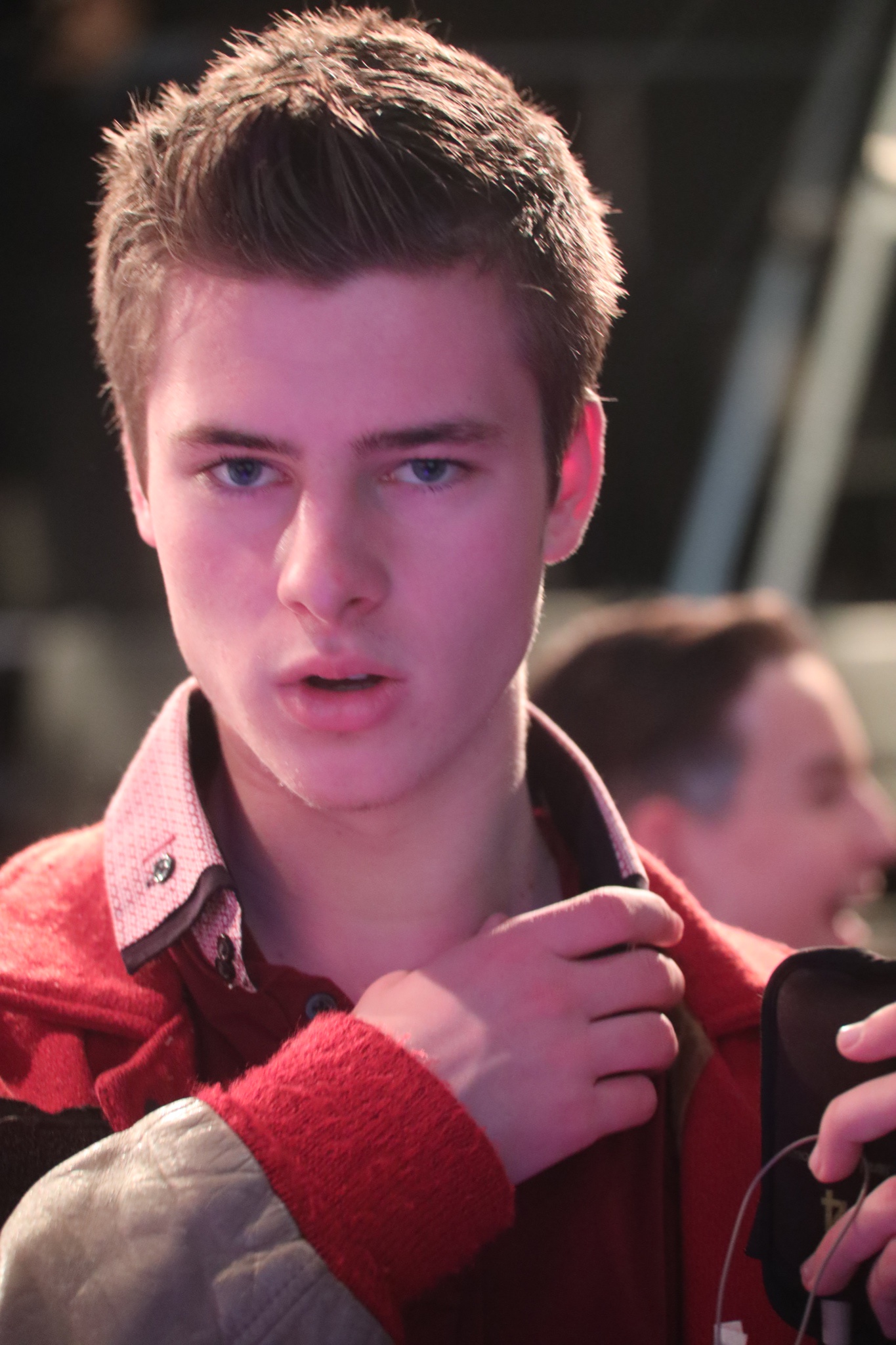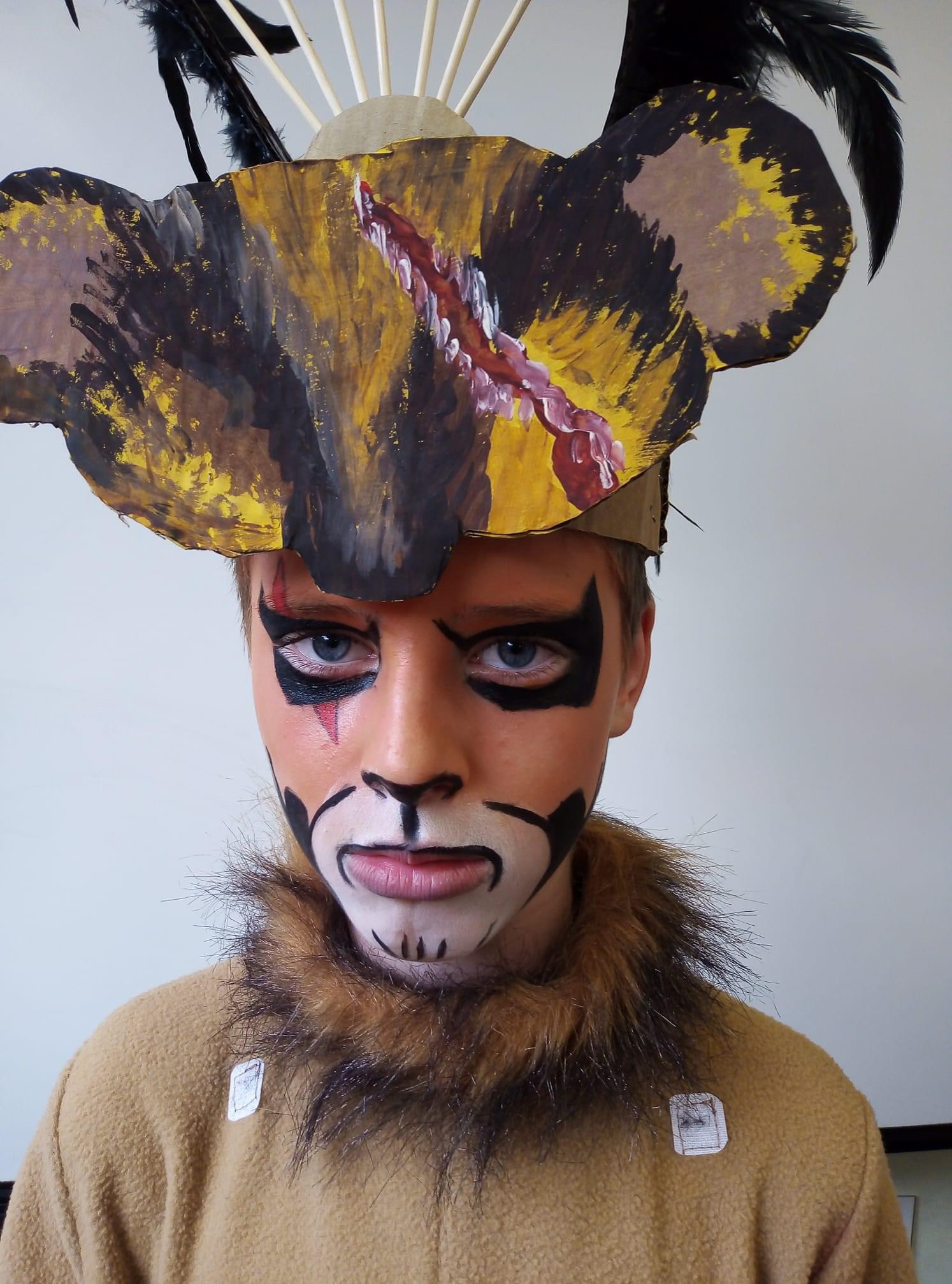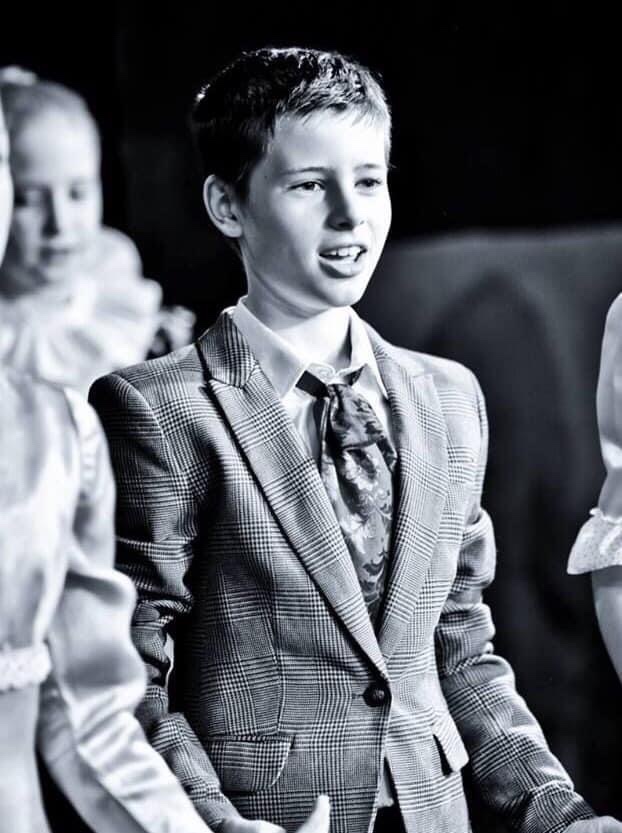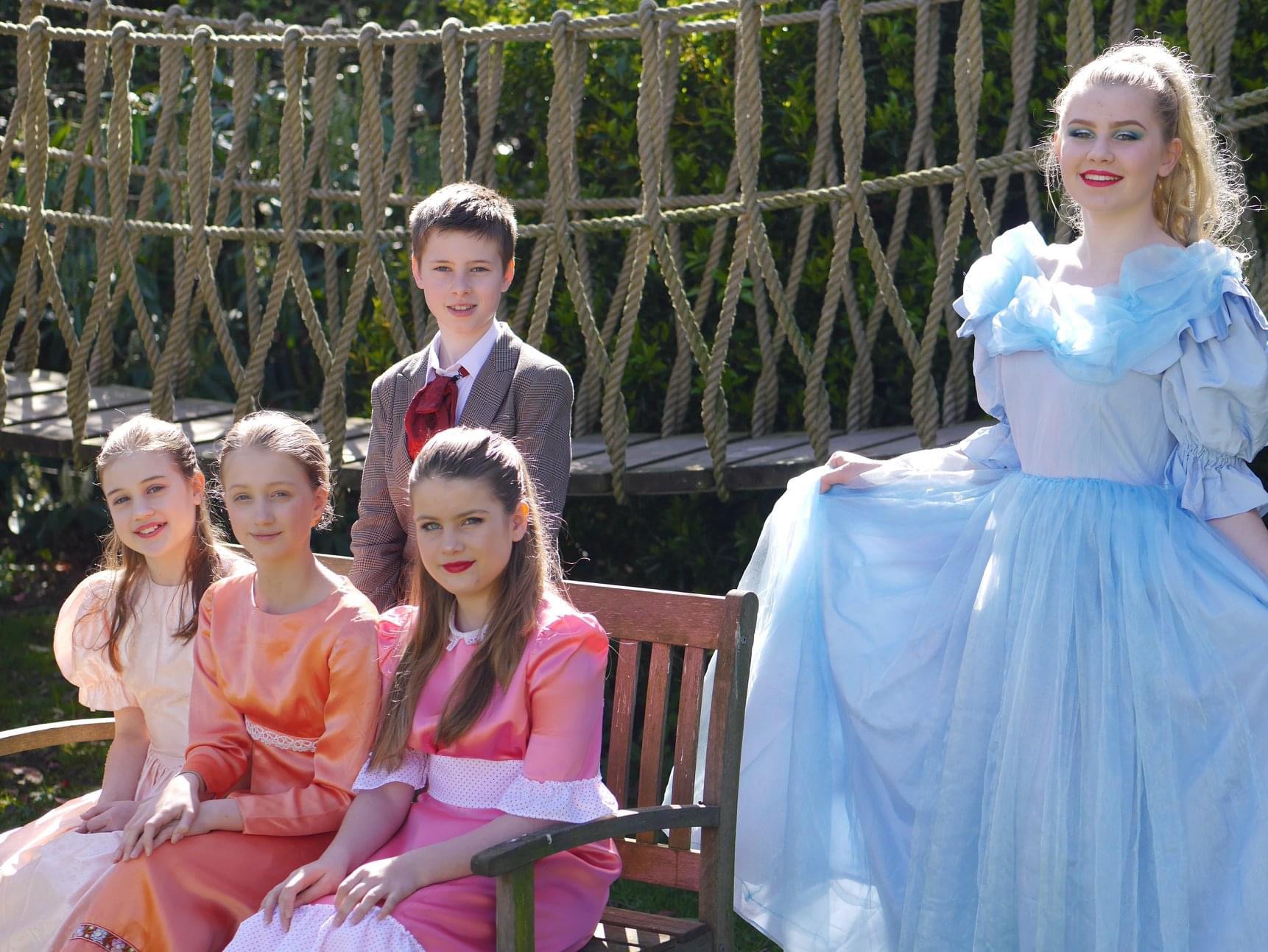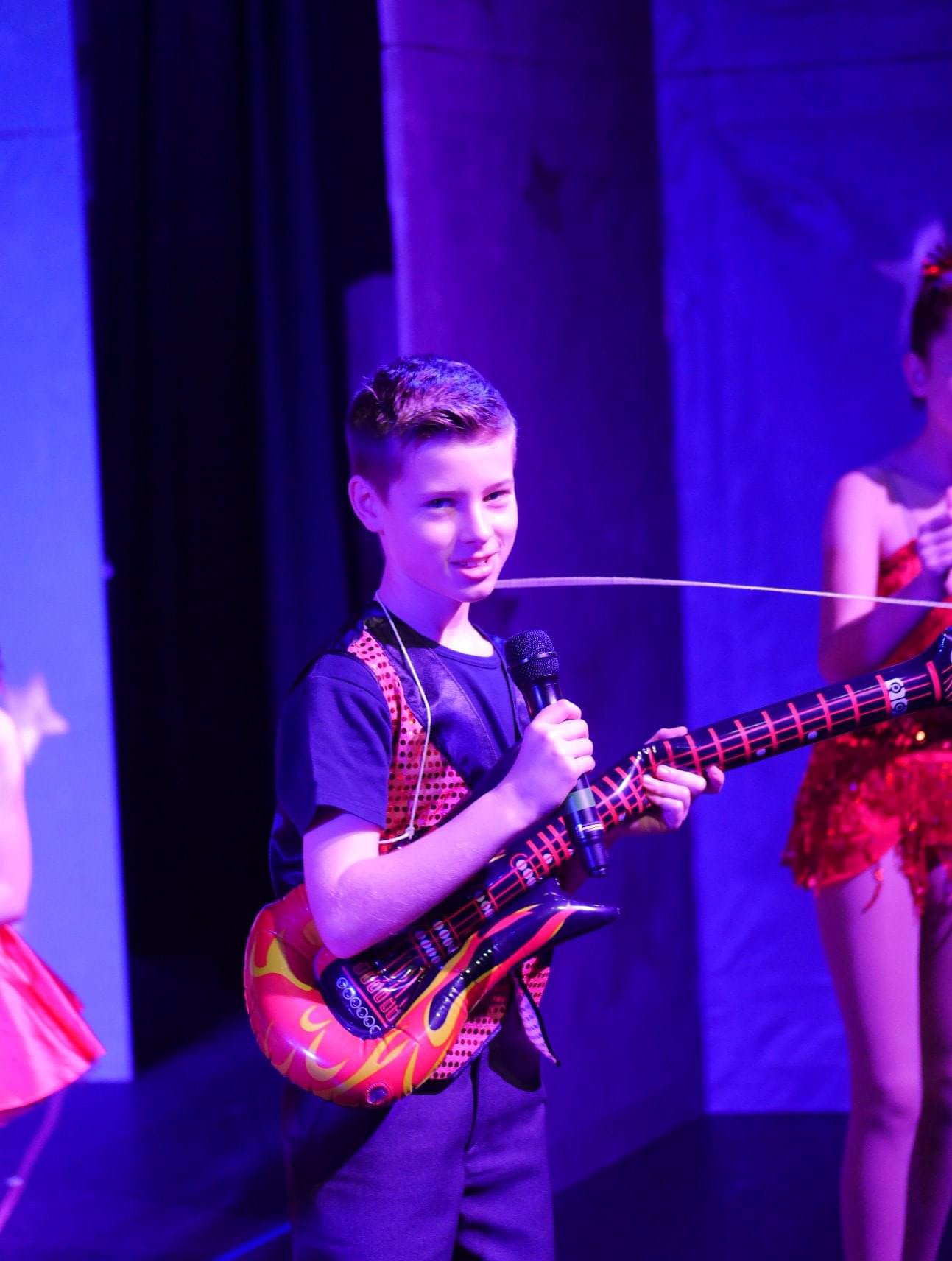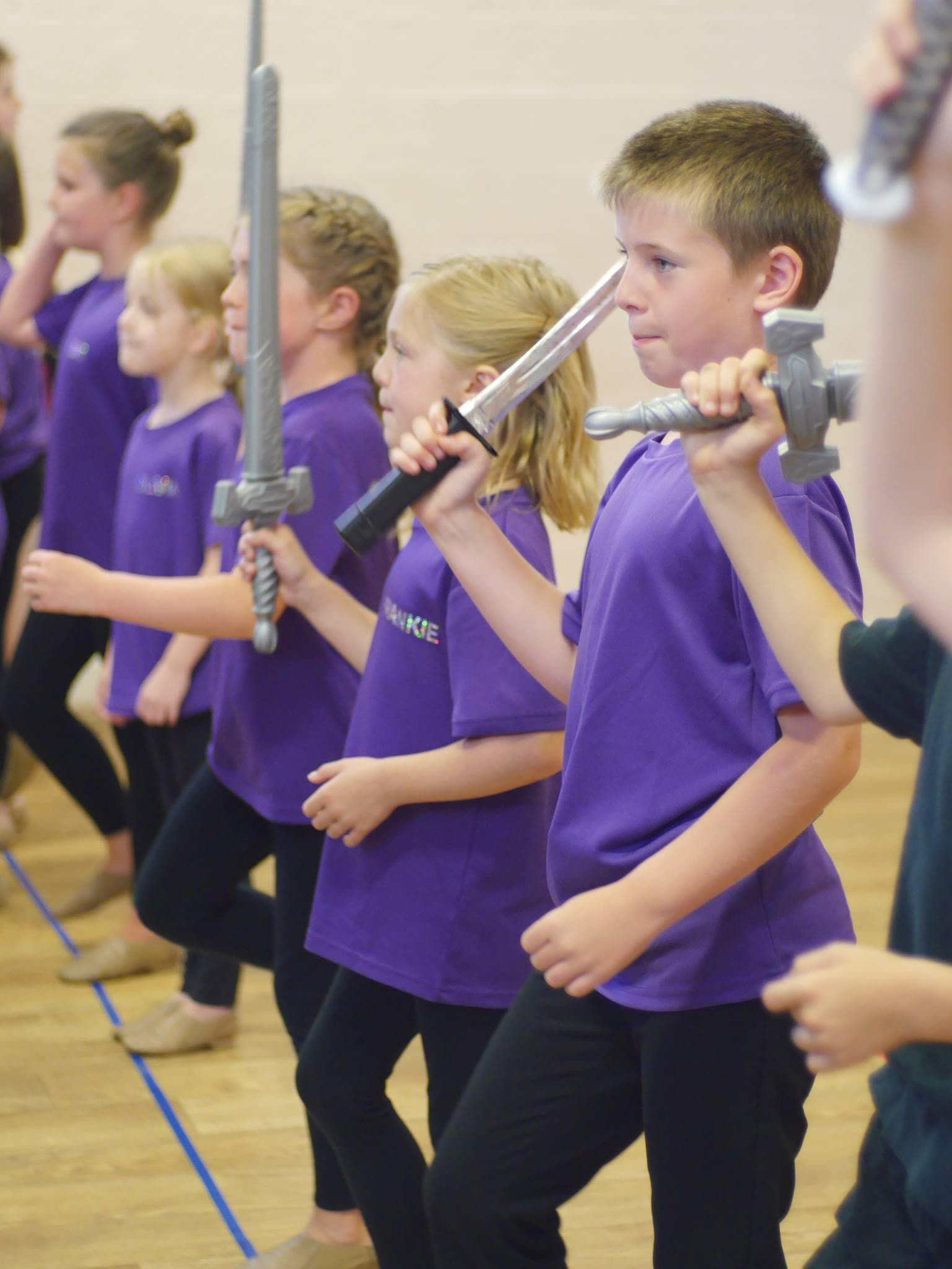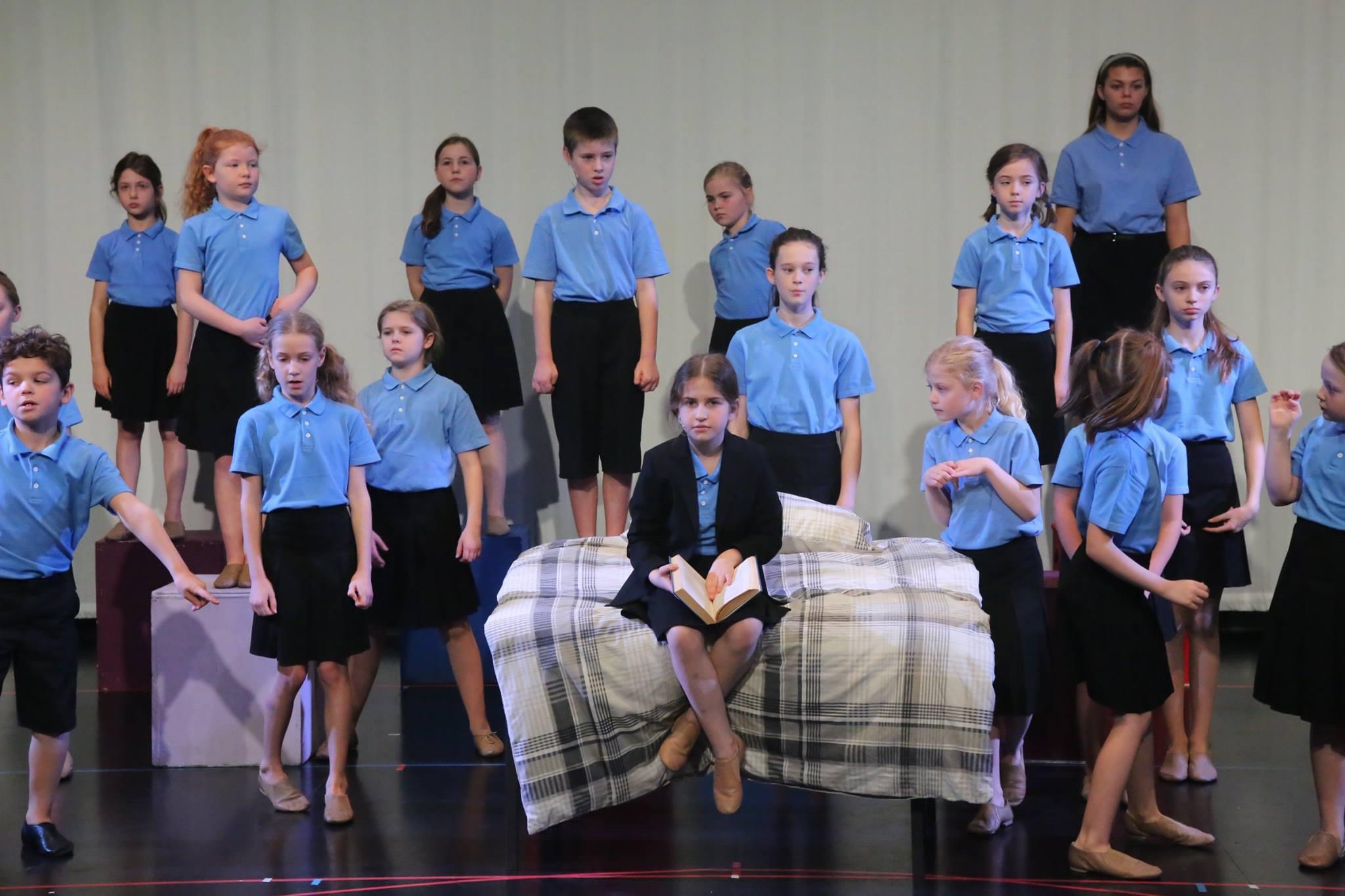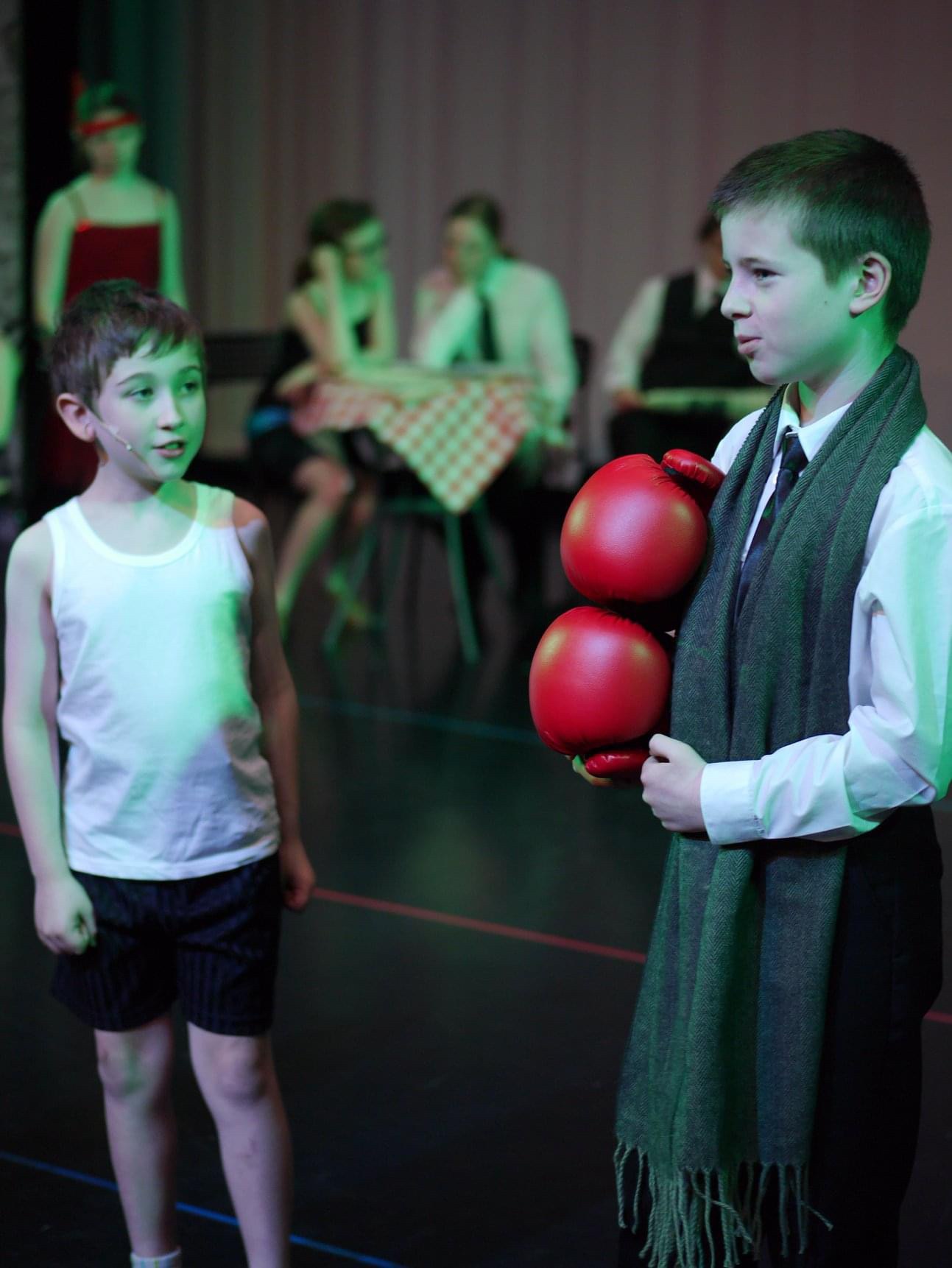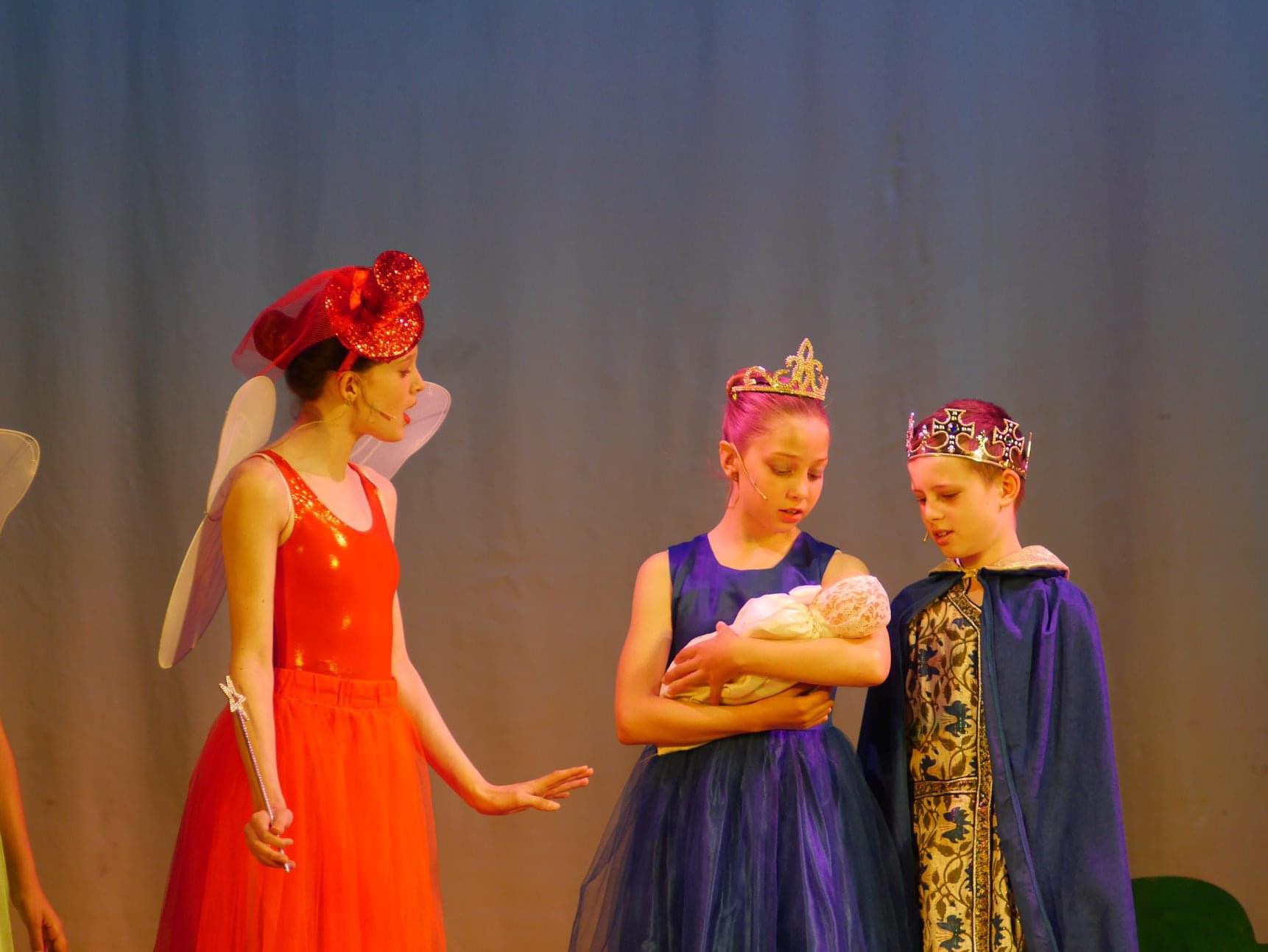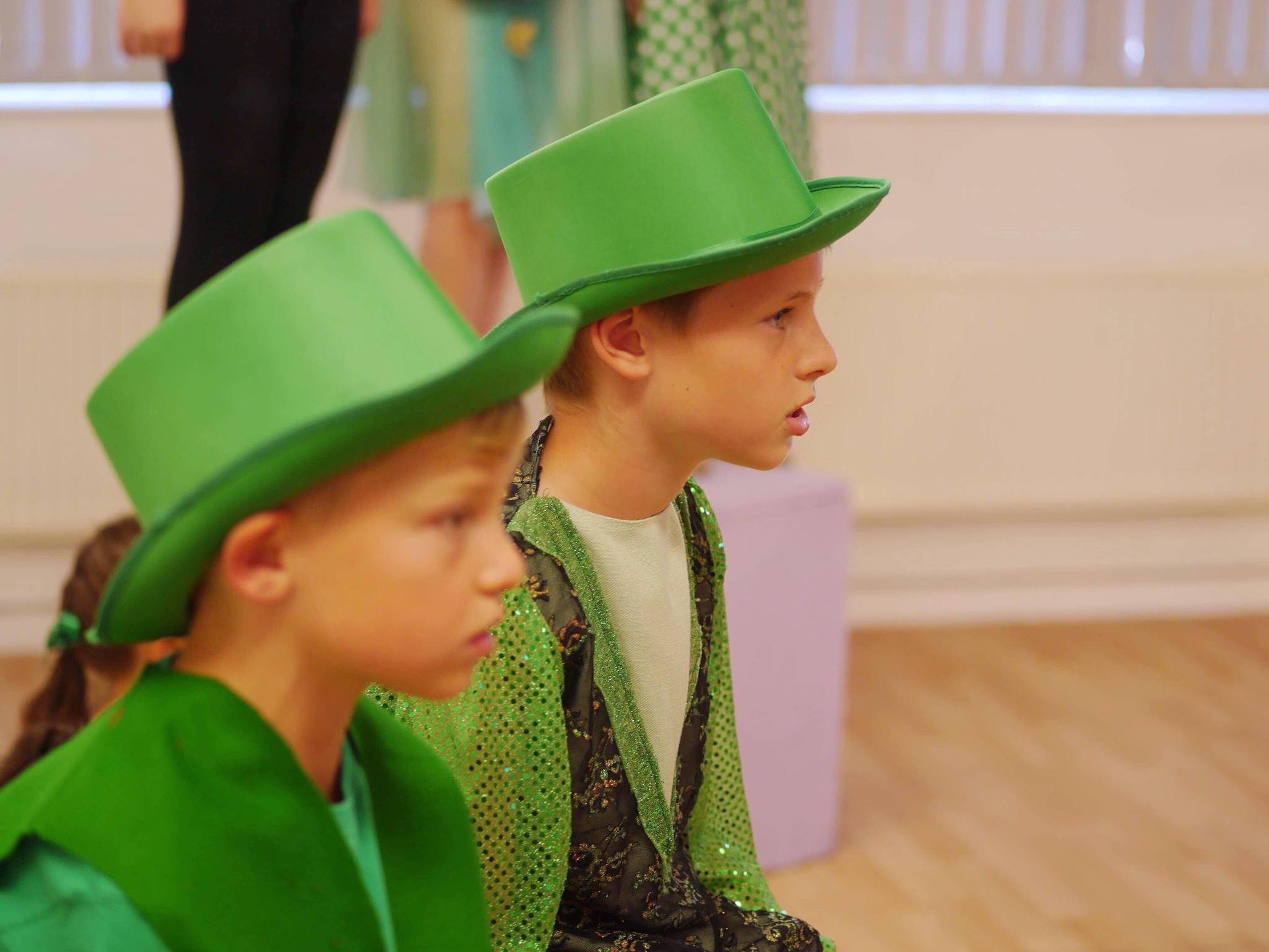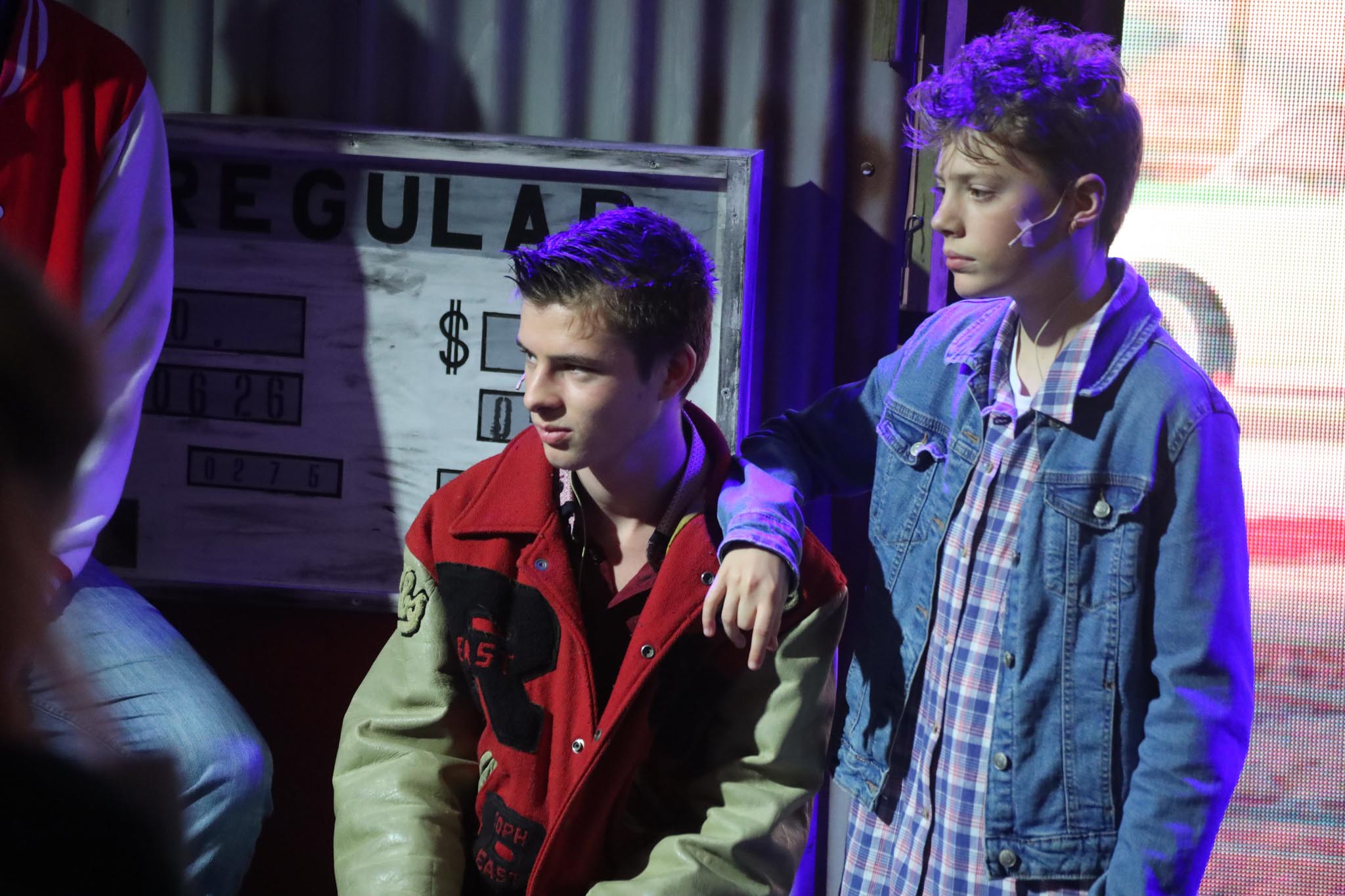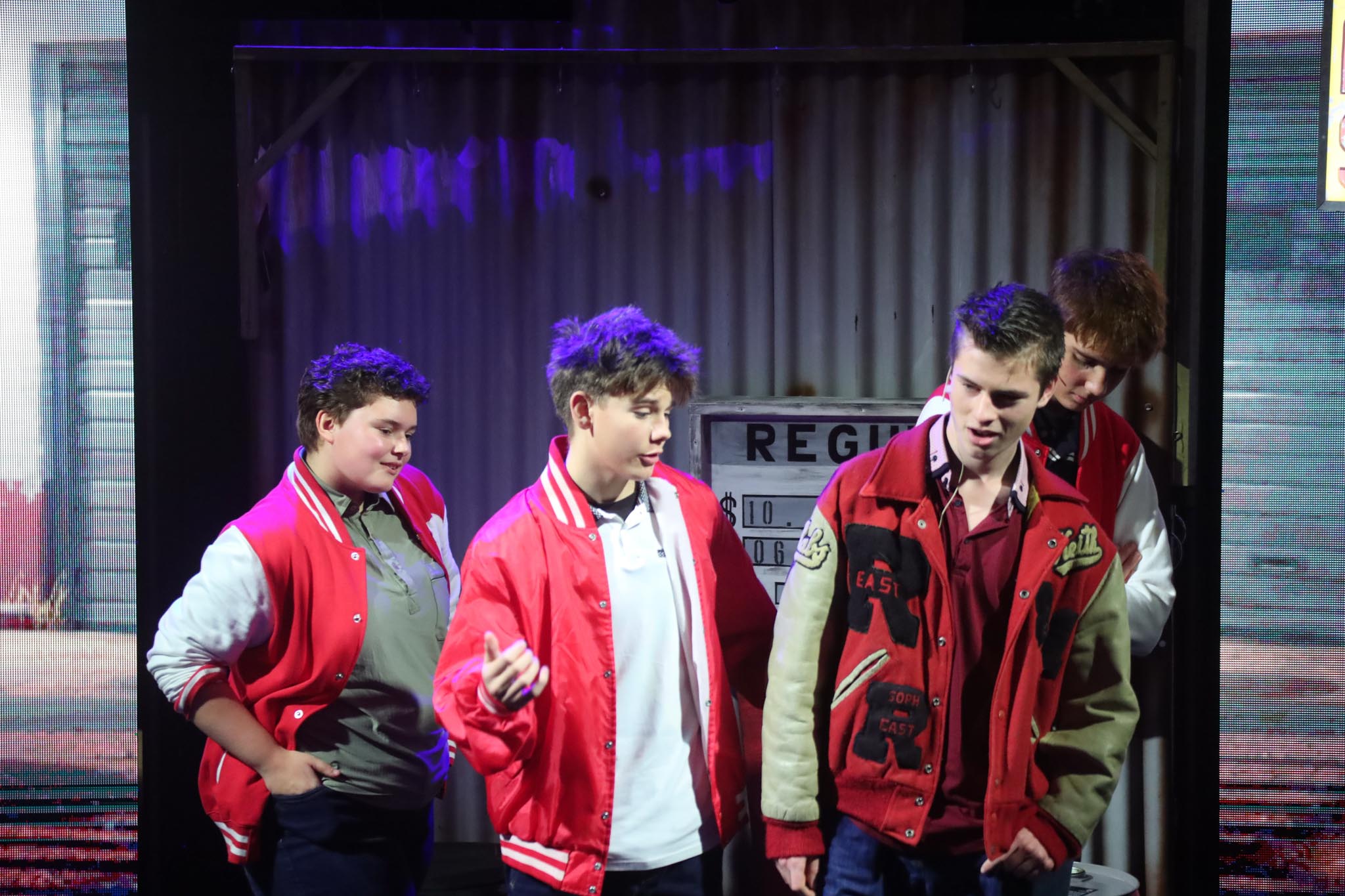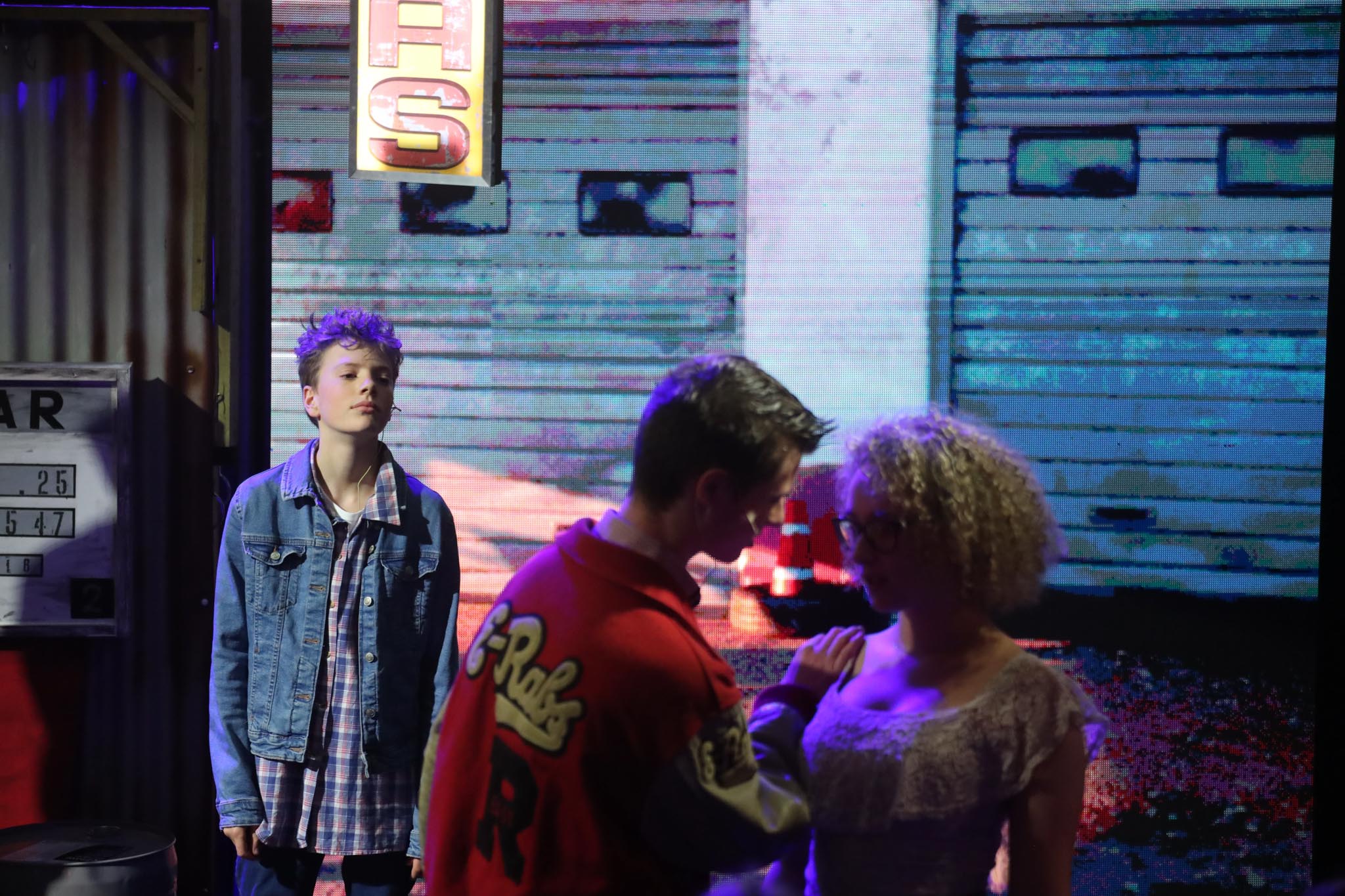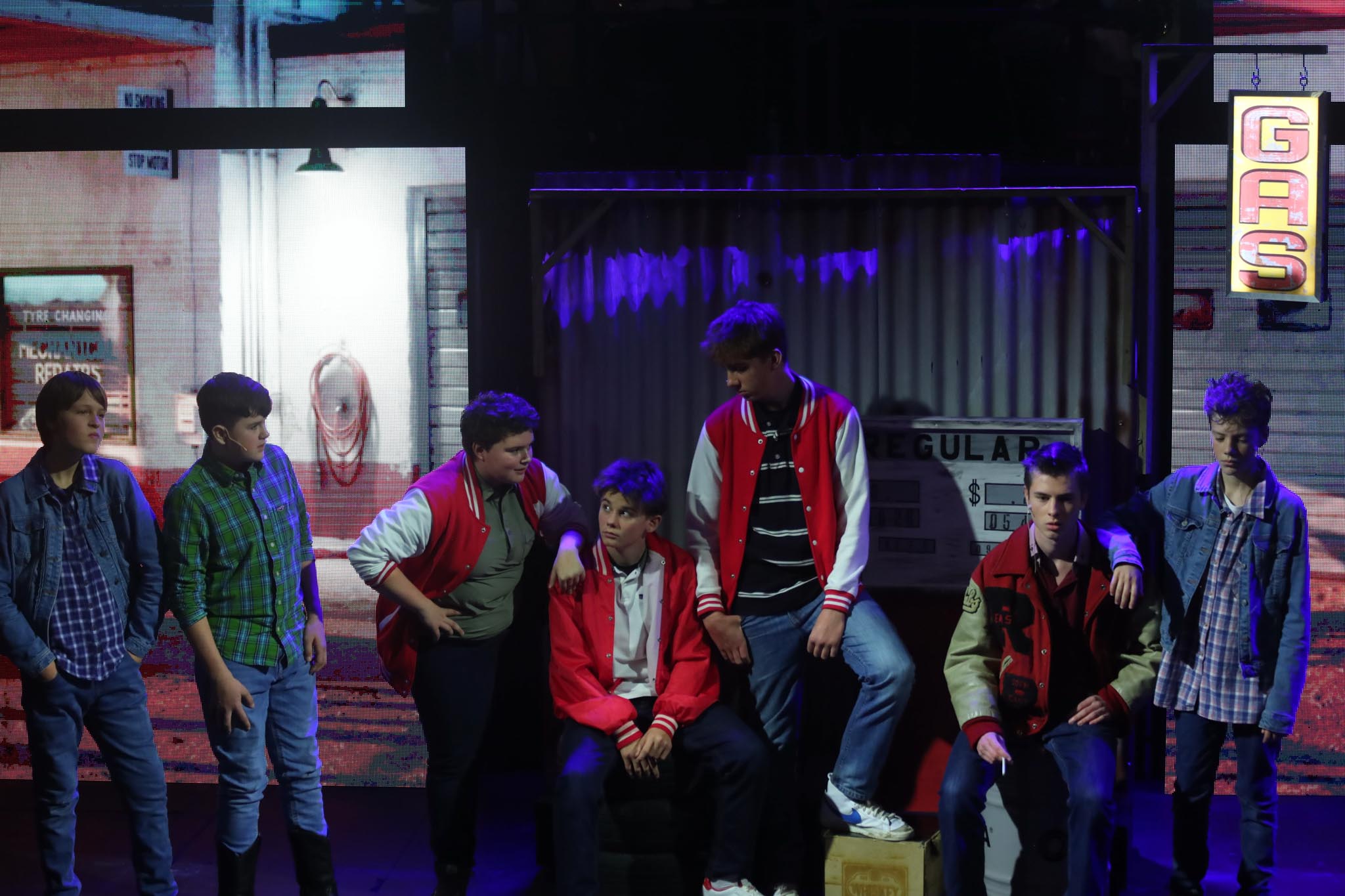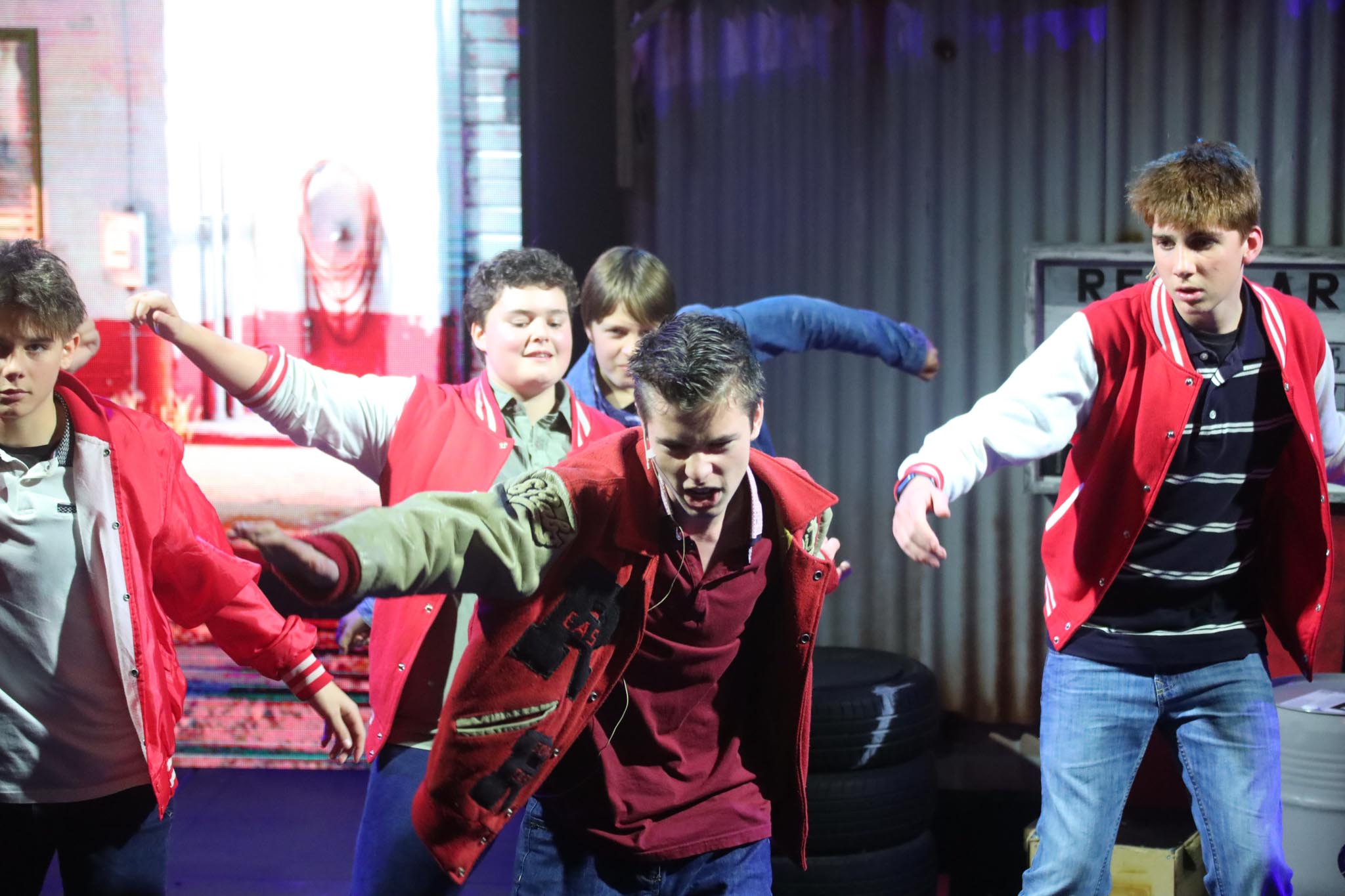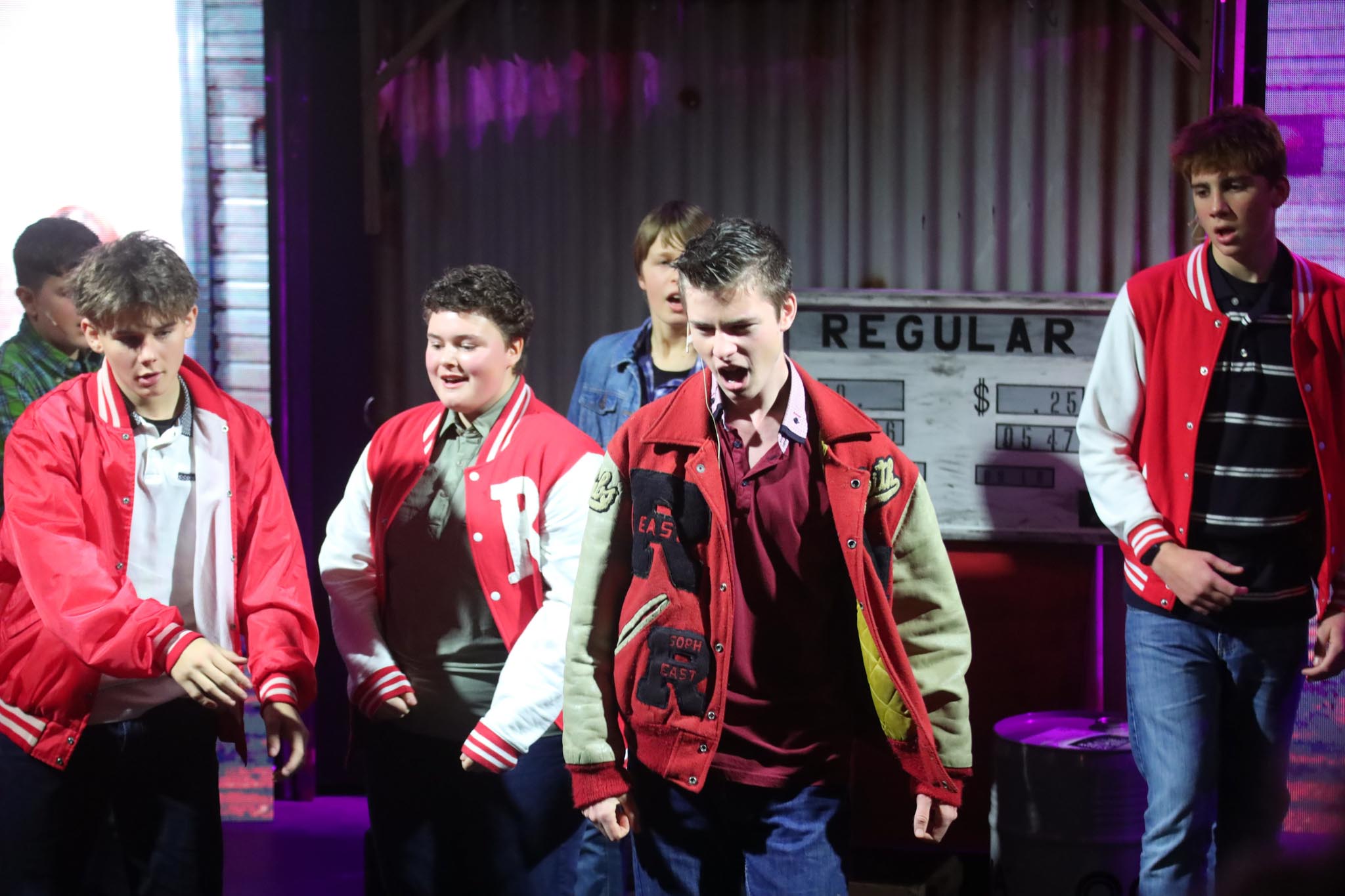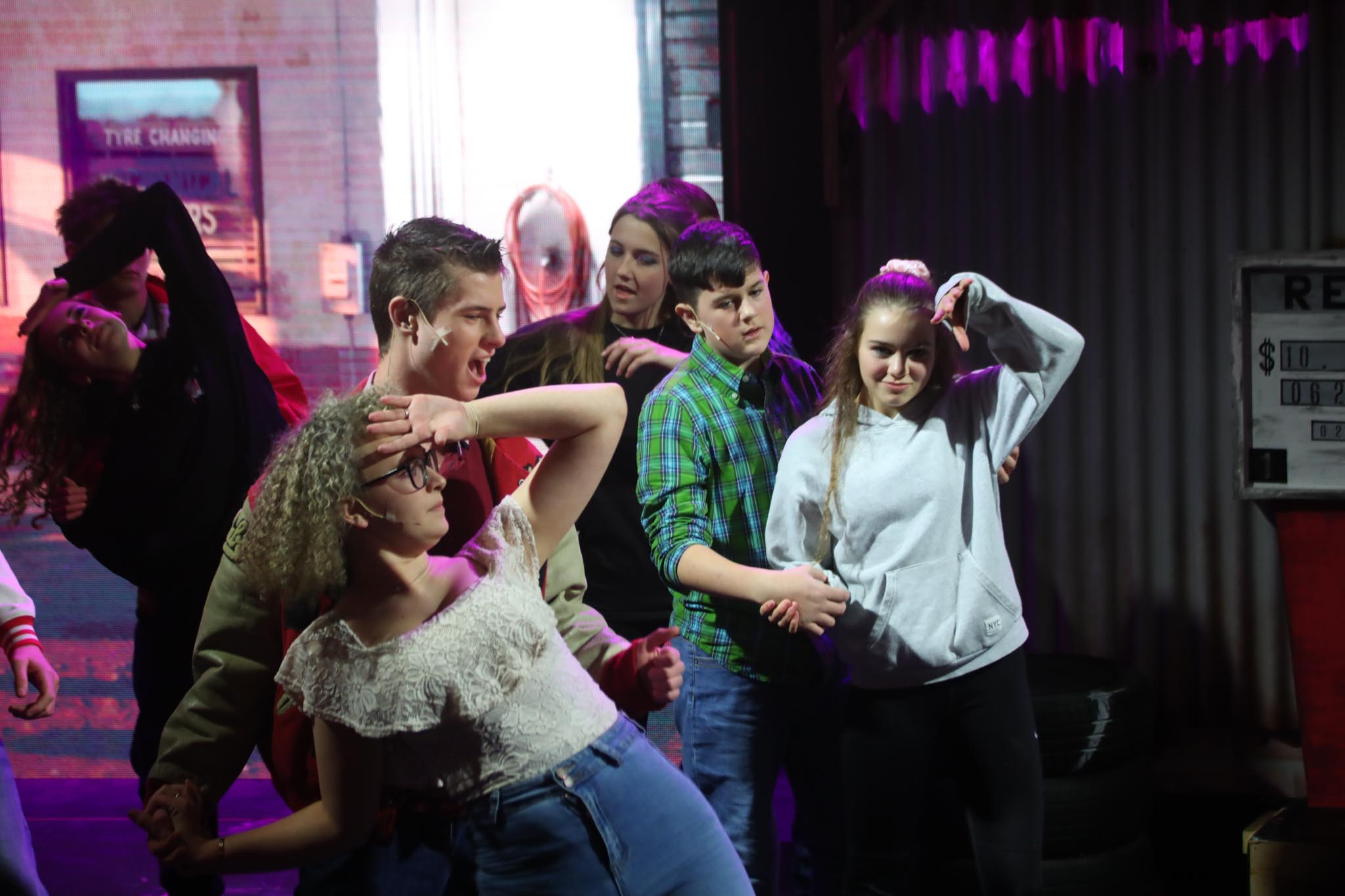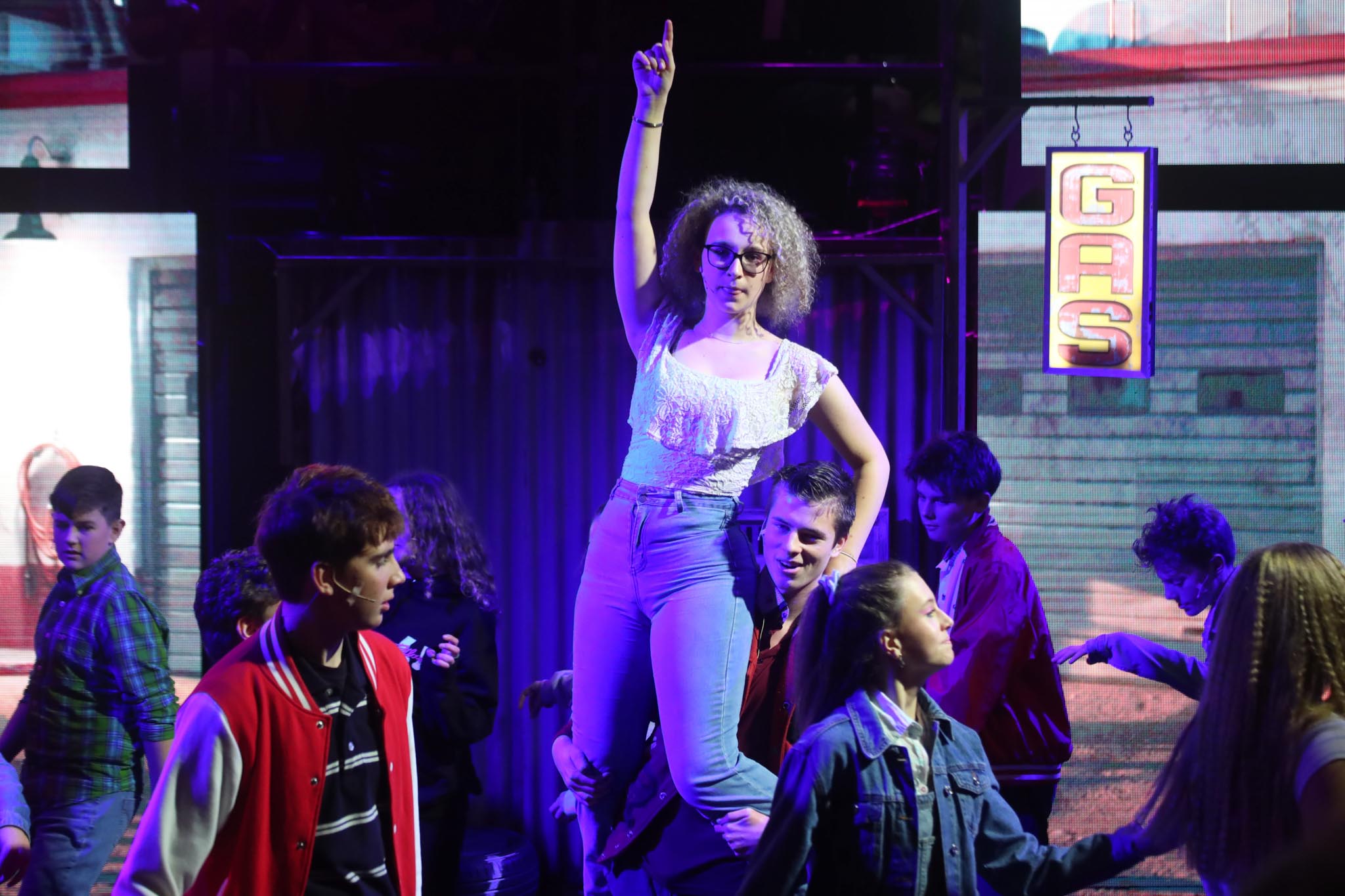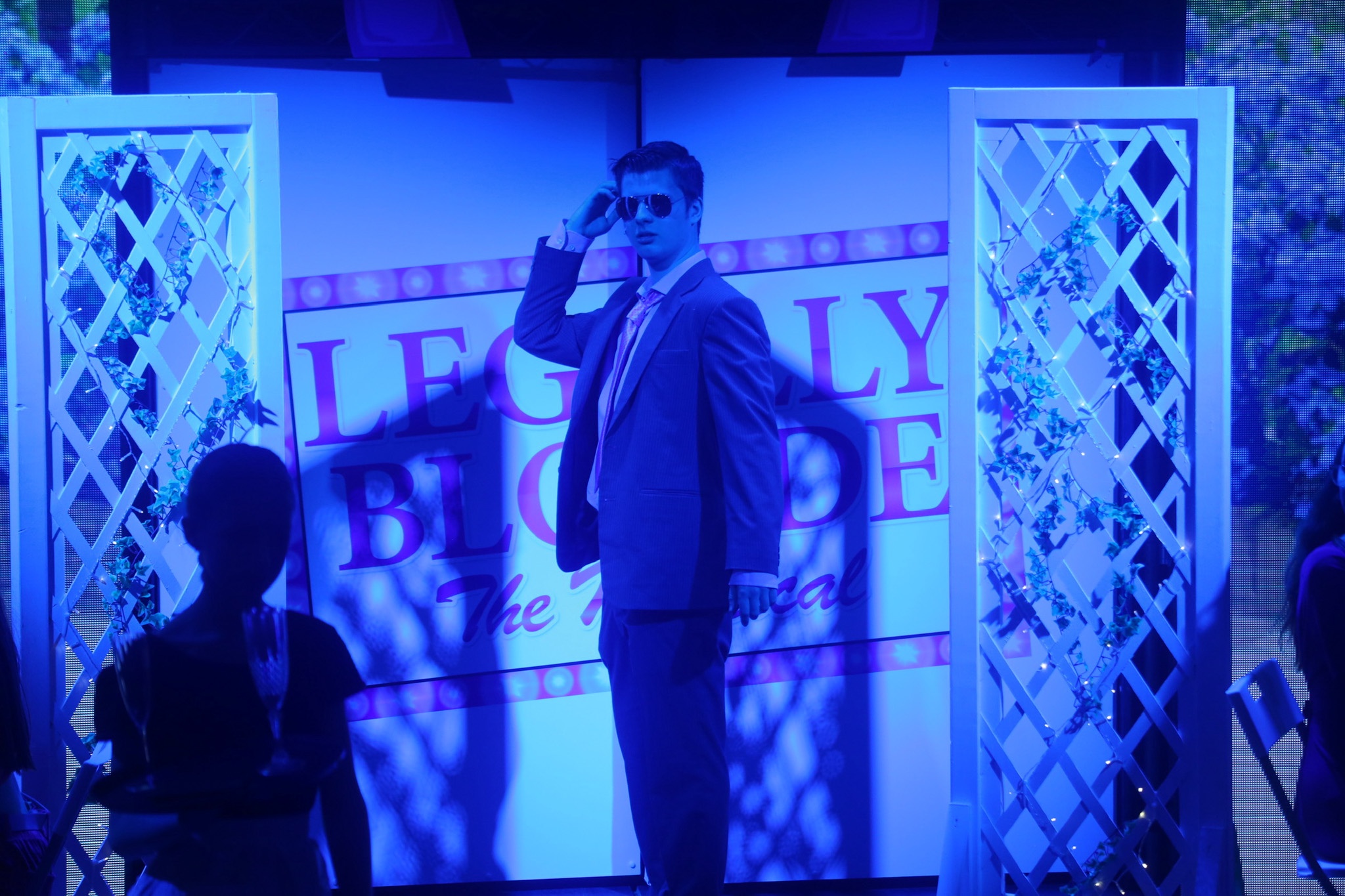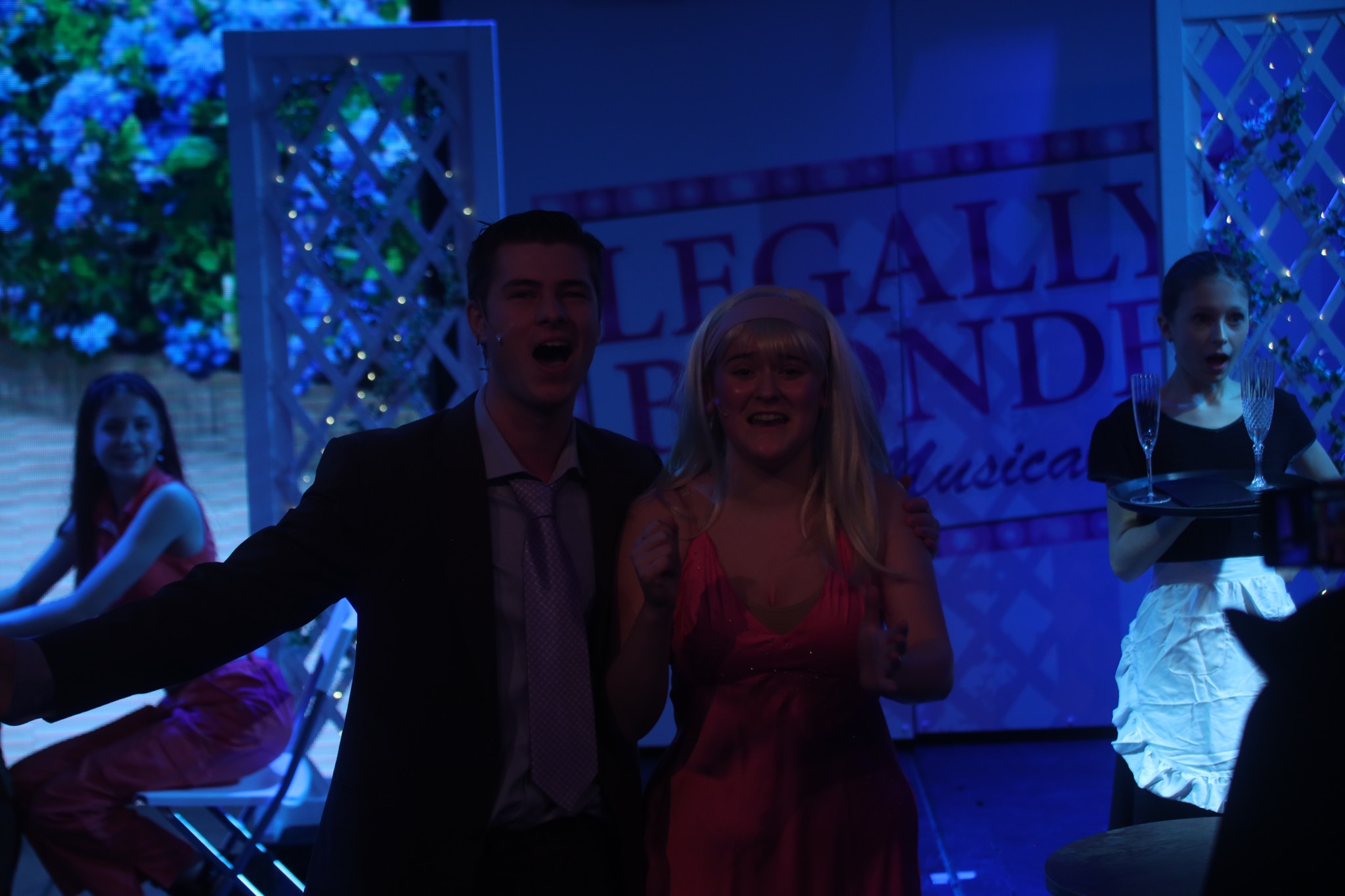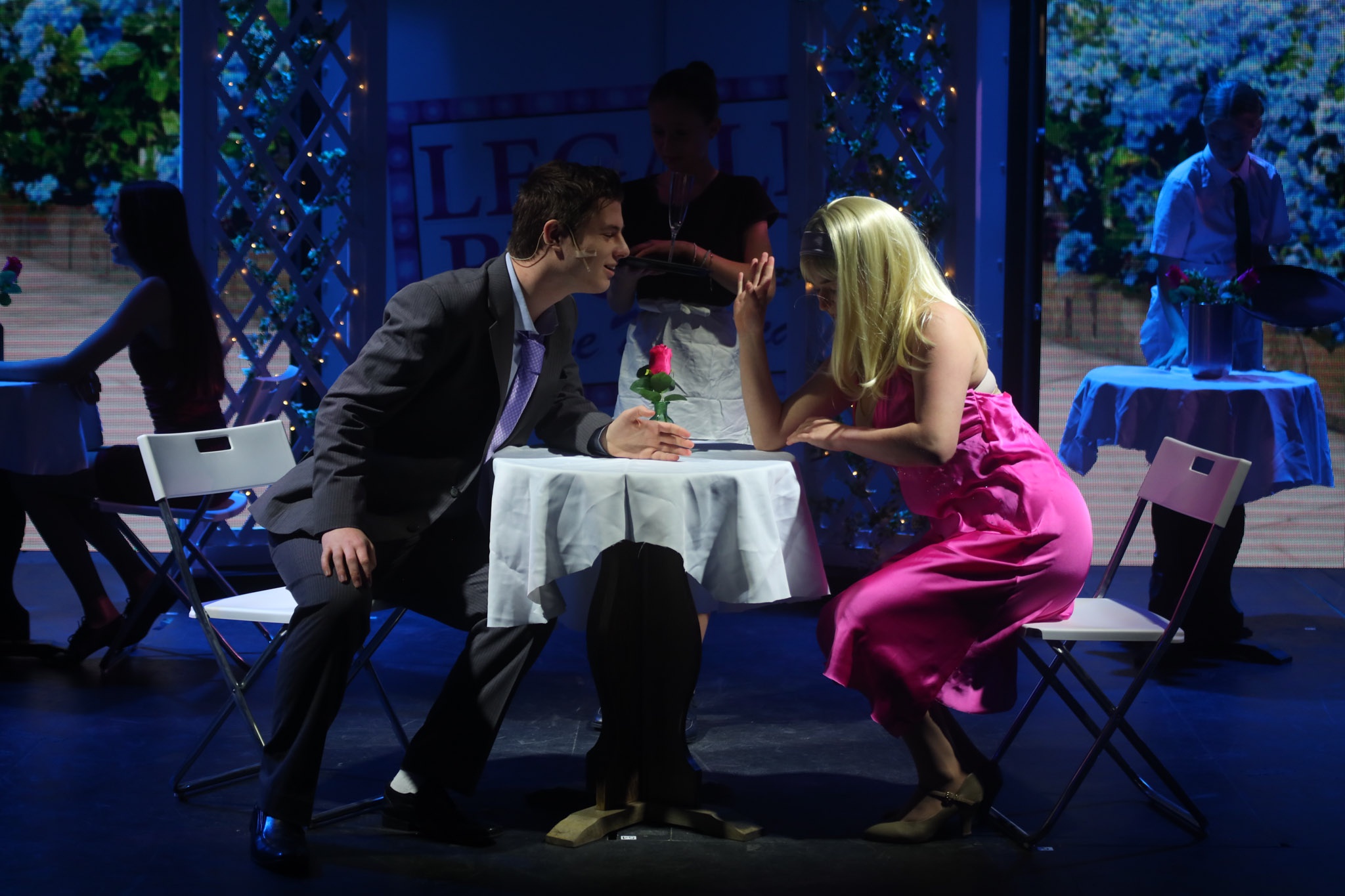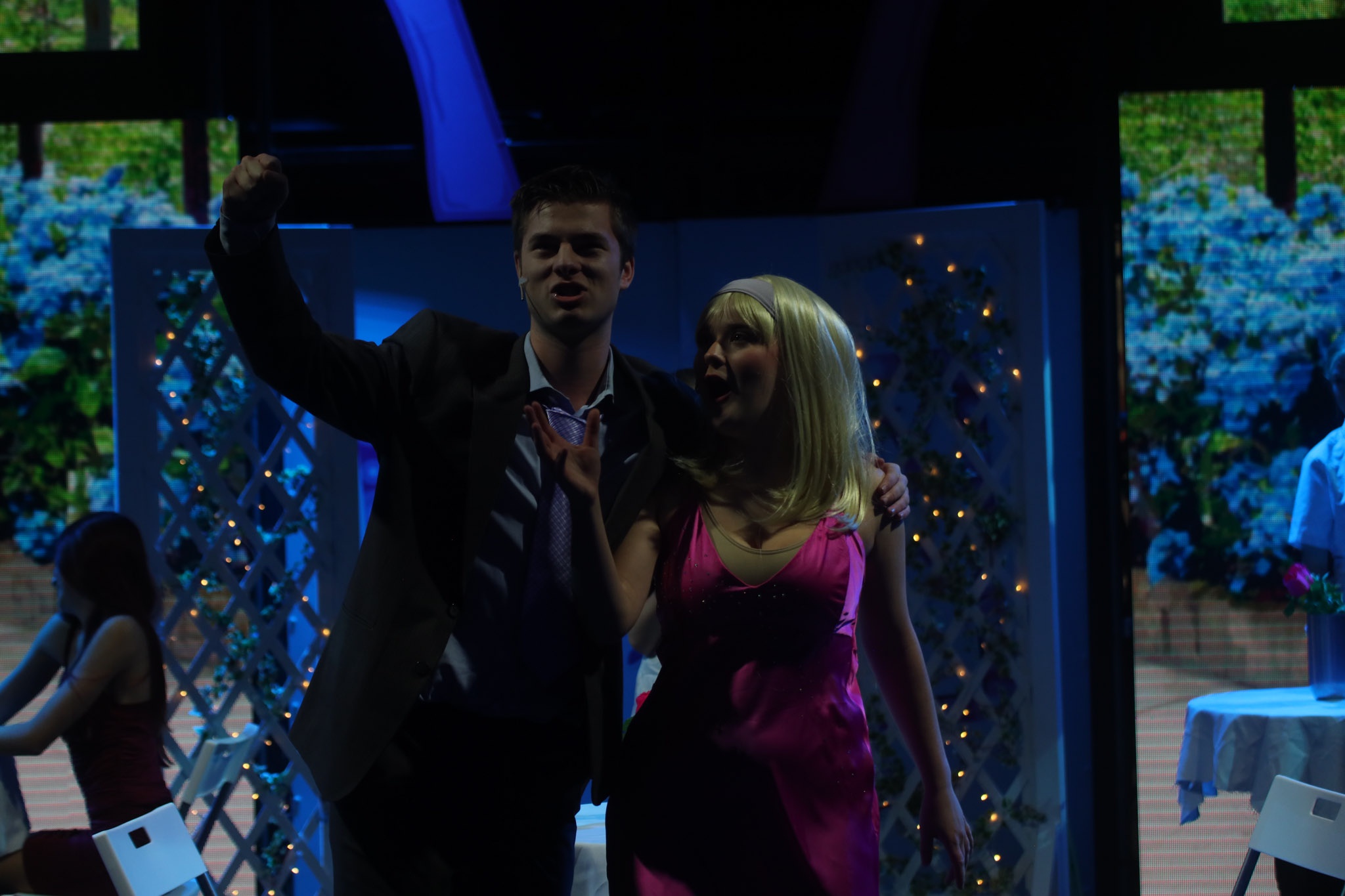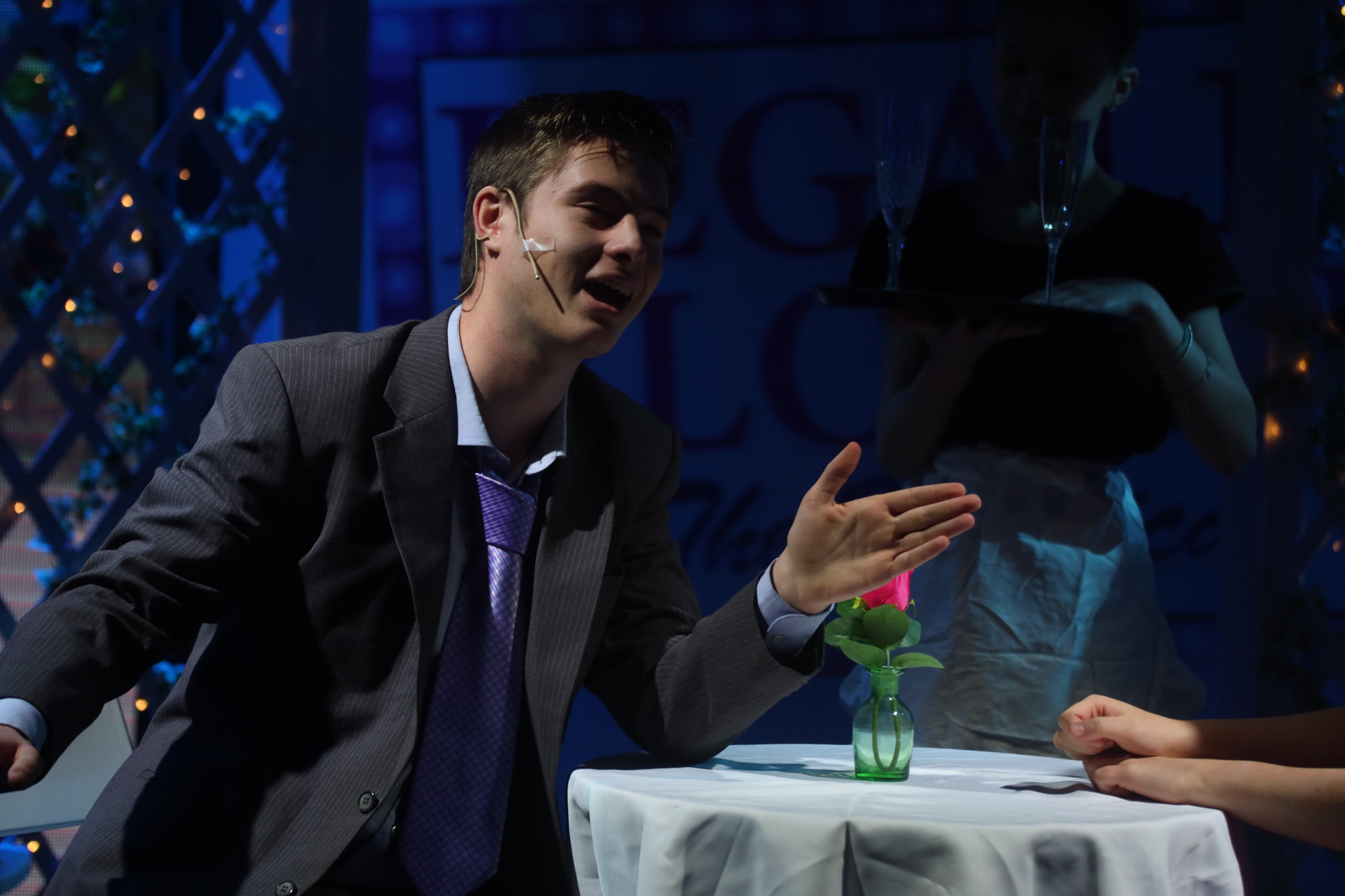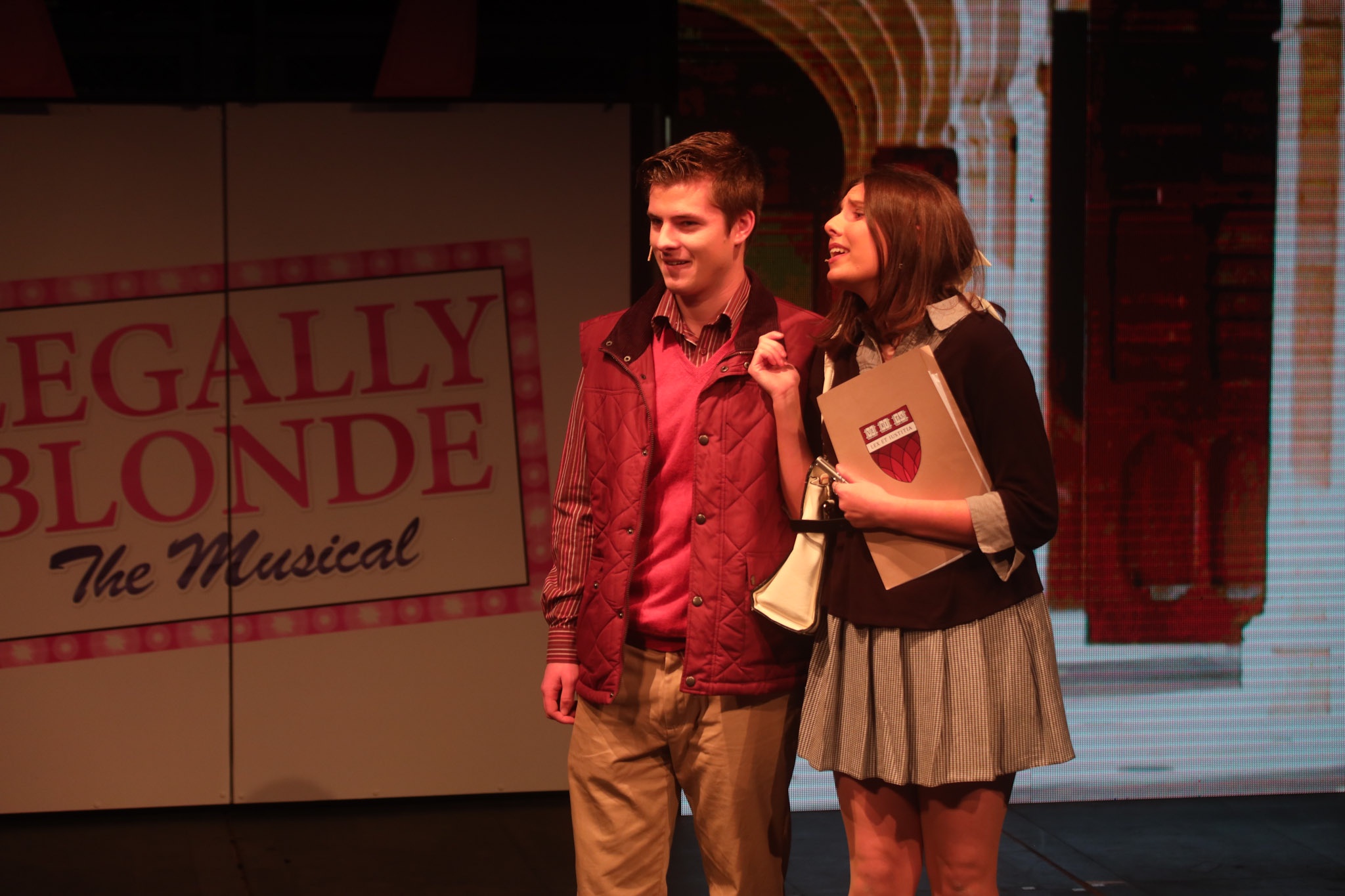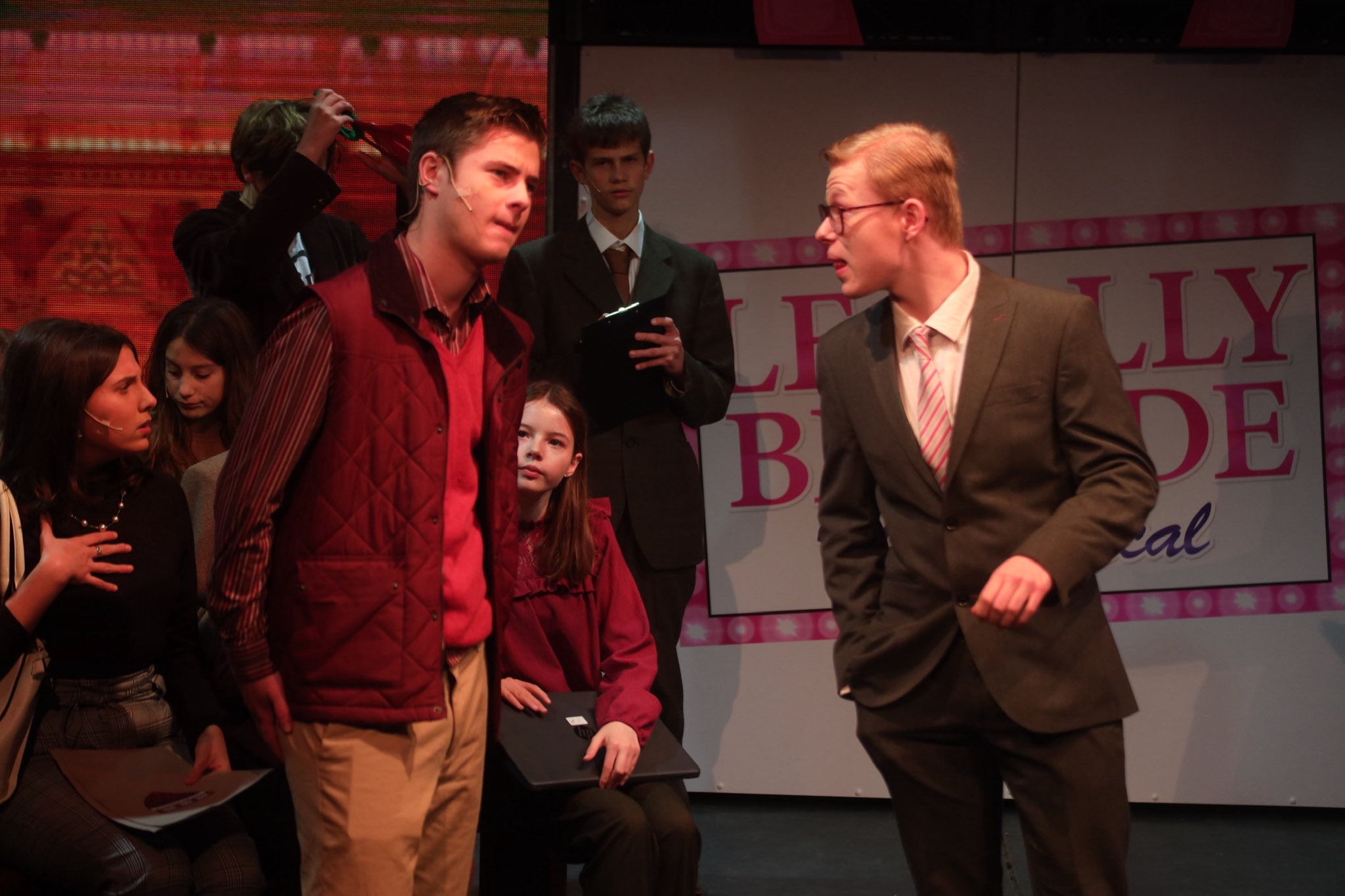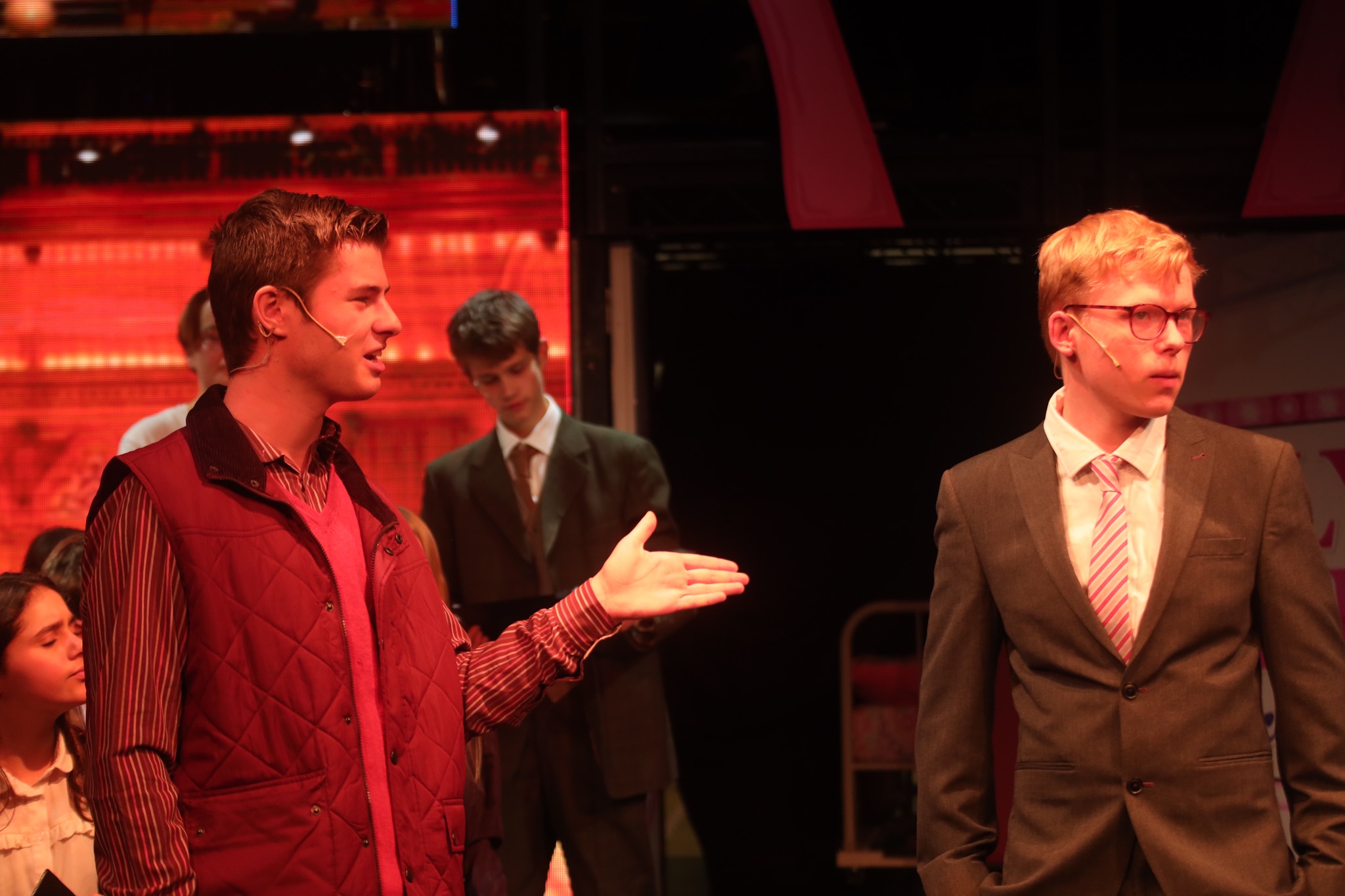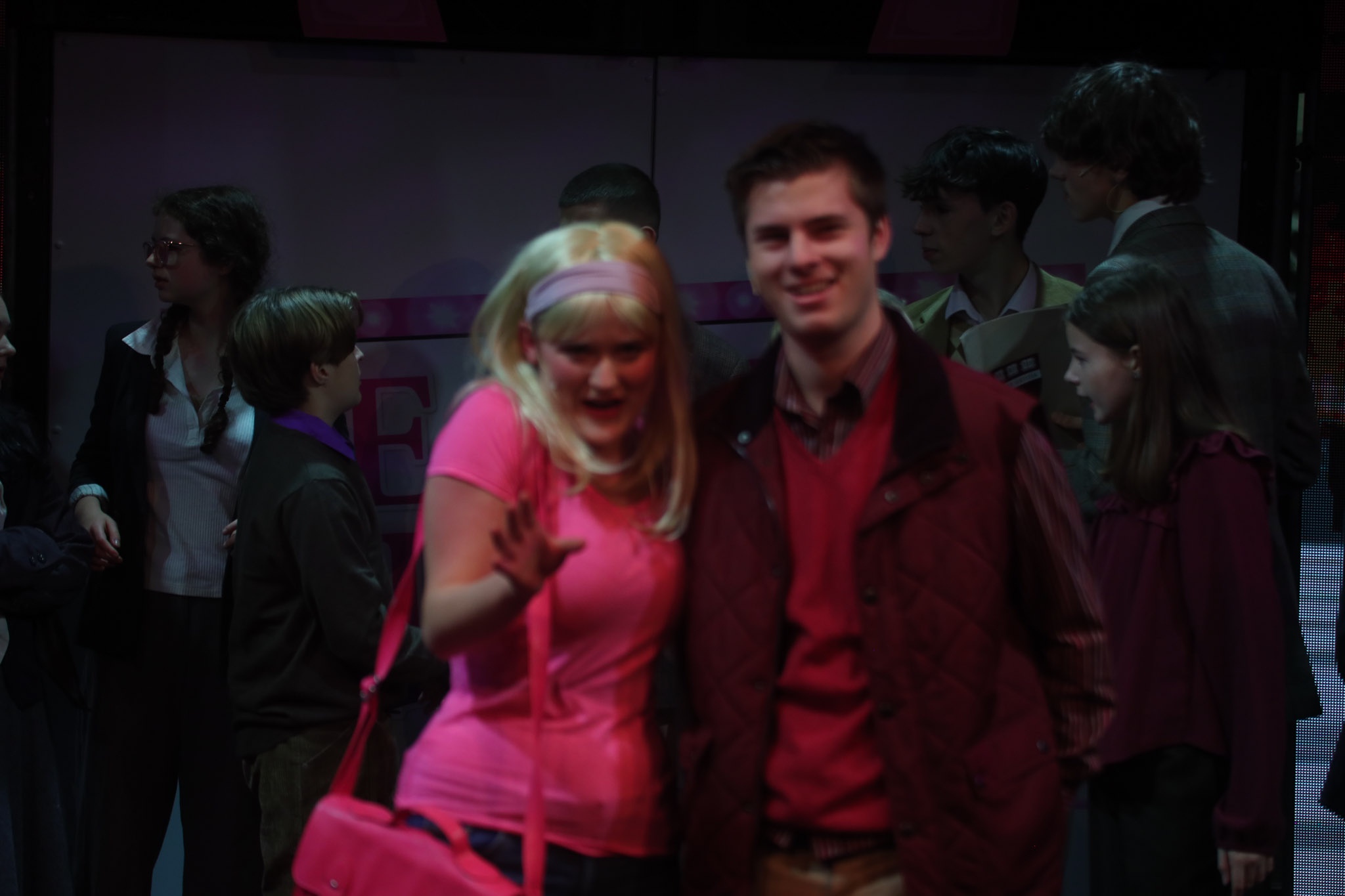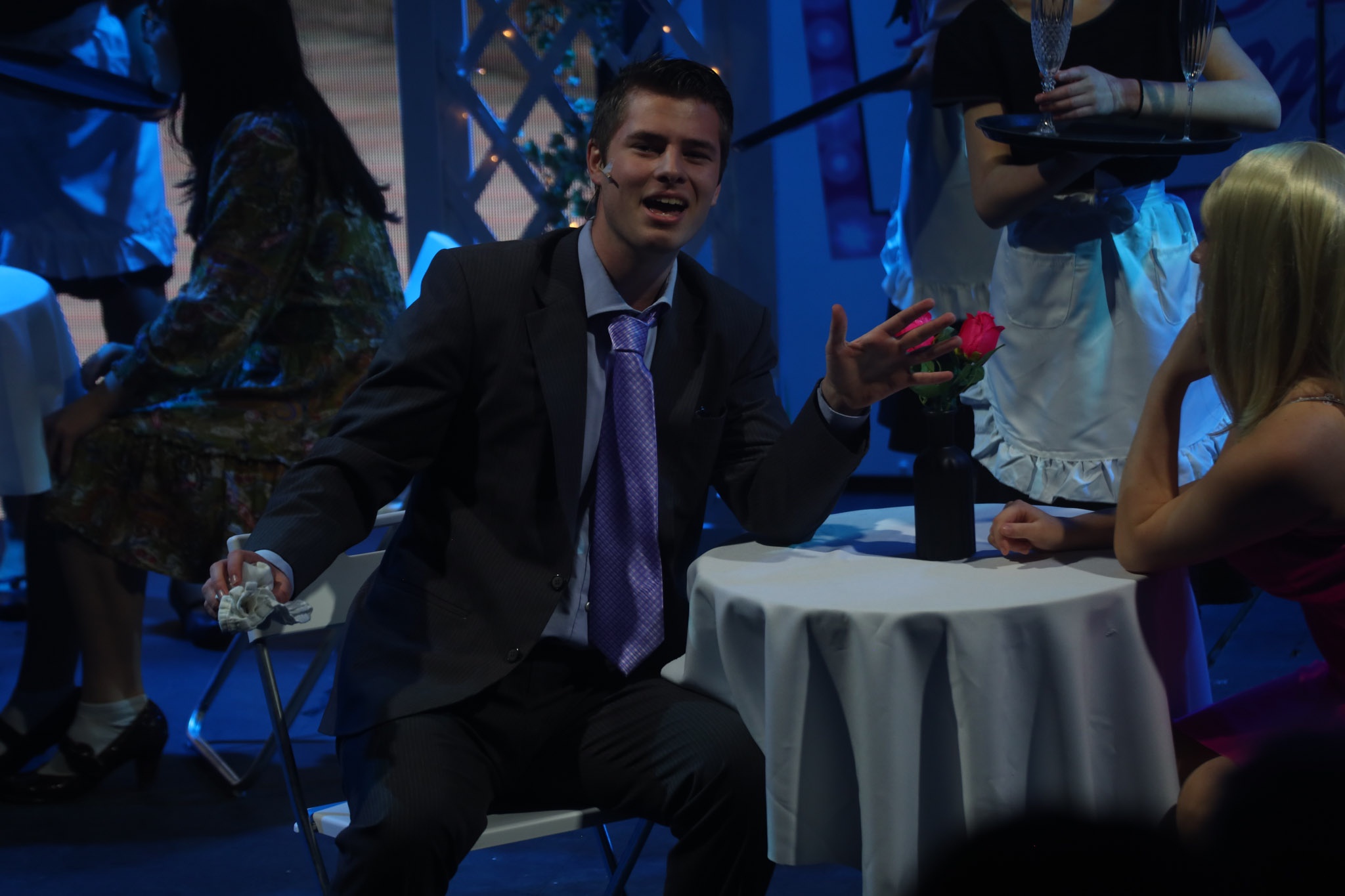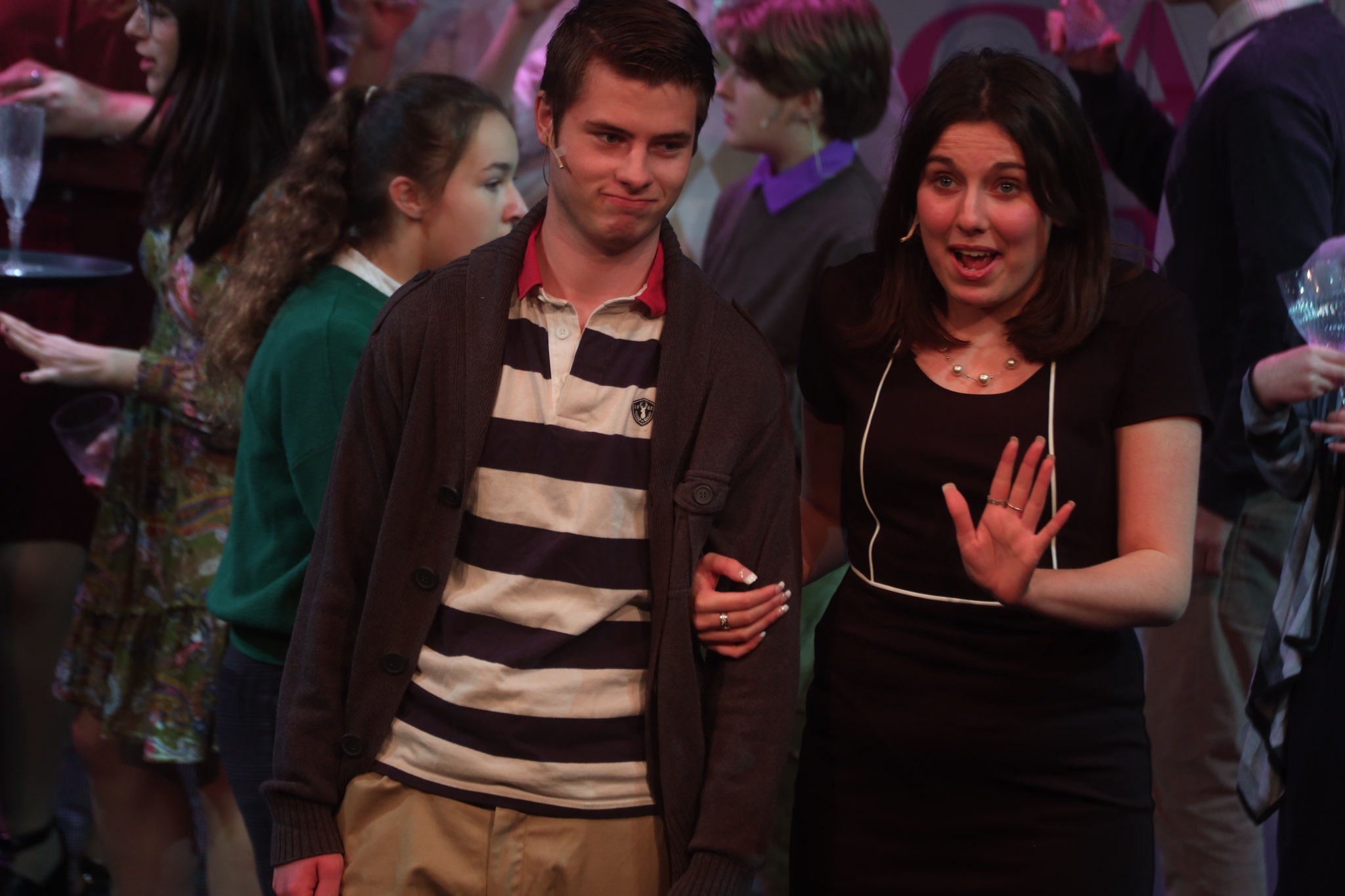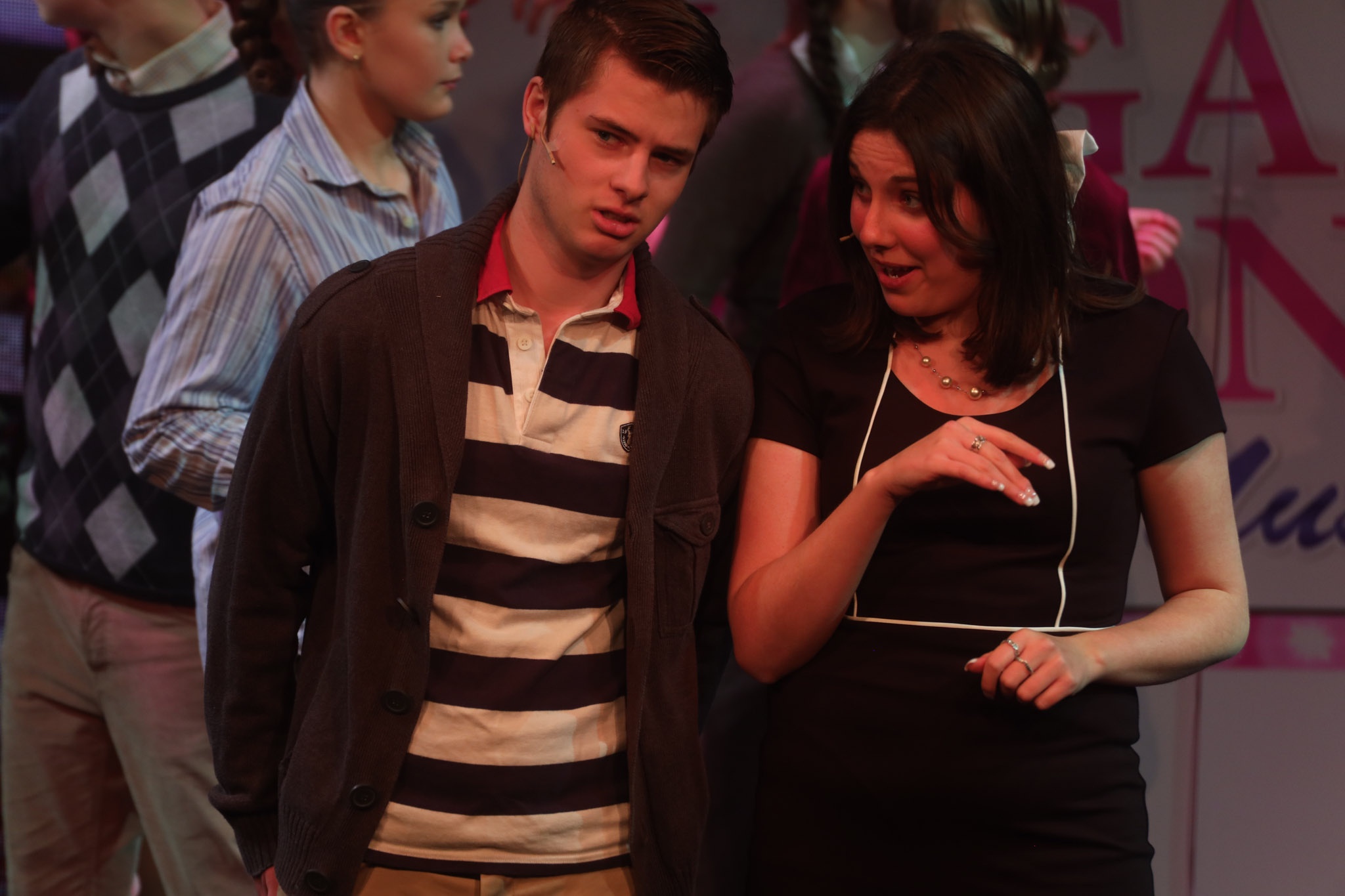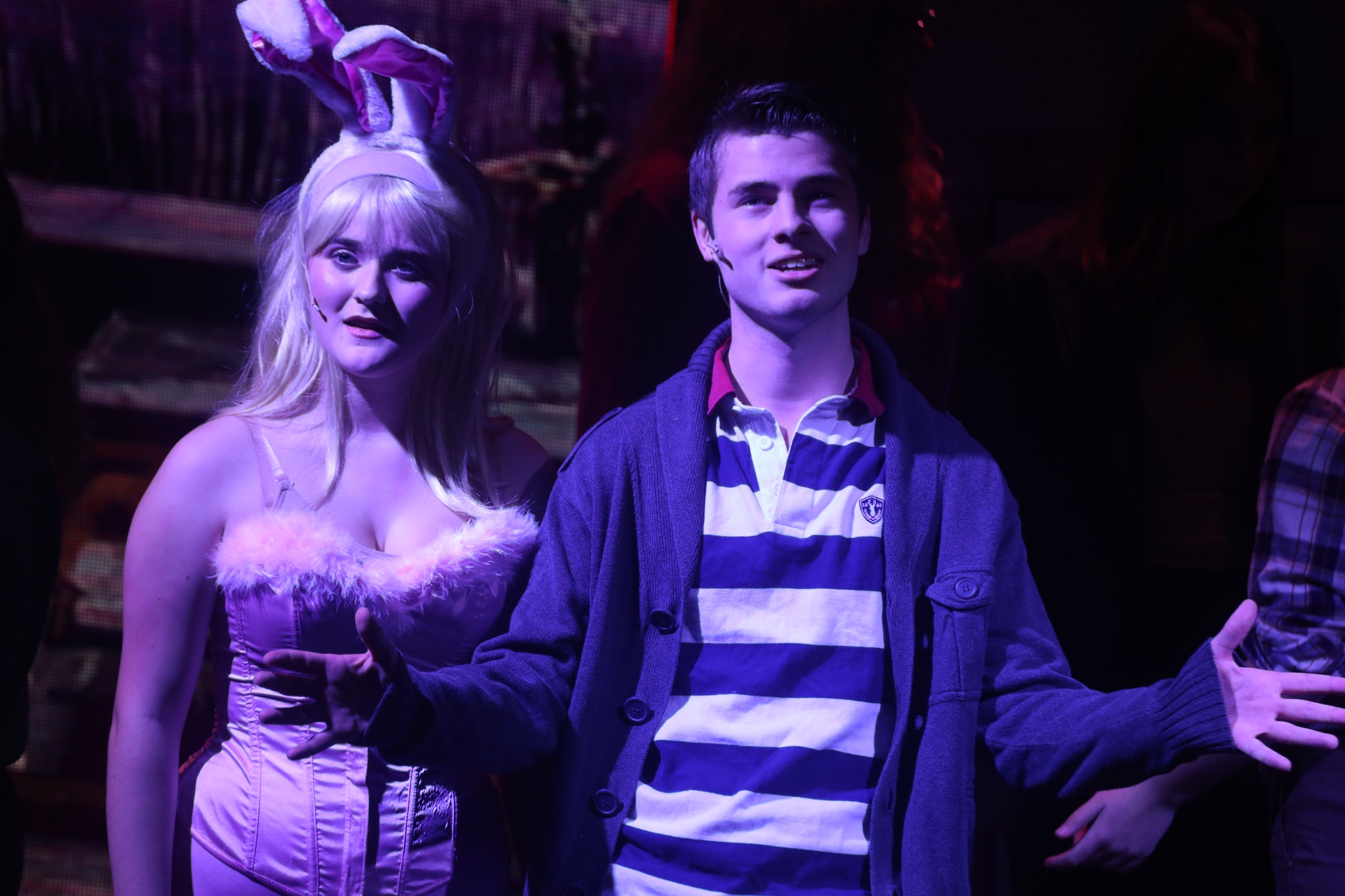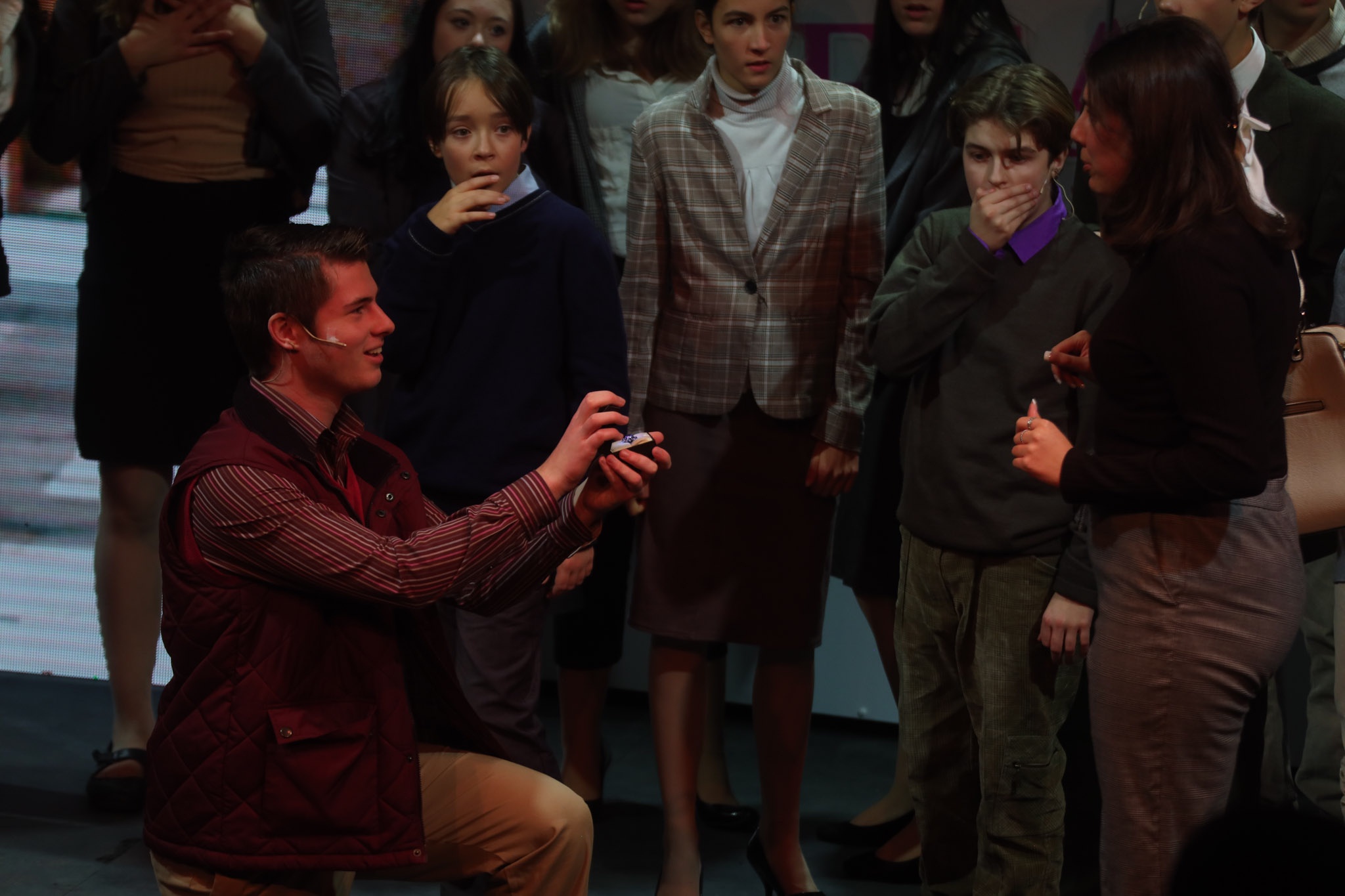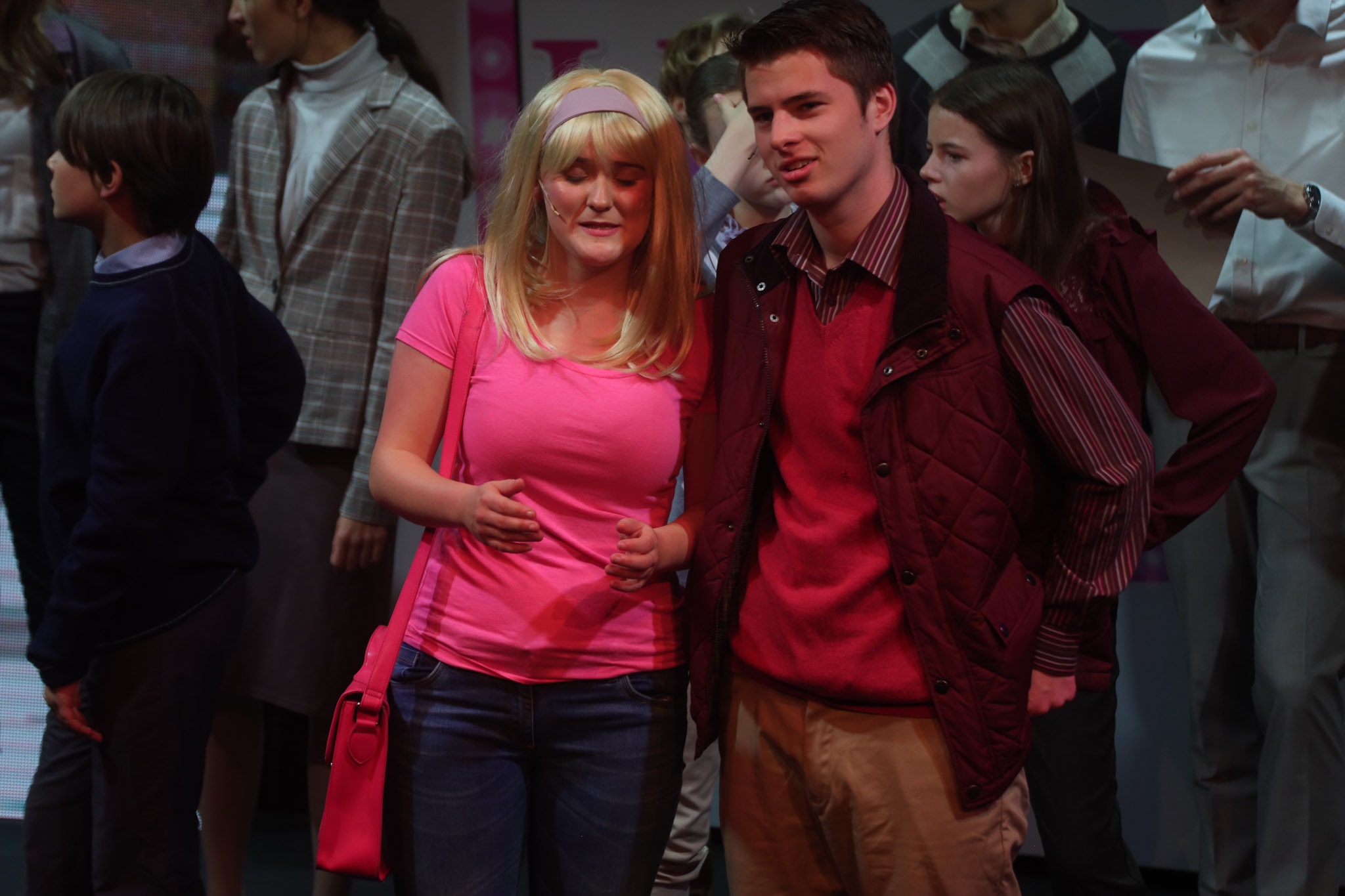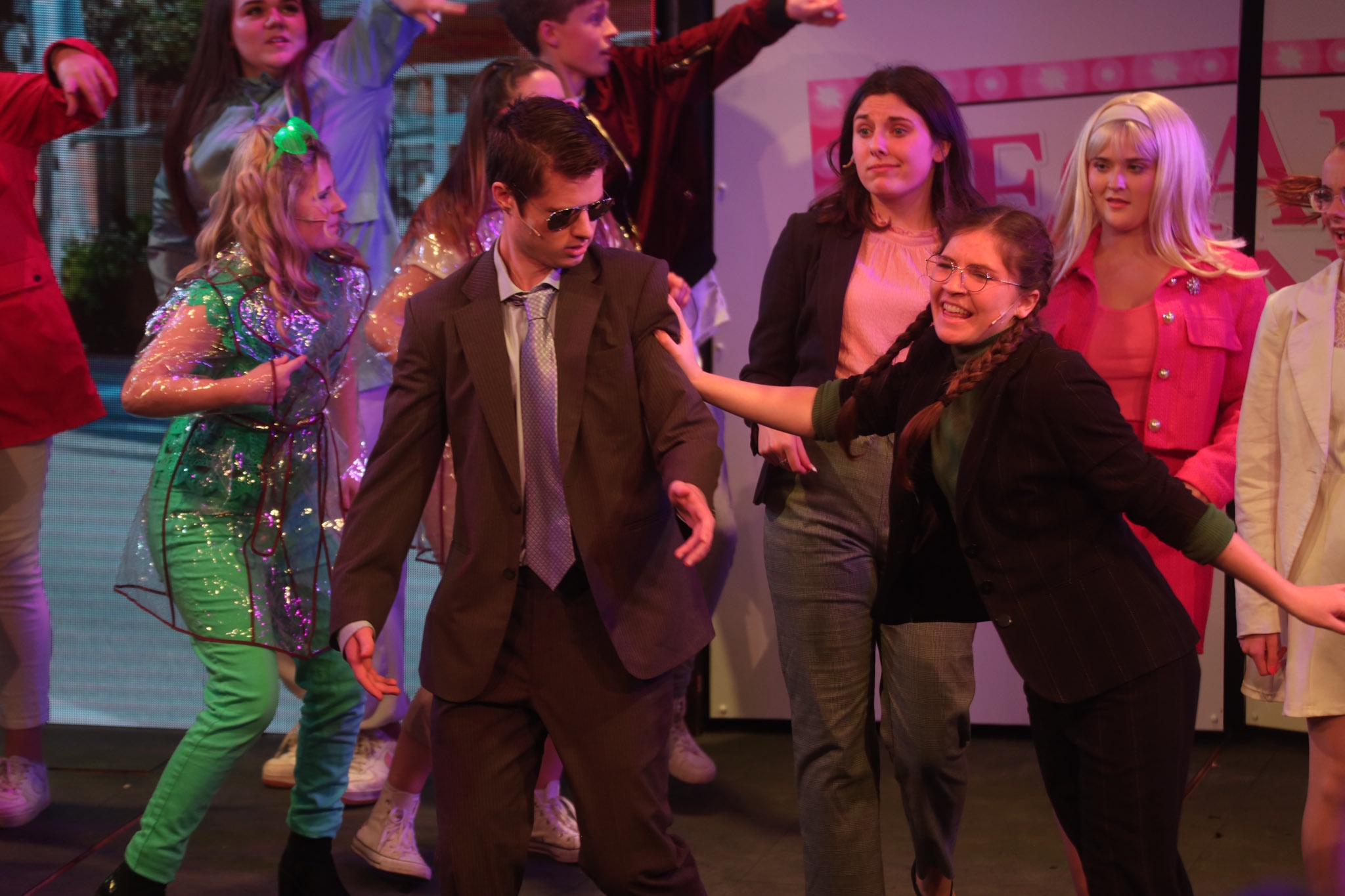

I Recieved My Performance Grading...
06/01/2025
With the show done, my performance was assessed...
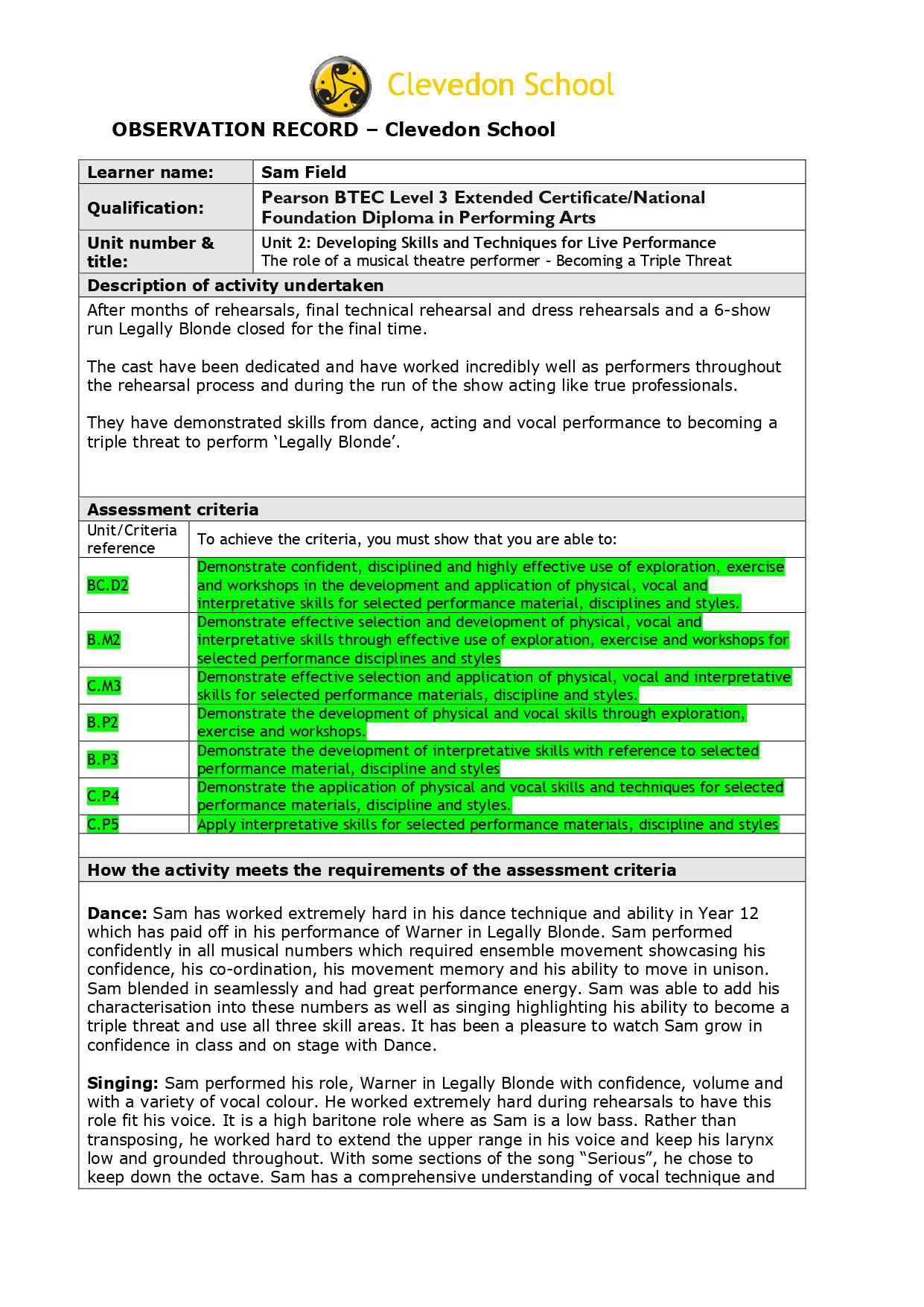
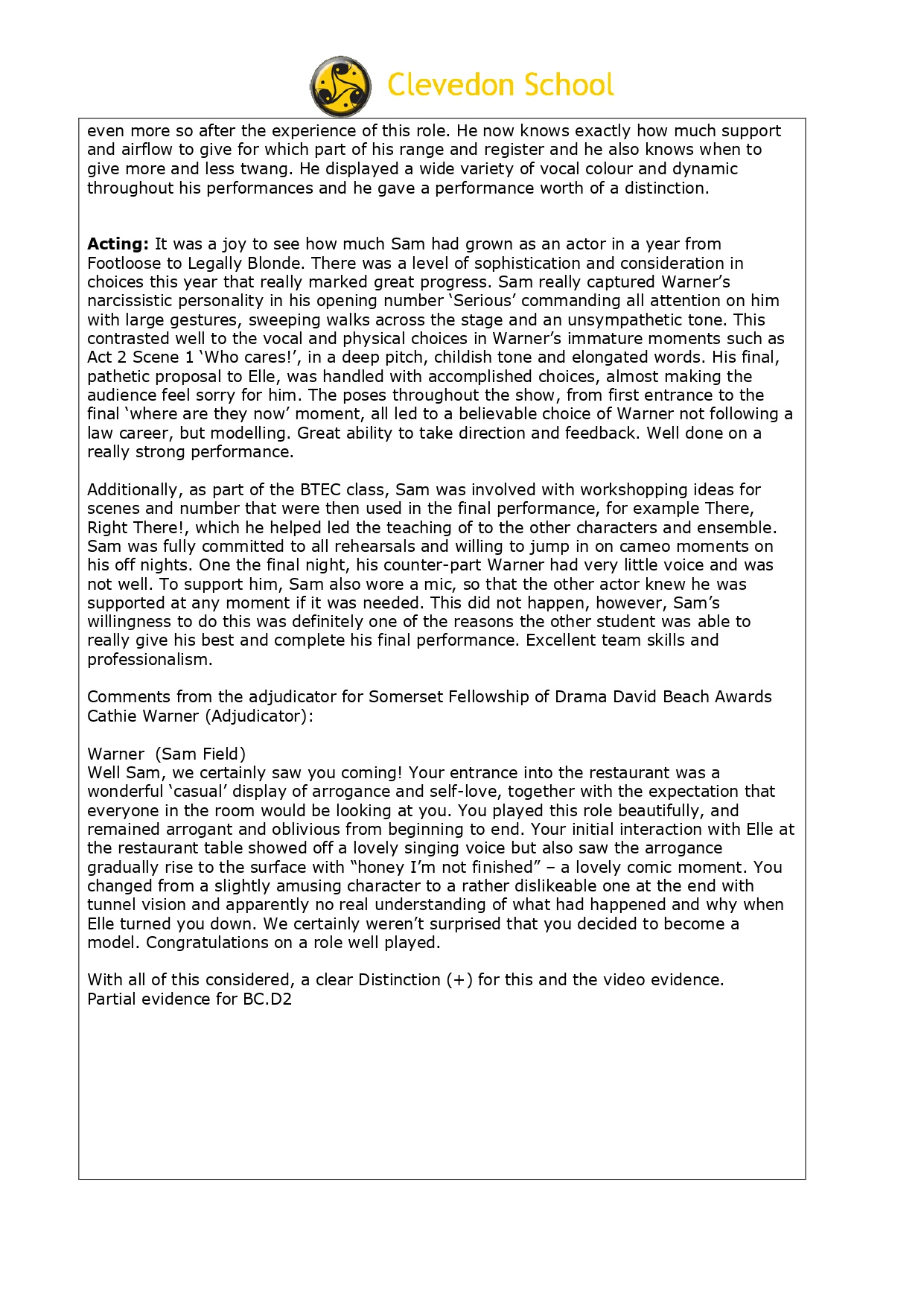
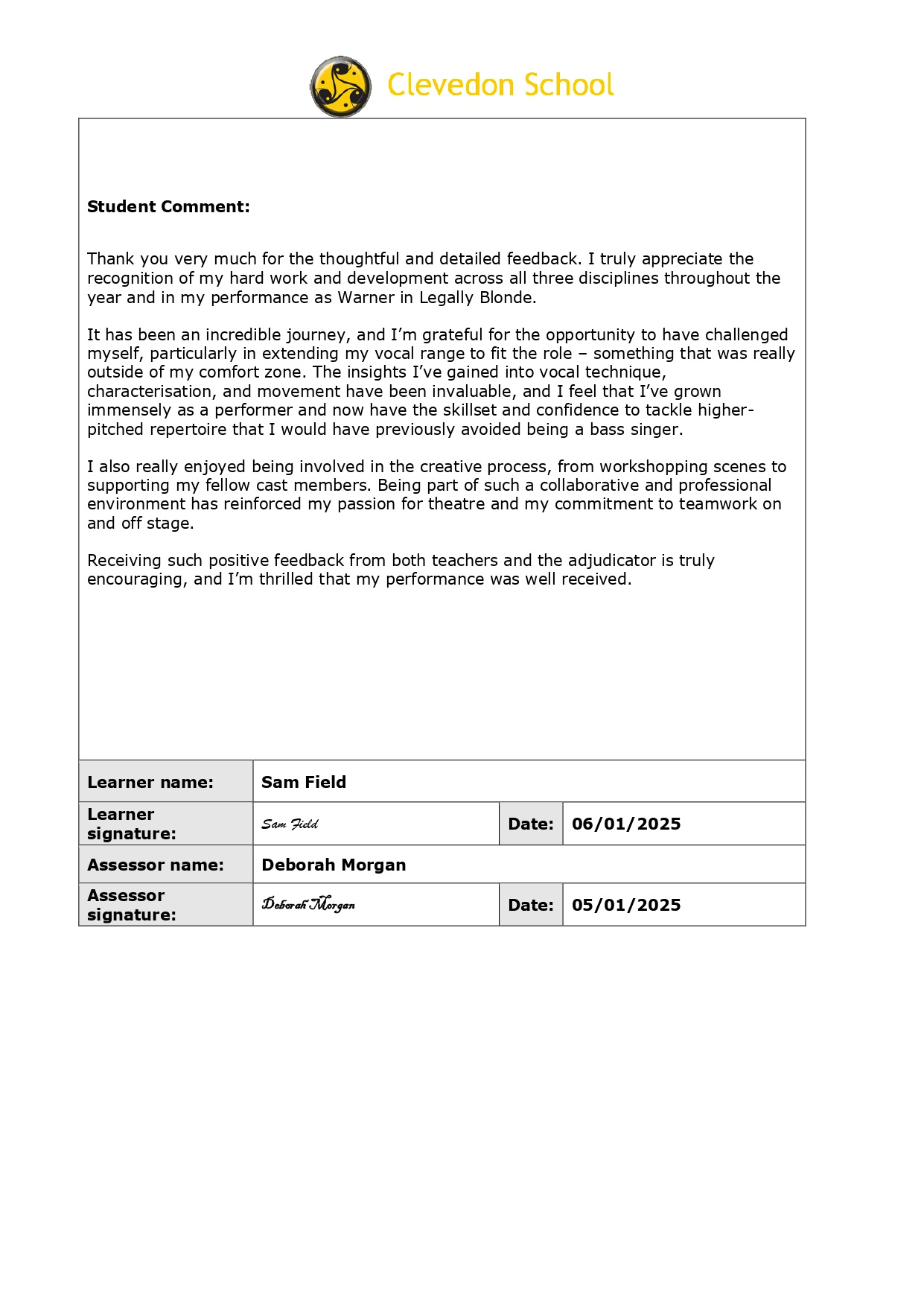
Please be sure to see my student comment on page three of the above document.
Reflections On Legally Blonde
19/12/2024
This year, I had the priviledge of playing Warner Huntington III in my school's musical "Legally Blonde"...
Each year my school puts on the most incredible musicals. This year, it was Legally Blonde. I took part in the musical last year, playing Chuck Cranston in Footloose, and I wanted to relive the joyous experience that it provided. When it was announced that we would be doing Legally Blonde, I was skeptical. As someone who is passionate about the classics: Les Miserables, Phantom of the Opera, Sweeney Todd, etc, the title of this "girly", overly pink musical didn't inspire much joy out of me... But I shouldn't have been so close-minded, because after I actually watched Legally Blonde, I fell in love... the comedy, the music, the characters, the story, it was amazing! In fact, I will now proudly declare that it is one of my favourite musicals ever! After watching it, I decided that I wanted to play Warner - the arrogant, super-handsome, rich, posh, self-obsessed, academic stud. I was very excited to audition for this character, but my dreams were shattered when my singing teacher told me that I should not audition for Warner as my voice was too deep, and should audition for Callahan instead. This wasn't ideal, but she was possibly right. So, during peak GCSE season, I auditioned for professer Callahan. I learned his song, "Blood in the Water", which actually suited my vocal range very well. But when it came to the acting auditions, I was caught by surprise as I was put on the spot and handed the script for Warner's audition piece and asked to have a go at auditioning for Warner. It's safe to say that this went fairly well, as I ended up getting the part.
Before we broke up for the summer, we were handed our scripts to get learning lines and given access to a music application that we could use to learn our songs. Upon recieving this material, I got to work reading the script which made my mind flood with ideas for how to play this character. Once I had read the script a good few times, I got to work writing my character analysis:

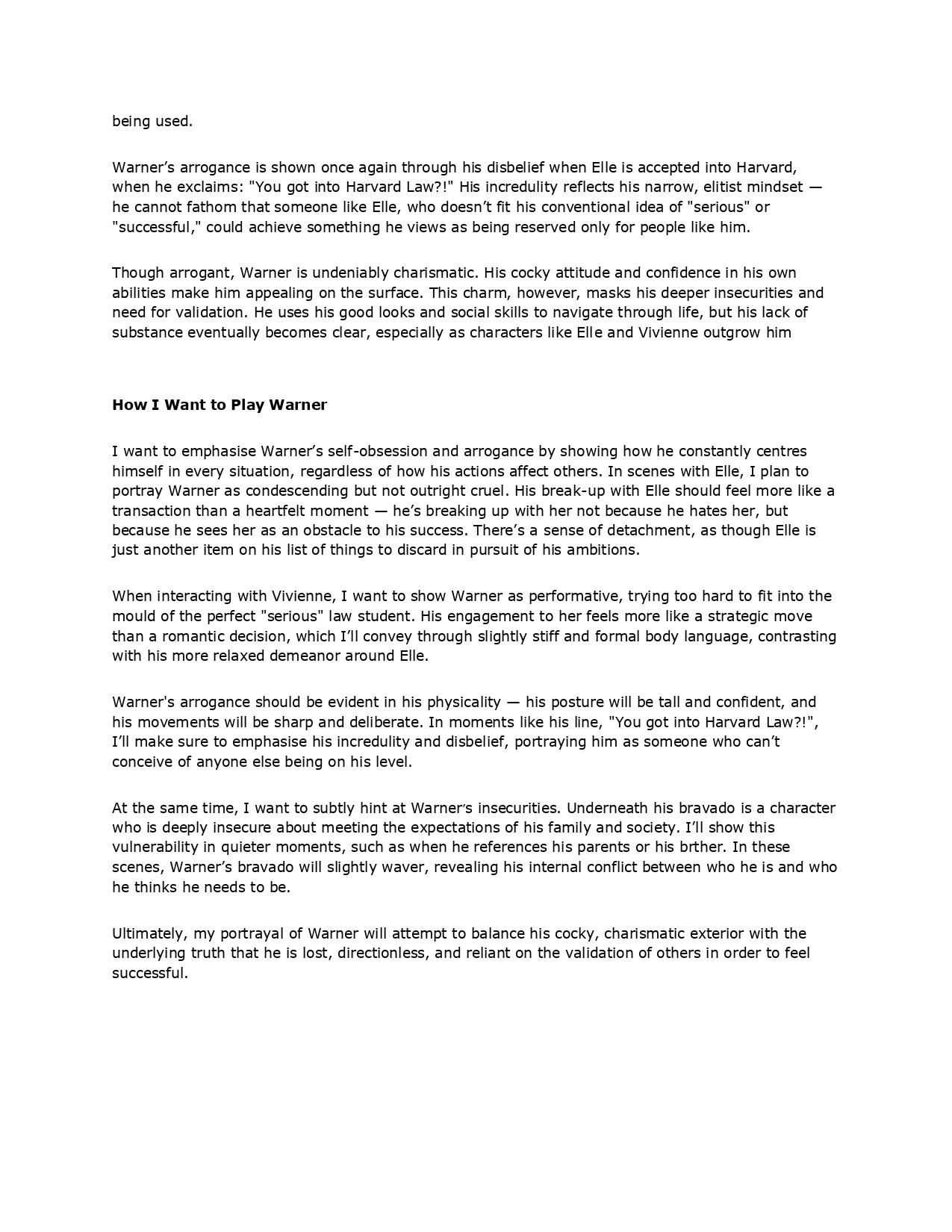
Rehearsals
We rehearsed frequently: every Tuesday and Friday from 3:10 to 5:30. We also rehearsed some lunch and breaktimes and even before school, demonstrating a strong commitment to refining the performance. This structured schedule reflects discipline and dedication, while the flexibility to rehearse outside designated times highlighted my proactive approach to improvement. These regular sessions provided ample opportunities to develop characters, enhance stage presence, and strengthen group dynamics, ultimately leading to a more polished and cohesive production. However, while frequent rehearsals were beneficial, balancing them with rest and reflection is essential to prevent fatigue and ensure sustained performance quality.
Singing
The singing was a huge challenge. My song, Serious, was not only technically difficult, but it was also out of my range. The song was written in eight different keys with varying tempos, making it particularly demanding both musically and vocally. Additionally, some sections required sustained high notes that were challenging for my vocal capabilities. Since part of the song was beyond my range, I explored several options: singing with octave jumps, using falsetto, or requesting a transposition. However, falsetto and octave jumps are musical pet peeves of mine, as they often sound unnatural for a character-driven performance. Because of this, I advocated for a transposition, requesting the song to be raised by five semitones to better suit my voice. Unfortunately, due to the complexity of the arrangement and the number of instrumental parts involved, rewriting and relearning the song would have been too difficult for the band, leading the musical director to deny my request. As a result, I had to compromise and accept the use of octave jumps. Determined to minimise their impact, I took the initiative to recompose some of the high parts of the song, making subtle melodic adjustments while ensuring the integrity of the piece remained intact.
This situation highlighted both the challenges and the adaptability I displayed, which is very much required in musical theatre. The technical difficulty of Serious, with its key changes and varying tempos, made it a particularly demanding song to perform. The issue of vocal range posed a significant obstacle to me, one which required careful consideration of possible solutions. While a transposition would have been ideal, the logistical difficulties of rewriting and relearning the music for the band made it impractical. My last-resort decision to modify the melody rather than rely solely on octave jumps demonstrated my resourceful and proactive approach to problem-solving. Adapting the composition to suit my vocal capabilities while maintaining the song’s essence, I managed to ensure that performance remained both technically feasible and authentic to the character. This experience really shone a light on the importance of flexibility in performance, as well as the need for collaboration between performers and musical directors to balance artistic vision with practical constraints.
Acting
When preparing to portray Warner, I conducted an in-depth character analysis to ensure a thorough understanding of his personality traits, relationships, and motivations. This analysis allowed me to grasp not only his external behaviours, but also his internal conflicts, ambitions, and insecurities, which informed my performance. To make Warner feel authentic and distinctive, I came up with and incorporated idiosyncrasies such as obsessive self-grooming (adjusting his hair or straightening his clothing compulsively), as well as a signature smirk, which conveyed his arrogance and sense of superiority. These subtle physical habits reinforced his personality and made him more recognisable to the audience.
Beyond physicality, I meticulously broke down each scene to determine the precise emotions, objectives, and subtext behind Warner’s actions. I carefully considered his intent at different points in the story, which meant that I was able to tailor my vocal inflections, facial expressions, and body language to reflect his shifting emotions - whether it was his calculated charm, hidden insecurities, or dismissive arrogance toward others. I also paid close attention to his relationships with other characters, ensuring that his interactions were layered with tension, manipulation, or feigned sincerity where appropriate.
This detailed approach allowed me to create a more nuanced and engaging portrayal of Warner, making him feel like a fully realised character rather than a one-dimensional antagonist. I was able to embody Warner in a way that resonated with the audience by combining psychological depth with deliberate physical choices, elevating the overall impact of my performance.
The Show
I performed my heart out in three shows as Warner and another three as a member of the ensemble, fully immersing myself in both roles. While I did get very nervous before each show, the adrenaline and excitement of performing in front of a live audience pushed me to give my best every time. The initial nerves were intense, especially during the first performance, as I worried mostly about hitting the right high notes. However, once I stepped on stage and got through the first few scenes, I found myself settling into the role and trusting in my preparation. Each performance became a learning experience, allowing me to refine my character portrayal, adjust my timing, and engage more confidently with my fellow actors and the audience. By the final show, I felt a tremendous sense of accomplishment, not only for my individual performance but also for being part of a successful production. I could truly feel my confidence grow after each performance, and by the last show, I felt fully in command of my role, able to enjoy the experience rather than be overwhelmed by nerves.
Performing in six shows, with three as Warner and three in the ensemble, required both versatility and stamina. The transition between leading and supporting roles provided a valuable opportunity to develop a well-rounded stage presence. The nervousness before each show is a natural part of live theatre, but the ability to channel that energy into a compelling performance demonstrated my strong stage discipline. Growing in confidence with each show indicated that experience played a key role in refining the portrayal, as repetition allowed for greater ease in delivering lines, adjusting to audience reactions, and fine-tuning movements. Furthermore, the ability to enjoy the experience by the final performance highlights my significant personal growth, as confidence replaced anxiety. This progression highlights the importance of preparation, experience, and adaptability in theatre, proving that challenges like stage fright can be overcome with persistence and passion.
Aftermath & Reception
Following the show, many audience members had lovely things to say about me - mostly about my singing to my surprise.
Our Tuesday evening performance was watched by a top critic from the esteemed Somerset Fellowship of Drama who wrote about me:
"Well Sam, we certainly saw you coming! Your entrance into the restaurant was a wonderful 'casual' display of arrogance and self-love, together with the expectation that everyone in the room would be looking at you. You played this role beautifully, and remained arrogant and oblivious from beginning to end. Your initial interaction with Elle at the restaurant table showed off a lovely singing voice but also saw the arrogance gradually rise to the surface with 'honey I'm not finished' - a lovely comic moment. You changed from a slightly amusing character to a rather dislikable one at the end with tunnel vision and apparently no real understanding of what had happened and why when Elle turned you down. We certainly weren't surprised that you decided to become a model. Congratulations on a role well played."
Watch The Show:
This is the Thursday recording, in which the role of Elle was performed by her counterpart due to the original cast member's illness.
Overall Reflections
What Went Well
This experience was an overwhelming success, both in terms of my individual performance and the production as a whole. My portrayal of Warner was well-received, with a professional theatre critic praising my ability to capture his arrogance, charm, and eventual downfall. This recognition reinforced the effectiveness of my character analysis and physicality choices, such as Warner’s signature smirk and self-grooming habits. Vocally, despite the challenges posed by Serious, I persevered and adapted, ultimately delivering a performance that surprised even myself. Additionally, my confidence grew significantly over the course of the production. While I initially struggled with nerves, by the final show, I was able to fully embrace the experience and immerse myself in my role. The commitment to rehearsals, alongside my ability to transition between a lead and ensemble role, also showcased my versatility as a performer. The overall response from the audience and the sense of camaraderie among the cast made this production a truly rewarding and unforgettable experience.
Lessons For The Future
Despite the many positives, there were several areas where I could improve. One major lesson is the importance of being open to feedback without letting it discourage me. Initially, when preparing for auditions, I allowed my singing teacher’s doubts about my vocal suitability for Warner to shake my confidence, rather than seeing it as an opportunity to challenge myself. While in the end, I was able to adapt vocally, I should have started practicing alternative singing techniques earlier instead of focusing so much on my idea of transposition. Additionally, my initial skepticism about Legally Blonde reminds me to keep an open mind when approaching new projects. Dismissing a show simply because it didn’t fit my preconceptions nearly caused me to overlook what became one of my favorite musicals. In the future, I also want to refine my ability to handle last-minute changes—being put on the spot during auditions was a challenge, but I learned that quick adaptability is a crucial skill in theatre. Furthermore, while I improved in managing stage nerves, I want to continue developing my stage presence, particularly in moments where my character isn’t speaking but still needs to remain engaged. Overall, this experience has reinforced the importance of preparation, resilience, and keeping an open mind in all aspects of performance.
SMART Target Review
Target 1 - To Increase My Vocal Range and Become More Comfortable Singing in My Head Register
Legally Blonde was an incredible vocal challenge for me as a dramatic bass, attempting to sing a lyrical tenor song without transposition! It was an extremely demanding task that required constant practice 24/7, even when the high notes strained my throat. Through this experience, I’ve had to learn a great deal about vocal technique to extend my range and sing higher. I’ve definitely noticed significant improvements in my pitch control and accuracy.
Target 2 - To imporve my control of my body through motion control and technique to imporve my overall dancing ability.
While Legally Blonde didn’t require me to dance, I have been working on my dance skills on the side. I’ve been aiming to do a HIIT workout most days, followed by a stretching session to build strength, stamina, and flexibility. This routine has helped improve my overall control, balance, and coordination, which are essential for dancing. I’ve also been focusing on refining my technique to enhance my performance ability for future roles that may require more movement.
Target 3 - To Improve My Confidence When Performing
I got very nervous before each show, but I learned effective ways to manage my nerves. Once I stepped on stage, I quickly gained confidence after just a few moments - it’s the initial anticipation that’s the most daunting part. As the show week progressed, I felt increasingly at ease and comfortable in my performance, allowing me to focus more on my character and delivery rather than my anxiety. Confidence is crucial for a performer because it enhances stage presence, helps maintain composure under pressure, and allows for a more engaging and authentic performance. When a performer is confident, they can connect better with the audience, fully embody their role, and recover smoothly from any mistakes. This experience has taught me the importance of self-assurance on stage and how preparation and practice contribute to building that confidence.
Would I Get To Perform Again?
13/12/2024
My counterpart had fallen ill, and wasn't sure if he could perform tonight...
Today was another reminder of just how unpredictable live performances can be. When my director, Mrs Morgan summoned me for a quick chat with her today, I was very surprised to hear that my counterpart had fallen ill and was seriously uncertain as to whether he could perform tonight.
As things stood, I was going to sing his solo song, "Serious" and he would lip-sync to it. While the prospect of taking over his solo was an unexpected twist, I wasn't nervous about it as I knew the song well and had sang it live plenty of times in the past few days. And after all, in live theatre, flexibility is key, and moments like this arn't all that rare. But the story didn’t end there...
After drugging himself up with pain killers, he felt that he might be able to push through and perform the solo himself. Despite that, I was still asked to remain on standby, mic'd up and ready to step in at a moment’s notice. My role would be as a backup — a background actor ready to seamlessly switch into action if anything went wrong.
Fortunately, he was able to push through his discomfort and deliver the solo. But knowing that I was prepared to jump in if needed gave a sense of reassurance. In the world of live theatre, being ready to step up in an instant is quite an essential part of the job.
While things did end up running smoothly this time, it was an eye-opening experience that reinforced the importance of teamwork, adaptability, and staying focused under pressure. As performers, we always have to be ready for the unexpected — because, in the end, that’s what keeps the magic of live theatre alive.
My Final Performance
12/12/2024
Twas a very sad day today as I performed as Warner in Legally Blonde for the very last time...
Tonight would be my last ever performance as Warner in Legally Blonde. As we only had one performance today, in the evening, we were off-show until 1:30pm. I had no lessons this morning, so I had a lie-in to rest up before my big performance.
Upon arrival at school at 1:30pm, we were informed that our Elle Woods had become ill and would not be performing tonight, and so in her place was her counterpart, who I had not rehearsed with all that much for this part.
As we'd never ran the solo song together, we decided to skim over the blocking and harmonies of it together in our own time. This unexpected change in casting added an extra layer of challenge to my final performance as Warner. Since I had developed a strong dynamic with our usual Elle, I had to quickly adapt to performing with her counterpart, ensuring that our chemistry and timing remained intact. Fortunately, our brief run-through of the blocking and harmonies helped ease my nerves, and I reminded myself to stay present and responsive on stage, adjusting to any slight differences in delivery or pacing.
When the evening performance finally arrived, I was determined to make the most of my last opportunity to embdy Warner. From the moment I stepped on stage for "Serious", I focused on fully immersing myself in his entitled and oblivious mindset, ensuring that my posture, gestures, and tone all reflected his arrogance. Despite the initial nerves about singing with a different Elle, the duet went smoothly, and I found that the slight changes in her performance actually helped me remain engaged and reactive rather than falling into autopilot.
One of my highlights of the night was the party scene, where I leaned further into Warner’s comedic immaturity. I exaggerated my physical reactions to Elle’s bunny costume just a little more than usual, which seemed to land well with the audience, earning some of the biggest laughs of the show(especially from my family, who were all watching tonight!). This moment reminded me how rewarding it is to fine-tune comedic timing based on audience responses - something I’ll carry forward into future performances.
As the show progressed, I became increasingly aware that this was my final time stepping into Warner’s shoes. By the finale, I felt a mix of satisfaction and sadness, knowing that this chapter was coming to a close. Loking back, I felt that my biggest strength throughout this run was my ability to maintain Warner’s layered personality, balancing his charm, vanity, and insecurity in a way that made him feel believable rather than a one-dimensional antagonist. I also felt that my comedic choices developed well over the performances, refining what worked best in front of an audience.
That being said, if I had the chance to perform Warner one more time, I would have focused on refining my vocal technique even further, particularly in "Serious", ensuring that I sang with complete ease and confidence in the higher sections. Additionally, while I adapted well to performing with a different Elle, I could have worked on creating even stronger chemistry in the short time we had together before the show.
Overall, playing Warner has been an incredibly valuable learning experience. It challenged me in multiple ways: vocally, comedically, and dramatically, and helped me grow as a performer. As much as I will miss playing this role, I leave the production feeling proud of what I accomplished and excited for whatever comes next in my journey in theatre.
My First Performances
10/12/2024
The day has finally arrived... time to put our hard work on display...
Many many hours are hard work, practise and dedication had all built up to this moment - our actual performance!
I woke up this morning feeling extremely nervous. I went in to school at 8:00am with no breakfast, and feeling very sick. I wasn't nervous about the acting, but about the singing. This would only be the second time I've ever sang in front of an audience, and my solo song Serious was incredibly high in my range, too high at some points! When I'm nervous, I find the best way to cope for me is to distract myself with exercise and music. So that is what I did, I walked to school with my favourite songs blasting through my airpods.
After arriving at school, I got into my costume and then made my way to the stage for our register, briefing and warmup.
We then snagged a few scenes, of which I was needed in:
The Harvard Variations
Blood In The Water
Serious Reprise
Finale
With snags ran, I asked my singing teacher if she could warm me up and then go over the solo song with me because I was feeling very nervous about the singing. She said yes, and off we went to her piano. She warmed me up with a series of exercises, including humming, lip trills, yawns, sirens and more. I then sang the solo. It all sounded fine, and I was able to sing the whole beginning section up the octave, although it did sound a bit strained and tense during the part in E Major so I asked to go over this part again.
After this sing-song, my voice was starting to strain a bit, so I decided to go on vocal rest until the start of the show.
Before our first show, we had a quick mic check before a group physical and vocal warmup to get us in the performing mood.
As we crept closer to the show, I began to get even more nervous about the singing. So, as with before, to calm my nerves I went for a walk around the school site with my music blasting through my airpods, and before long, it was show time!
My solo song, Serious was the opening solo of the show, which was good because it meant I could get it over done with, and then my nerves would subside, but the pressure was on, because as the opening show, it kind of sets the standard for the show. As I waited behind the grand upstage doors, feeling what I can only compare to that of being strapped into an enornous roller coaster as it slowly protrudes up its lift hill - there's no going back and you just have to let it happen to you - it's terrifying but exhilerating at the same time. When the transition music started, I gave my costume a final check to make sure I was all neat and tidy before taking a deep breath and stepping out into the limelight. The problem with the change in transition music was that it was just vamping the first four bars of the actual song, meaning that it was indistinguishable from the actual start of the song - this made it quite difficult for me to come in at the right time as I could only come in on the fourth bar, meaning that if the dialogue ended on the first bar, for example, I would have to wait for another three bars of music before I could come in. On both performances today, there was a pause between the dialogue ending and the song actual starting, whereas (to be very pedantic) the singing is suppossed to start seamlessly and immediately after the dialogue ends. The singing actually went well, I managed to sing the whole first part up high, everything was in tune, and in time. The hardest part of the song was after Warner reveals his breakup plans to Elle, there is a section of dialogue with no music underscoring, and at the end of it, I had to speak in rythm and on pitch (a low a repeated in quarter beat notes), with no music to guide me, and then sing up to a high c# where the band comes in. This was very difficult, and would be catastrophic if I didn't reach the c# as my relative pitching could cause me to be singing the rest of the song completely off-key. Fortunately, I was able to reach the c# up high at both performances today. The choreography and staging also went well.
After my solo song, I had a costume change into my Harvard attire, before re-entering for "The Harvard Variations", where Warner blends into the elite academic environment that he so desperately wants to be a part of. This number was much less nerve-wracking for me since it was an ensemble-driven scene, and I could focus on acting rather than singing. My main goal in this scene was to present Warner as effortlessly confident, bordering on enttled, as he mingles with his fellow Harvard students. I made sure to carry myself with a relaxed but self-assured posture, throwing the occasional smirk or dismissive glance at Elle, subtly reinforcing his belief that she doesn’t belong in this world.
The next big moment for me was "Serious (Reprise)," which, despite being short, was an opportunity to showcase Warner’s immaturity and shallow nature. After being initially entranced by Elle in her bunny costume, I deliberately played up Warner’s dreamy fascination, letting my body relax and my gaze drift upwards as if caught in a fantasy. However, the moment she mentioned the Callahan internship, I snapped back into a more dismissive and patronising tone, reinforcing Warner’s lack of faith in her abilties. This contrast was important to highlight because it marks a pivotal moment in Elle’s character arc - her realisation that she is chasing validation from someone who will never take her seriously.
Throughout both performances, I found that my strongest moments were in character portrayal. I felt that I successfully captured Warner’s arrogance, immaturity, and entitlement through my physicality and vocal inflections. The comedic moments, particularly in the party scene, seemed to land well with the audience, which was reassuring. My choice to add small idiosyncrasies, like obsessively straightening my tie and running a hand through my hair, helped reinforce Warner’s obsession with appearance and status.
That being said, there were areas I felt could have been improved. While my singing in "Serious" went well overall, I still felt some tension in the higher sections, and I would have liked to feel more relaxed vocally. Additionally, I noticed that in some moments, particularly in scenes where Warner is more passive (such as when Vivienne takes the lead in belittling Elle), my energy dipped slightly. I could have maintained a stronger presence, even in the background, to ensure that Warner’s character remained consistent.
One of the biggest takeaways from this performance was how crucial preparation and warmups are in musical theatre. The vocal warmups I did earlier in the day helped immensely in easing my nerves and ensuring I was vocally ready. The experience also reinforced the importance of adaptability - when minor issues arose, such as the timing of the transition music, I had to trust my instincts and stay composed.
Overall, playing Warner on these first two shows was an incredibly rewarding experience. He is a character that, while not the most likable, plays a crucial role in Elle’s transformation, and I very much enjoyed exploring his flaws and idiosyncrasies. These initial performances did push me outside of my comfort zone, particularly with singin, but in the end, I felt that I delivered a solid portrayal of Warner’s entitled and self-absorbed nature. This role has definitely helped me grow as a performer, and I look forward to applying what I’ve learned into my final performance on Thursday.
I Recomposed My Solo Song
08/12/2024
In order to better suit my vocal range, I have recomposed parts of my solo song...
My plan to increase my vocal range has been ground to a halt as I've been on vocal rest for the past few days due to my deadly cold. I still don't particulalry want to sing with octave jumps, because they just sound plain silly and the lower frequencies just don't get picked up by the microphones very well. So now, two of my plans have failed: firstly my transposition request got declined, and now my plan to increase my vocal range has failed. But, as a wise man one said: "If the plan fails, change the plan, but never change the goal". My goal is to sing my solo song up high (for the most part), and avoid unnatural sounding octave jumps. So, my new plan is to recompose the vocal line of the song, bringing the extremely high notes down a notch, whilst still making the vocal line fit with the instrumental.
I began by examining the sheet music for the song. After my examination, I knew that a recomposition was not going to be possible for the latter half of the song, and I would just have to accept defeat and sing it with octave jumps. However, for the first half, I could certainly recompose the high parts of the vocal line. In terms of recomposing, for any pitch that I deemed too high (anything above a c5), I would mark as a note to bring down. In some parts, I also changed the note duration slightly (while keeping the same overall duration of the notes in its bar) so that I would not have to sustain high notes for very long at all. When shifting pitches, its not quite as simple as just identifying the high notes, and just moving them down a notch, I had to carefully calculate which pitch to move down to whilst maintaing a melody that flows naturally and sounds good with the accompaniment. For this, I identified the note to move down, and then moved it to the nearest note below it in its major / minor chord depending on its position in the scale (for example, if I wanted to move a d5 down, I would move it to an a4). In some cases, I was able to just replace the note with a duplication of the pitch previous to it. Upon playback, this sounded pretty good and I was happy, all that's left now is for me to forget what I previously knew as the melody, and relearn parts to suit my new arrangement.
Sheet music of my new composition:
Highlighted sections are the parts that I recomposed
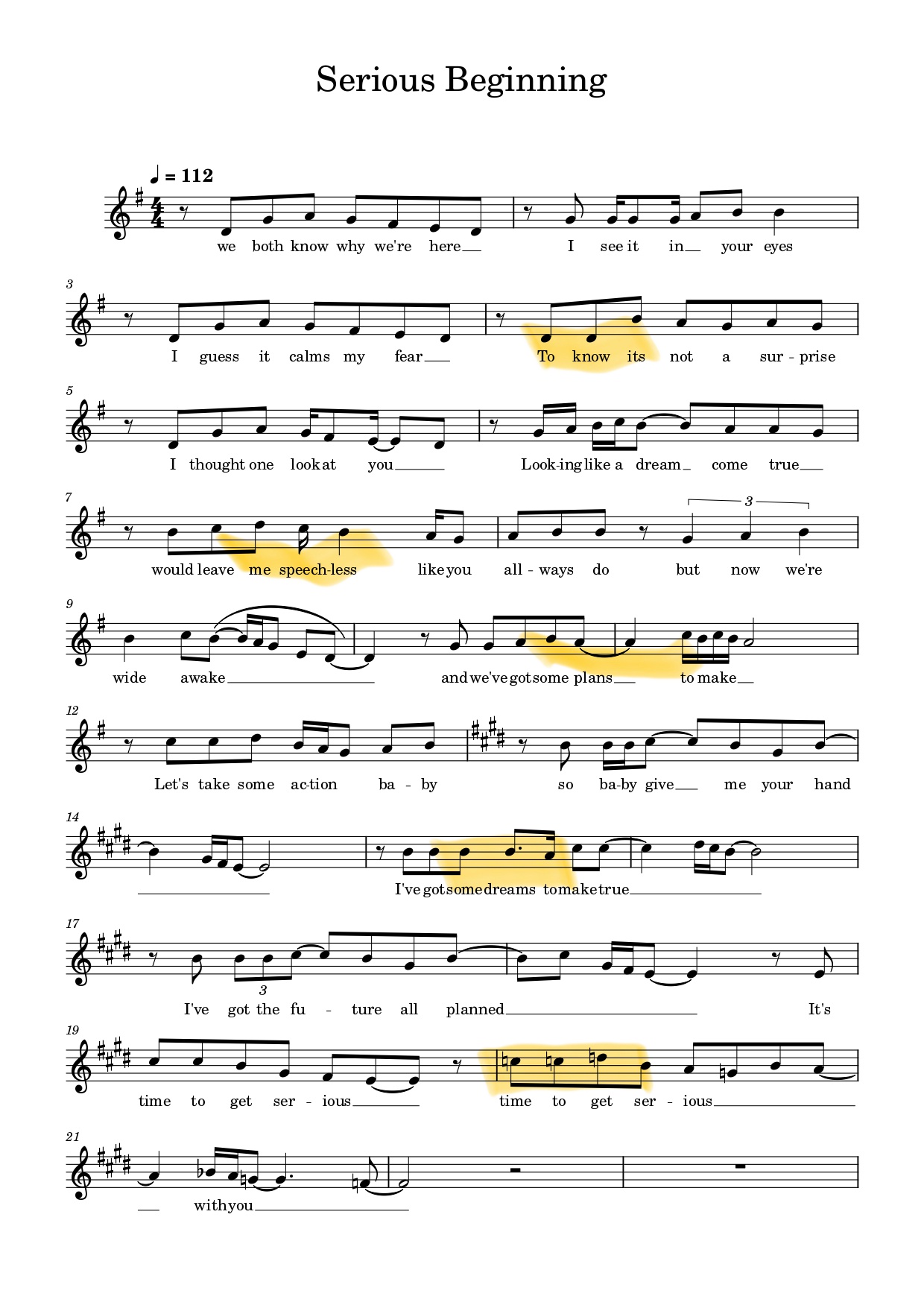
Listen to a piano recording of my new composition:
My decision to recompose parts of Serious demonstrates both my creative problem-solving and my solid understanding of musicality, character, and audience perception. Rather than compromising the integrity of the performance with unnatural octave jumps or falsetto, which would diminish Warner’s confident and charismatic persona, I have opted for a solution that balances vocal feasibility with musical consistency. The process of adjusting the melody while maintaining its alignment with the instrumental accompaniment required careful consideration of harmony, phrasing, and overall flow. By strategically shifting notes within the existing chord structure, I have ensured that the new vocal line still sounded cohesive and natural, preserving the song’s original energy and intent. This approach not only showcases my ability to adapt under pressure but also reinforces my commitment to delivering a polished and authentic performance. However, the need to now relearn the adjusted melody poses its own challenges, as muscle memory will make it difficult to override previous vocal patterns. Additionally, while the recomposed sections improved vocal accessibility, the unavodable octave jumps in the latter half of the song will have to remain as a weak point, potentially impacting vocal confidence and projection. Despite this, my solution exemplifies resilience in overcoming vocal limitations and highlights the importance of flexibility in musical theatre, where performers must often tailor their approach to suit both artistic and practical constraints.
We Did A Full Run-through Rehearsal
07/12/2024
I woke up this morning feeling awful again, but there was no time to dwell, for today was our only full run-through before our first actual performance...
Overall, I felt that today’s run-through went really well! I hit all my lines and cues without any mistakes, which is a great confidence boost. One thing I do need to work on is filling the gap before my solo. Since the new intro music is longer than the dialogue, I’ll need to come up with a natural way to bridge that moment - whether through a bit of movement, an added expression, or a subtle interaction with the scene.
I'm excited to keep refining things as we get scarily close to the performances!
Tech Run Rehearsal
06/12/2024
I woke up this morning feeling like absolute shit: a headache, sore throat and blocked nose... and today was tech run...
Today was a big day: the tech run. The day in which we ran the entire show along with the new additions of the band, stage crew, lights and microphones. I woke up that morning feeling quite possibly the illest I've ever felt - a raging headache, extremely sore throat, fully blocked nose and chesty cough. I'd been feeling ill for a few days now, but today was something else - especially not ideal for one of the most important days in regards to the show. The theatre environment would also prove not to be ideal for my illness: a dark room with bright, flashing lights, and loud music.
We started early, arriving at school at 8:30am. I began by grabbing all of my costumes and transporting them to the boys' changing room - my new base for the next week. I put on my opening costume, a lovely suit before attempting to style my hair. Hair styling proved to be very difficult, I've never really styled my hair before, I usually just wake uo and roll with it, however, armed with my sister's comb, gel and hairspray, I got to work attempting to pull off a look similar to those presented in my moodboard. My first few attempts I ended up scrapping and restarting, but I eventually managed to get a style that looked somewhat decent.
The process of styling my hair for the role highlighted the importance of visual transformation in musical theatre, where every detail: costume, hair, and makeup, contributes to character authenticity and audience perception. Warner’s polished, self-absorbed persona required a meticulously groomed appearance, making hairstyling a crucial aspect of my portrayal. My struggle to perfect the look reflects the level of detail and commitment required in theatre, where actors must often adapt to new skills beyond singing and acting. While initially challenging, the experience underscored the importance of physical presentation in character embodiment, reinforcing how even minor aesthetic choices can enhance believability and stage presence.
By the time my hair was finished, we were called for a miccheck. The miccheck was a very easy and simple process but a vital one nonetheless, as it's essential that all mics are working properly so that we can actually be heard on stage.
Before starting our music run, we were asked to stand in our blocked positions for the final few scenes so that the lighting designer could program the lights to be in the right place.
Ensuring proper lighting placement is essential in musical theatre, as it enhances visibility, directs audience focus, and reinforces mood and storytelling. Standing in blocked positions allowed the lighting designer to program cues accurately, ensuring that each actor was well-lit and their expressions and movements were clearly seen. For me as an actor, finding my light is crucial to maintaining stage presence and avoiding shadows that could diminish their impact. This process highlighted the collaborative nature of theatre, where technical elements like lighting work hand-in-hand with performance to create a polished and professional production.
With preparations complete, we began running the show with music and lights. It wouldn't be very smooth however, with musicians wanting to redo and refine parts and lighting cues missed. With limited time, we would not be able to conduct a tech & music run for both casts, instead, my cast would run every scene from Act 1 to nail the music, set changes and lighting cues, and the other cast would run every scene from Act 2 to nail the music, set changes and lighting cues. I was first used for my solo song, Serious. It got off to a rocky start, as the set took a lot longer to come on than thought, meaning that I was not able to enter the scene on my musical cue. So, the transition music was compeletely changed which also changed my entrance cue. That problem may have been solved, but it wasn't long before an new problem emerged: the set had been placed too far downstage, and therefore out of the spotlight. This was an easy fix and the stage crew quickly noted and fixed the issue. On our thrid attempt, everything went fine and the scene ran with no issues. I was able to enter the scene on cue, and start singing on cue. One thing that did happen though, was that with the new transition music, there was a longer gap now from when the dialogue ended, and when the singing started. After this moment of awkwardness, I decided that I should come up with some gap-filling actions to execute whilst waiting for the song to start.
My next couple of scenes were big group ones.
My next personally important scene was the Serious reprise. After initially starting to run the scene, the director decided that she wanted some jazzy music to underscore the scene. Whilst this was a nice edition, the music ended up overrunning and being too long for the scene. This meant that I was not able to start singing on my cue, and instead had to wait for a fair amount of time before I could start singing. After this, I decided that it would be a good idea to think of some gap-filling actions to execute whilst waiting for the song to start. After the song, there is alot of spoken dialogue, all underscored by music. This music was played very fast, and I unconsciously found myself rushing my lines so that they were in time with the music - I was not supposed to do this! And to overcome this, I would just have to try to ignore the music and speak normally - an easy fix.
The following scene took a looooooooot of time to run. It was the complex number "Chip On My Shoulder" which has several set changes, costume changes, speaking into singing etc, in total it took us an hour and a half to run this whole scene in order to nail the transitions, timings and lighting. I had run some parts over and over and over again, and to be honest, it was getting quite tedious and demotivating.
My final scene of the act was the one in which I propose to my girlfriend, Vivienne. Here, she announces that she and Warner have been selected for Proffessor Callahan's prized internship.
Despite the long and tiring process of refining transitions, cues, and technical elements, I reminded myself that these meticulous rehearsals are crucial in ensuring a polished final production. The "Chip On My Shoulder" run-through, though tedious, reinforced how much effort goes into perfecting seamless scene changes, balancing music and dialogue, and coordinating the cast and crew. It highlighted the sheer level of precision required in musical theatre that every minor adjustment contributes to the overall flow and believability of the story.
By the time I reached my final scene of the act (the proposal to Vivienne) I was feeling physically exhausted and mentally drained, especially as I battled illness. However, I knew I had to push through, as this was a pivotal moment in Warner’s journey. His excitement over the internship and his grand, yet ultimately misguided, proposal to Vivienne needed to feel authentic, reinforcing his obliviousness to Elle’s growth and his own diminishing importance in the story. Given the intensity of the tech run, I found it useful to reflect on Warner’s mindset at this moment - his desperation to cling to status and security, using my own fatigue to fuel his emotional missteps.
Looking back, this tech run was a massive learning experience. The challenges of adjusting to new cues, overcoming technical delays, and maintaining focus through long rehearsals all underscored the discipline required in theatre. While frustrating at times, it was a reminder that performance isn’t just about the final product, it’s about resilience, teamwork, and adaptability. I also realised the importance of staying flexible and responsive to changes, as elements like music alterations and lighting adjustments required me to rethink my approach in real time.
Despite feeling ill and exhausted, I walked away from today’s run with a deeper appreciation for the behind-the-scenes work that makes a production successful. It wasn’t perfect, but it was progress. And as draining as the day had been, the thrill (and fear!) of knowing opening night was fast approaching made all the effort feel worthwhile.
Warner Likes To Touch Himself
01/12/2024
I came up with some idiosyncrasies for my character, Warner, to reflect his personality...
Idiosyncrasies are distinctive traits, habits and behaviours expressed by a character that reflect their personality.
Obsessive Self-Grooming
I could frequently "play" with my hair, smoothen my shirt or straighten my tie or collar, even when not even needed. This constant self-checking would show Warner's fixation with appearances and desire to look polished at all times.
Smirking
I could subtly smirk to convey Warner's condesention, especially when Elle is revealing her ambitions.
Confident Posture and Gestures
Warner carries himself with an air of entitlement, so I could ensure my posture remains upright, shoulders back, and head slightly raised to reinforce his privileged background and self-assured nature. Adding small, deliberate gestures, such as lazily placing a hand in my pocket or adjusting my cufflinks, would further convey his arrogance and ease in high-status settings.
Dismissive Hand Movements
To highlight Warner’s dismissive and patronising nature, especially toward Elle in the opening song, "Serious", as well as in the party scene, I could incorporate subtle hand waves or half-hearted gestures when talking to her, as if to brush off her words or to downplay her aspirations. This would reinforce his belif that she is not on the same level as him and emphasise his lack of emotional investment in their conversations.
Nervous Tics Around Vivienne
While Warner presents himself as confident, his relationship with Vivienne is more about status than actual affection. To reflect this, I could incorporate small nervous tics when she is around (such as adjusting my tie more frequently or shifting my stance) to suggest that he feels pressured to maintain a certain image rather than being entirely comfortable in his own skin.
Evaluating my approach, I believe these idiosyncrasies effectively enhance Warner’s characterisation by making him feel more dynamic and layered. Strengths of this approach include its ability to subtly communicate Warner’s vanity, entitlement, and insecurity without relying solely on dialogue. His obsessive self-grooming, for example, reinforces his fixation on appearances, which is crucial in understanding his motivations - he values status and image over genuine connections. Similarly, his dismissive hand gestures and condescending smirks serve as to create a clear contrast between him and Elle, further emphasising the power imbalance in their relationship. These details help ground the character in realism, as in professional acting, physicality plays a huge role in making a performance feel authentic.
However, there are areas that could be improved or further emphasised. While I have focused on Warner’s arrogance and shallowness, I could explore more moments of emotional nuance. For instance, while his nervous tics around Vivienne hint at his discomfort, I could deepen this by subtly shifting my vocal tone or delivery when speaking to her, making it clearer that Warner is playing a role rather than being his true self. Additionally, I could explore more ways to use Warner’s physicality for comedic effect - perhaps exaggerating his self-grooming to a borderline ridiculous level in certain moments, or overplaying his smooth confidence when trying to impress Elle, only to undercut it with an awkward blunder.
This method of developing a character through idiosyncrasies links directly to real-world performance techniques such as Stanislavski’s method of physical actions or Laban’s movement analysis, both of which emphasise how body language and habits can reveal a character’s inner world. If I integrate these mannerisms consistently throughout my performance, I can ensure Warner remains engaging and believable, while also highlighting his flaws in a way that serves the narrative and adds to the overall humour of the production.
I Need To Increase My Vocal Range... And FAST!!!
29/11/2024
My transposition plan has been red-lighted, and I don't particulary want to sing with octave jumps, so there's only one thing for it - expanding my vocal range in just 7 days, what could go wrong?...
I've been advocating for the transposition for my solo song "Serious" for a while now, I'd even written the sheet music for it myself, but, unfortunately for me, I will not be getting a transposition. This means I will have to sing "Serious" in its original key. The only problem is, the original key is incredibly high, too high at some points so I'm having to jump octaves constantly to accommodate this. I am not a fan of octave jumps - not that I can't do them, but that they sound comepletely unnatural for a character. Therefore, in a last ditch effort to save my solo song, and prevent eternal disgrace should I give a bad performance infront of all of my teachers and family, I have had the crazy idea of increasing my vocal range in the 10 days we have left before our first performance.
I often have crazy ideas, things that seem ridiculous and almost impossible, but history has shown that I actually follow through with the majority of them. Determination, motivation and perseverance are my current driving force to achiveing my bonkers idea of increasing my vocal range.
So, how am I actually going to increase my vocal range in such a short space of time? Good question. I don't really know. But I do have some ideas that technique, posture, and breathing could very well be important factors if I want to increase my vocal range. Thankfully, I'm not alone on my vocal range expansion journey as I have the internet at my fingertips. And so, I shall use the internet to research just how I can work on increasing my vocal range.
How to increase my vocal range (According to the internet):
Breath Support: Learn diaphragmatic breathing. Proper breath control ensures you can support higher notes without strain.
Relaxation: Avoid tension in neck, throat, and jaw. Stretch and massage these areas regularly.
Placement: Focus on forward resonance ("mask" placement). Higher notes often require directing sound toward the face and sinuses.
Scales: Use scales to gently extend range. Start at a comfortable pitch and gradually add higher notes over time.
Incremental Stretching: Aim for one or two notes beyond my comfort zone and revisit them frequently.
Warmup: Always warm up before singing with gentle exercises like humming or lip trills.
Hydration: Drink plenty of water to keep vocal cords hydrated.
Rest: Avoid overuse. Rest voice if it feels strained.
Avoiding Irritants: Steer clear of caffeine, chocolate and shouting.
Plan of action upon my findings:
1. Undertake extensive warmups
2. Utilise scales
3. Focus of breath & support (maybe slow tempo to allow more brething time)
4. Drink plenty of water
5. Not eat chocolate
Using a pitch app, I will monitor my progress by finding my highest note I can reach in head register. I will also record the percentage of time that I sing "Serious" in tune using this app.
With my plan down, it's time to get to work. I really hope this works!
What Hairstyle Should Warner Have?
28/11/2024
Choosing an appropriate hairstyle to suit a character and reflect their personality is crucial in musical theatre...
I'm well known for being the one guy in school who has had the same hairstyle his whole life. I'm not very fussed about my hair, but I do love when show week comes around so I can experience the wonders of extravagant hair styles.
Warner needs a hairstyle that reflects his polished, privileged, and image-conscious personality. Since Warner is all about appearances and fitting into the mold of a “successful” future lawyer, I believe his hairstyle should be clean-cut, sophisticated, and deliberately styled to convey his prestigious charm and sense of control.
I also have to bear in mind what styles are actually possible to pull off with my hair. I have been growing my hair for a couple of months just for this show, but it's still not all that long.
After researching some potential styles, I have created a moodboard for the style I want to achieve:
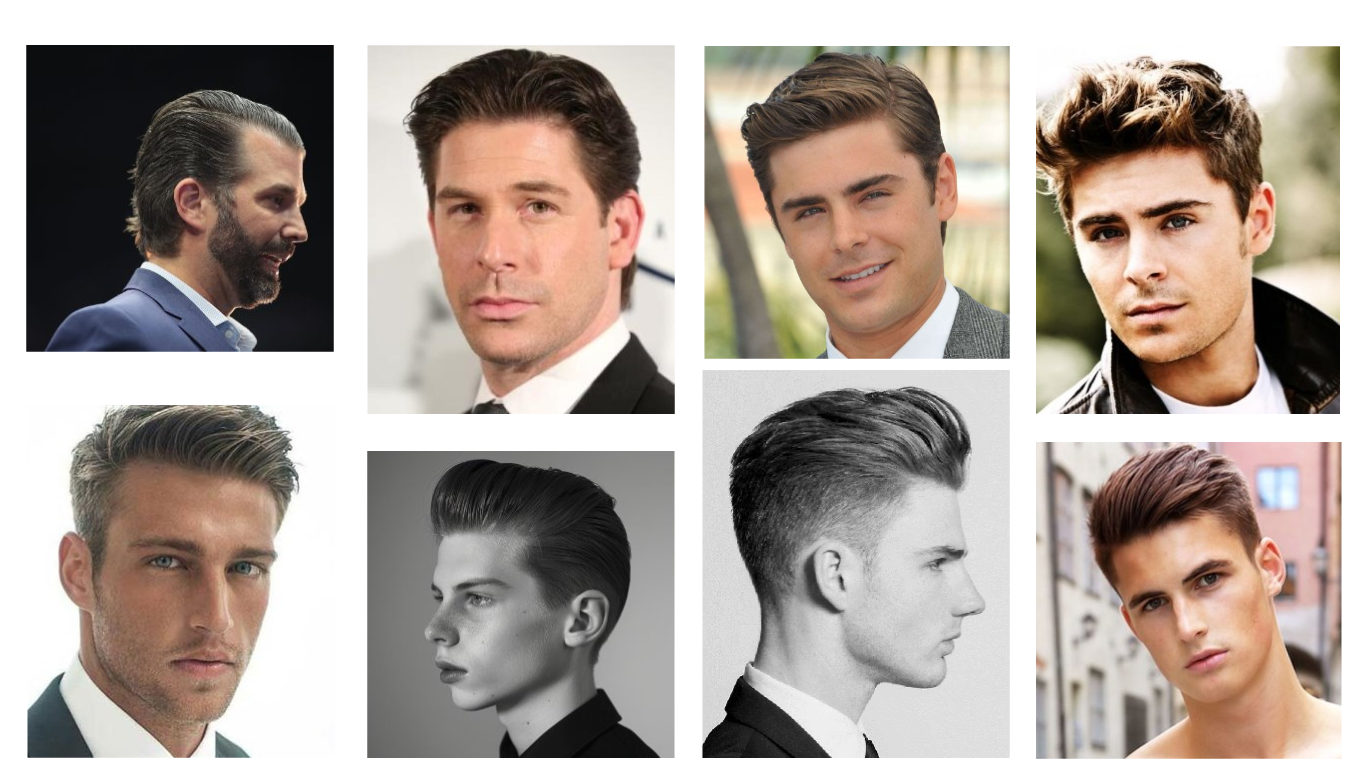
Act One. Done. Rehearsal
26/11/2024
At tonight's rehearsal, we completed a full runthrough of Act 1...
As show week creeps closer, the rehearsals get more exciting as we begin to see everything come together. Tonight was one of those rehearsals. Tonight we ran the entirety of Act 1 with props, set, all ensemble and dancers.
Utilising A Mirror...
25/11/2024
The bathroom mirror isn't just for admiring youself after you come out of the shower, it can also be great to act in front of...
Acting in front of a mirror is a valuable tool for performers as it allows them to observe their facial expressions, body language, and gestures in real-time. This practice helps develop greater self-awareness and refinement of physicality to align with the character being portrayed. By seeing themselves as the audience would, performers can identify and correct inconsistencies or over-exaggerations or under-exagerations, ensuring their actions are both authentic and impactful.
My mirror has seen me do some very perculiar things. Especially tonight as I blessed it with a solo performance. I wanted to focus mainly on facial expressions and create a list of parts within scenes in act 1 where I thought my facial expressions could use some improvement.
Here is said list:
1. (Scene 4) - When Elle surprises Warner by turning up at Harvard
2. (Scene 4) - Pulling Elle aside
3. (Scene 4) - Shocked face as Elle gets her "academic roster" from Emmett
4. (Scene 5) - When Callahan introduces law school
5. (Scene 5) - When Elle asks a question
6. (Scene 5) - When Vivienne throws Elle out
7. (Scene 6) - Telling Elle that Vivienne is my new girlfriend
8. (Scene 6) - When Vivienne "takes me back to her place"
9. (Scene 8) - When Elle enters the party as a bunny
10. (Scene 8) - During the song "Serious Reprise"
11. (Scene 8) - When Elle declares she thinks she could get Callahan's internship
12. (Scene 8) - When Vivienne gets chased off stage
13. (Scene 8) - When Elle wins her case
14. (Scene 9) - During so much better
With my list all in order, I decided what emotion I would like to express in each moment with a new list:
1. Express utter disbelief and shock as well as some confusion
2. Be almost somewhat embarrassed of Elle
3. Be confused
4. Be in awe of Callahan, look up to him as a God
5. Be embarrassed and act up making fun of her with Vivienne
6. Feel bad for Elle, but act up when Vivienne looks
7.
8. Act excited sexually and creepily
9. Act excited sexually and creepily again
10.
11. Be condescending
12. Don't know what to do
13. Be jealous and cross
14.
But I'm not done with lists just yet... for my final list, I will describe how I will use my face to portray these emotions:
1.
Face: Eyes wide open and brows raised. Blink fairly rapidly. Drop jaw open and move it slightly as if trying to say something but failing. Jerk head slightly backward and tilted.
Body: Hunch slightly forward with arms loosely hanging. Exaggerate breathing with short, shallow breaths.
2.
Face: Mimic a blush by lightly rubbing back of neck. Avoid direct eye contact with others. Head down.
Body: Shrink slightly into self by hunching shoulders. Fiddle with collar. Position self as if to block others from seeing her.
3.
Face: Eyes wide open and brows raised. Blink fairly rapidly. Drop jaw open and move it slightly as if trying to say something but failing. Jerk head slightly backward and tilted.
Body: Hunch slightly forward with arms loosely hanging. Exaggerate breathing with short, shallow breaths.
4.
Face: Open eyes wide. Slight upward gaze. Blink less frequently. Small, soft smile of admiration. Tilt head upward slightly. Nod slowly and deliberately when he speaks.
Body: Keep chest slightly lifted. Lean slightly forward.
5.
Face: Dart eyes between Elle & Vivienne (shows internal conflict). Look at Vivienne with slightly apologetic & embarrassed gaze. Bite lip. Fake a laugh. Look down.
Body: Slump into chair.
6.
Face: Avoid eye contact with Vivienne. Tighten jaw. When Vivienne looks, fake an exaggerated smile.
Body: Slump shoulders. Rub thumb on hand. When Vivienne looks, sit up more.
7.
Face:
Body:
8.
Face: Open eyes wide. Raise eyebrows. Grin and lick lips.
Body: Stand straighter. Lift chest. Tighten grip.
9.
Face: Drop jaw. Raise eyebrows.
Body: Cover crotch. Drop beer glass?
10.
Face:
Body:
11.
Face:
Body:
12.
Face: Dart eyes around the room. Furrow brows. Open mouth slightly.
Body: Fidget (tap/ clap self)
13.
Face: Tighten jaw. Lower brows.
Body: Tense up. Cross arms. Clentch fists.
With my plans in place, it was off to my bathroom mirror to put my theory into practise. This helped me to guage the appropriate levels of exaggeration and allowed me to refine my actions and expressions.
Overall, this session of exploration demonstrated a meticulous and thoughtful approach to character development, particularly in the realm of facial expressions and body language, which are both crucial elements of a strong performance in musical theatre. By using a mirror as a tool for self-assessment, I was able turn an ordinary bathroom ornament into an effective tool for refining microexpressions and ensuring clarity in emotional delivery. I focused on Warner's emotional journey, particularly his fluctuating confidence and awkwardness around Elle and Vivienne, to highlight my deep understanding of the character's motivations and relationships. The level of detail I put into breaking down each scene, from subtle discomfort to overt condescension, demonstrates my commitment to authenticity. However, I am aware that some descriptions, particularly for the more exaggerated moments, I risk becoming too theatrical if not balanced with naturalism. I used this exploration exercise to aid in my ability to gauge levels of exaggeration through mirror work helped to mitigate this risk, allowing me to tailor my expressions for maximum impact while maintaining believability. Ultimately, this methodical approach will enhance my stage presence, ensuring that every moment reads clearly to the audience, even from a distance.
I Went To The West End...
16/11/2024
As a surprise birthday present, my beloved parents took me to the capital to watch the greatest musical of all time: Les Miserables...
Usually when my father summons me into his office, it's to tell me off, so when he called me down that Friday evening, I enterred very nervously. Unusually for him though, he didn't tell me off, instead he told me that the following morning I would be getting the train at 7am to London to watch Les Miserables on the West End!
After a morning of walking 18 miles whilst sightseeing in London, it was nice to rest my feet in the Sondheim Theatre as I waited for the show to start. Despite never before seeing it live, only the 2012 film (which I've watched like 20 times) and the 10 & 25 year anniversary concerts, it is my favourite musical ever. I love the morals of the story and... The music is the single most epic thing about the show for me though. What's interesting and unique about Les Miserables is there is no spoken lines at all, it's all sung.
Suddenly, the lights dimmed and the music errupted as we were tranported from London to a 19th Century Paris jail.
Ian McIntosh portrayed Jean Valjean with nobility and tenderness, I especially liked his rendition of "Bring Him Home", which he rather impressivley sang completely in falsetto. His falsetto was incredibly weighted and rich. Stewart Clarke embodied the coolest character, the relentless Javert, though I did think he could have had more nuance in his portrayal. Lucie Jones offered a great performance of a raw and emotional Fantine, particularly during her heartrending performance of "I Dreamed a Dream."
The ensemble shined the most in my opinion though, with standout moments such as the seamless transition from "The ABC Café/Red and Black" into "Do You Hear the People Sing?" which I felt really showcased the production's dynamic energy.
Luke Kempner and Claire Machin brought comedic relief as the Thénardiers, their physical comedy and timing added levity to the narrative.
Visually, the production was strikingly impressive, with Matt Kinley's elaborate set design that effectively transported us to 19th-century France.
While the production's length approached three hours!, it certainly didn't feel that long, as the pacing ensured sustained engagement. However, I thought that certain character portrayals, particulalry Javert's, lacked emotional complexity, especially compared to Phillip Quast's highly regarded portrayal. It was also interesting to see that even on the West End, actors still make mistakes, as I know every lyric to every song, I noticed that on a couple of occassions wrong words were sang in the wrong phrases, but to the unaquivicated audience member, this would have been unnoticable as the actors remained proffessional, and persisted on as if nothing had happened0.
Watching Les Misérables live was not just an incredible experience but also a valuable learning opportunity as a performer. Seeing professionals in action made me more aware of the nuances of acting, from vocal technique to emotional depth and stage presence. I was particularly struck by how even on the West End, mistakes happen, yet the actors carried on seamlessly, proving just how important professionalism and adaptability are in live theatre. It reminded me that no performance is ever "perfect," but what truly matters is how well you sell it to the audience. The show also reinforced the significance of energy, pacing, and commitment in keeping an audience engaged for nearly three hours. Overall, this experience has deepened my appreciation for musical theatre and given me plenty to think about as I continue developing my own performance skills.
Blocking The Party SceneRehearsal
08/11/2024
The party scene is one of the most fun scenes in the whole show, it also acts as a catalyst in Elle's volta...
The party scene in Legally Blonde serves as a pivotal moment in Elle's journey, highlighting her initial struggles to fit into Harvard’s elite academic environment while reinforcing the divide between her and Warner. The party itself is a sophisticated gathering of ambitious law students, dressed in elegant attire and sipping on posh beverages — a stark contrast to Elle’s arrival in a bright pink Playboy bunny costume. This moment visually underscores how out of place she is in this world, making her the object of ridicule rather than admiration.
My character, Warner, enters the party alongside his sophisticated and snobbish girlfriend, Vivienne. She reminds him of the significance of the people at the party, emphasising their privileged backgrounds and bright futures. This subtly reinforces Warner’s own motivations - his desire to align himself with a more “serious” and traditional path, which is why he broke up with Elle in the first place. Shortly after, he leaves Vivienne to fetch a drink of beer, only to be completely taken aback when Elle arrives in her revealing costume. His reaction is layered; on one hand, he is visibly stunned by her physical appeal, reigniting his past attraction to her. This leads into the song "Serious (Reprise)", in which he playfully leads Elle on, allowing her to believe for a brief moment that he still has feelings for her. However, his true feelings become evident when she confidently declares that she believes she has a shot at Professor Callahan’s prestigious internship. Instead of supporting her ambition, Warner cruelly laughs at her, reinforcing his view that she isn’t cut out for law school. This moment is a crucial turning point for Elle, as it marks the moment when she begins to see that she must prove herself, not to Warner, but to herself. Vivienne, who overhears Elle’s declaration, takes the opportunity to publicly humiliate her, further cementing her role as the antagonist at this stage in the show. By mocking Elle in front of the entire party, Vivienne reinforces the elitist attitude of their social circle while attempting to assert her own superiority.
When acting out this scene, I made deliberate choices to highlight Warner’s immaturity, superficiality, and internal conflict. At the start of the scene, when Vivienne speaks about the significance of the party guests and their prestigious backgrounds, I chose to act disinterested - delivering my lines with a casual, almost dismissive tone, avoiding direct eye contact, and slightly shifting my weight from foot to foot. This physicality and attitude served to reinforce Warner’s lack of true passion for this elite world. Deep down, he doesn’t genuinely care about status or politics; he is simply following the path that others (his family, Vivienne, and societal expectations) have laid out for him. This subtle choice helps establish his character as someone who is easily influenced and lacks the courage to pursue what he truly wants.
When Elle enters in a bunny costume, I wanted the tone of Warner’s character to shift entirely. I wanted to emphasise his immaturity and shallowness by reacting with exaggerated physicality: widening my eyes, raising my eyebrows, and letting my jaw drop to convey both surprise and infatuation. To add a comedic element, I pitched my voice slightly higher and slowed down my speech, as if Warner were momentarily dazed by Elle’s appearance. I also made a bold comedic choice by instinctively grabbing my crotch as if to hide a physical reaction, further playing into Warner’s juvenile nature and lack of self-awareness. I wanted this reaction to highlight how easily Warner is distracted by physical attraction, reinforcing his inability to see Elle as anything more than an object of desire rather than an intelligent and capable woman.
During "Serious (Reprise)", I wanted to create a stark contrast between Warner’s fascination with Elle’s beauty and his complete dismissal of her ambitions. To capture his dreamy, almost hypnotised state, I performed with a big, love-struck smile, looking up into the lights as if he were lost in a fantasy. My movements were slow and fluid, emphasising his temporary detachment from reality. This choice not only made the moment visually engaging but also reinforced Warner’s failure to take anything seriously - he is caught up in the idea of Elle’s attractiveness, but the second she brings up her ambition to secure Callahan’s internship, he snaps back to reality and instantly undercuts her confidence with laughter.
This moment in the scene is crucial because it reveals Warner’s true nature: he is a man driven by superficial desires who ultimately underestimates Elle. His laughter at her aspirations is not just cruel - it is a reflection of his own insecurities and inability to see beyond surface-level qualities. This moment not only humiliates Elle but also serves as a wake-up call for her, setting the stage for her transformation and determination to prove him wrong.
While I feel that my approach to this scene effectively captured Warner’s immaturity and superficiality, I also think that there are areas where I could refine my performance further. My exaggerated reactions to Elle’s entrance successfully add comedic value and reinforce Warner’s juvenile nature, but I could explore more subtle moments of internal conflict, perhaps showing flickers of hesitation or discomfort when he realises that Elle still has an emotional hold over him. Additionally, while my physical choices do emphasise Warner’s lack of seriousness, I could lean further into his manipulative side during "Serious (Reprise)," making it clearer that he is leading Elle on, even if only subconsciously. Strengthening this aspect would help make Warner a more complex antagonist rather than just a one-dimensional, immature ex-boyfriend. My disinterested demeanor when speaking with Vivienne worked well to highlight Warner’s lack of genuine connection to the high-society world she values, but I could have played up his performative nature, perhaps making subtle attempts to impress her before losing interest, further underscoring his internal conflict. Overall, I feel that my comedic choices are effective, but I could add more nuance to Warner’s underlying motivations and contradictions to enhance the depth of my performance.
How To Live Healthily As A Performer...
1/11/2024
Next term, I have to deliver a presentation on the topic of "How to live healthily as a performer"...
There's a lot to talk about when it comes to living healthily as a performer. If my presentation was going to be effective, I would need to strike a balance so that I can get important infomation accross without overwhelming my audience with an infomation overload.
I began by creating a list of all essential subtopics that I wanted to cover: Physical Health, Mental Health, Nutrition & Hydration, and Rest & Recovery. Within each of these subtopics, I created further subtopics to cover the specifics for each topic. For these subsubtopics, I created a sort of general formula for what to include in each section. I decided that I would include a definition of each, then explain how they link to performing arts, then examples of methods to help with the topic raised, and finally I would explain the benefits of these methods.
With my topics, and subtopics in mind, I began to put together my presentation. After a while, I realised that I was including way too much information on each slide, which ended up being counterproductive in a way. I decided to disgard that presentation, and create a nicer looking, sleeker, more-refined presentation. Where there was still lots of information to get across, I split that up onto several slides so that they become easier to focus on.
My Original Disgarded Presentation
My Final Presentation
I Reviewed My SMART Targets...
30/10/2024
I'm about mid-way through the Unit 2 course, so it seems right that I should review my progress on my SMART targets...
Click to view my SMART Targets
Target 1 - To Increase My Vocal Range and Become More Comfortable Singing in My Head Register
Every Monday & Friday I have used a pitch recognition app to monitor the percentage of time that my pitch in within 10 cents of 0 whilst singing in my head voice. On the whole, I have been able to increase the percentage of time that I sing in tune whilst in head voice.
Throughout the past few weeks, I have had 30 minute solo singing sessions every Thursday, singing at rehearsals every Tuesday and Friday, group singing sessions every other Wednesday, and singing in my shower every evening!
Observe this graph:

The y axis is the percentage of time that I sing in tune whilst in head voice, and the x axis is the day of the recording. As the graph clearly shows, I have made progess on this target.
To actually achieve this progress, I have incorporated specific vocal exercises into my practice routine to strengthen my head register and expand my range. These have included sirens, lip trills, and descending scales starting in my mixed voice and transitioning smoothly into my head voice. By consistently working on these exercises, I have found it easier to access higher notes without strain.
Another method I have used is singing along to songs that challenge my upper range. I selected pieces that gradually pushed me slightly above my comfort zone, focusing on maintaining proper breath support and resonance. Examples of these songs include, "All I Ask of You Reprise" from Phantom of The Opera, and "Bring Him Home" from Les Mis. Over time, I noticed that notes that once felt out of reach became somewhat more managable, and my tone in my head voice became more controlled and less airy. I've also discovered that I can access the whistle register - something incredibly rare for anyone, let alone a bass!
During my rehearsals and group singing sessions, I have made a conscious effort to blend with others while still maintaining vocal confidence in my upper range. This has helped me develop more control and consistency in my head voice, even when singing in harmonies or transitioning between vocal registers.
And overall, the combination of targeted exercises, structured practice sessions, and performance-based application has allowed me to make clear progress towards my goal. While I still have room for further development, the steady improvement reflected in my recordings and pitch accuracy data confirms that my approach has been effective. Moving forward, I plan to continue refining my head voice by incorporating more sustained high-note exercises and experimenting with different vocal placements to achieve a fuller, more resonant sound.
Target 2 - To improve my control of my body through motion control and technique to improve my overall dancing ability.
To achieve this, I have consistntly completed a HIIT workout almost every day for at least 10 minutes, followed by a stretching session. This routine has helped me build strength, endurance, and flexibility, all of which contribute to better body control and technique in my dancing.
In addition to my daily HIIT workouts and stretching sessions, I have also incorporated targeted exercises to improve my balance, coordination, and core strength, all of which key components of effective dance technique. These have included stability drills such as single-leg balances, calf raises, and controlled plies to enhance my ability to stay grounded and execute movements with precision.
To further refine my motion control, I have been practicing fundamental dance techniques such as turns, kicks, and weight shifts. I have focused on slow, controlled movements before increasing speed, ensuring that I maintain proper form and alignment. This has been particularly helpful in sequences requiring smooth transitions and fluidity, as I have developed better awareness of how my body moves through space.
Attending dance rehearsals every week has also given me the oportunity to apply these techniqus in a performance setting. I have paid close attention to feedback from my teachers, and things I notice of myself in the studio's mirrors, making adjustments to my posture, foot placement, and arm coordination to achieve cleaner and more intentional movement. Video recordings of my rehearsals have further allowed me to analyse my execution and pinpoint areas for improvement.
Overall, my commitment to structured physical conditioning and technical refinement has led to noticeable progress in my dancing ability. I have gained greater control over my body, enabling me to perform choreography with increased confidence, precision, and ease. Moving forward, I plan to introduce more advanced balance exercises and refine my transitions between movements to further elevate my dance performance.
Target 3 - To Improve My Confidence When Performing
To build my confidence on stage, I took a multi-faceted approach that combined structured practice, mental preparation, and performance experience. One of the key methods I made use of was consistent rehearsal and repetition — the more I rehearsed my lines, songs, and blocking, the more comfortable I became with the material. This familiarity helped reduce nerves and allowed me to focus on my character rather than worrying about forgetting cues or lyrics.
I also implemented visualisation techniques, where I would mentally rehearse my performance before going on stage. This involved closing my eyes and imagining myself delivering lines and songs confidently, responding naturally to my scene partners, and engaging the audience with ease. This method helped me feel more prepared and comfortable when stepping into the performance space.
Another major factor in boosting my confidence was performing in front of smaller audiences before the actual show. During rehearsals, I gradually became more at ease performing in front of my peers and directors, which made the final performances feel less intimidating. Additionally, I took advantage of mock performances where I asked friends and family to watch certain scenes and provide constructive feedback.
To manage performance anxiety, I explored coping mechanisms. For me, I've found that distracting myself with music and exercise is a great way combat stresses and anxiety.
Reflecting on my progress, I can see a significant improvement in my stage presence. I no longer hesitate as much when stepping into the spotlight, and I feel more in control of my movements, expressions, and vocal projection. While there is always room for further growth, I now feel much more confident in my ability to perform in front of an audience. Moving forward, I plan to continue pushing myself out of my comfort zone by seeking out more performance opportunities and challenging myself with more demanding roles.
We Did A Full Runthrough (of the scenes we've blocked so far)... Rehearsal
25/10/2024
At our final rehearsal before half term, we attempted a full runthrough of every scene that we have blocked so far...
Today's rehearsal started in an unusually sad way, as we said farewell to our drama teacher, Mrs Pope as she leaves not only the school, but the country to seek a new life under the sun in Australia.
With Mrs Pope gone, we dived straight into our run through. The first scene that I was in is my solo song, "Serious". In the absense of my singing teacher, who had sailed off to Ireland, I decided to play a devious stunt. My request to transpose my solo song into C Major has been repeatedly denied, so today, in an attempt to prove to the directors that it sounds much better in C Major, I secretly ordered the music man to transpose it for me. It didn't go as perfectly as I was hoping, however, as I somehow subconsciously sang it an octave lower than I intended to - I only actually realised that I had done this after watching the recording back - let's just hope it didn't hinder my stunt too much!
After "Serious", I was called to get my photos taken for the show's program. This process took longer than expected for several unprecedented reasons. We have two casts for the show this year, so my counterpart took the remainder of the scenes in Act 1 as a result of my absence.
When Act 2 rolled around, I was back on stage, firstly for Act 2 Scene 1. In this scene, Warner is being introduced to his first legal case - a fitness guru who has been accused of her husband's murder. This goes into
I Applied Makeup... Lesson
24/10/2024
I always thought that makeup was just for girls... until today...
As a man, I know nothing about makeup. I've never had makeup applied to me or applied makeup to anyone before. So when told today that I would be applying special effects makeup to my face, I was skeptical.
Two proffesional makeup artists from University Centre Weston had come in to conduct a special effects makeup workshop. They began by providing us with some insight into the kind of makeup they do and provided images of some grusome looks that they have done.
They also mentioned the considerations that they have to take into account when applying makeup for stage, such as the stage lighting, the distance to the audience and other things.
They then demonstrated how to make a deep cut on your hand using makeup. She started by rolling some wax into a sausage shape, then placing it on the hand and merging it into the skin using a lollypop stick. She then used the lollypop stick to create an incision in the wax. She then used a combination of purples, blues, browns and greens to paint ontop of the wax to achieve a bruising affect. She then used some sort of jam-like substance in the incision to add some blood to the cut.
Now it was my time to shine, and put what I had just been taught into practice. I decided that I wanted to create a cut on my forehead. I followed all the same steps as the proffesional makeup artist, but I was not finding it as simple as she had made it look. I found that the most effective way to achieve a realistic look was to really focus on the colouring and blending of the colouring.
My finished look:
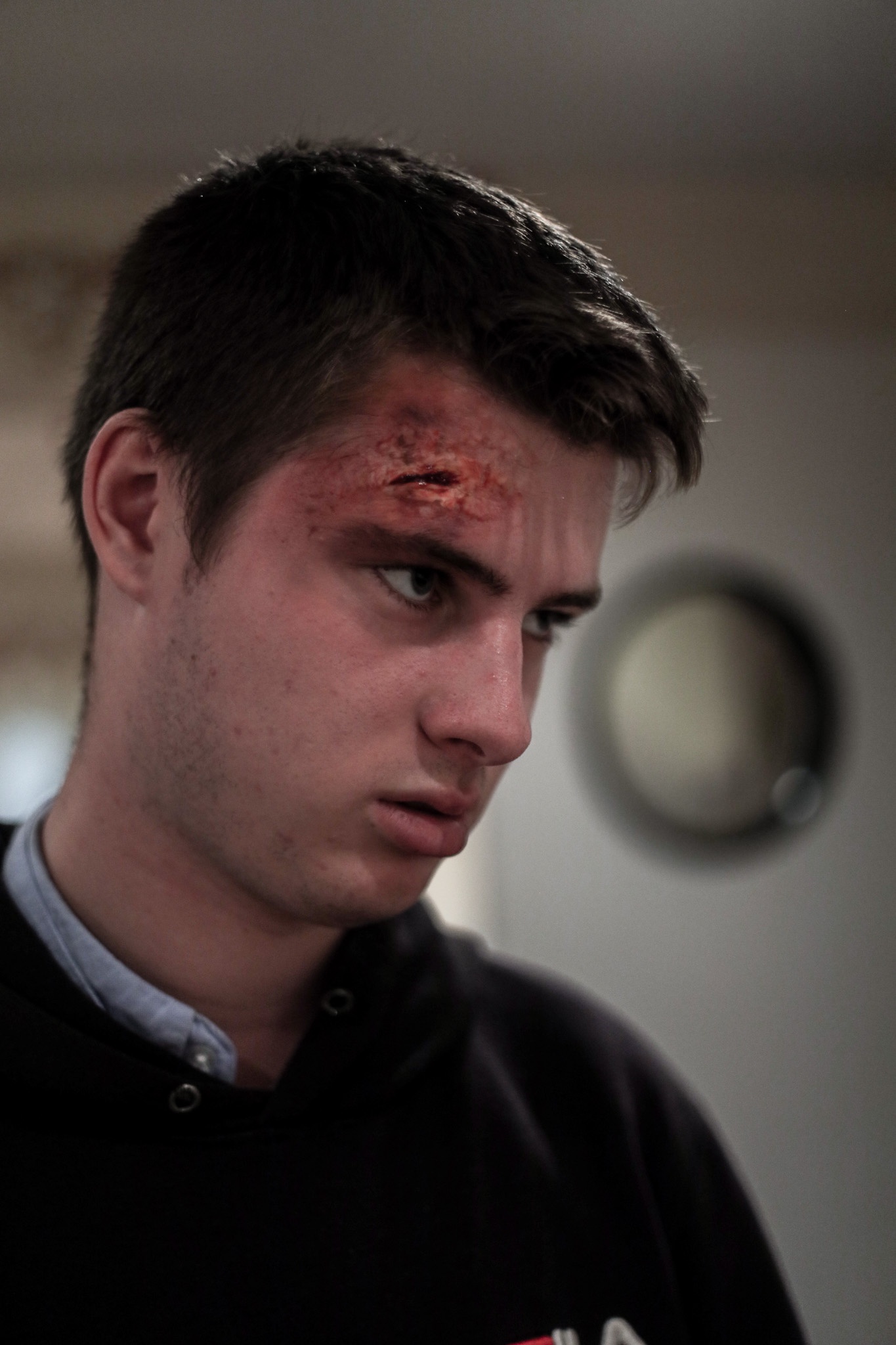
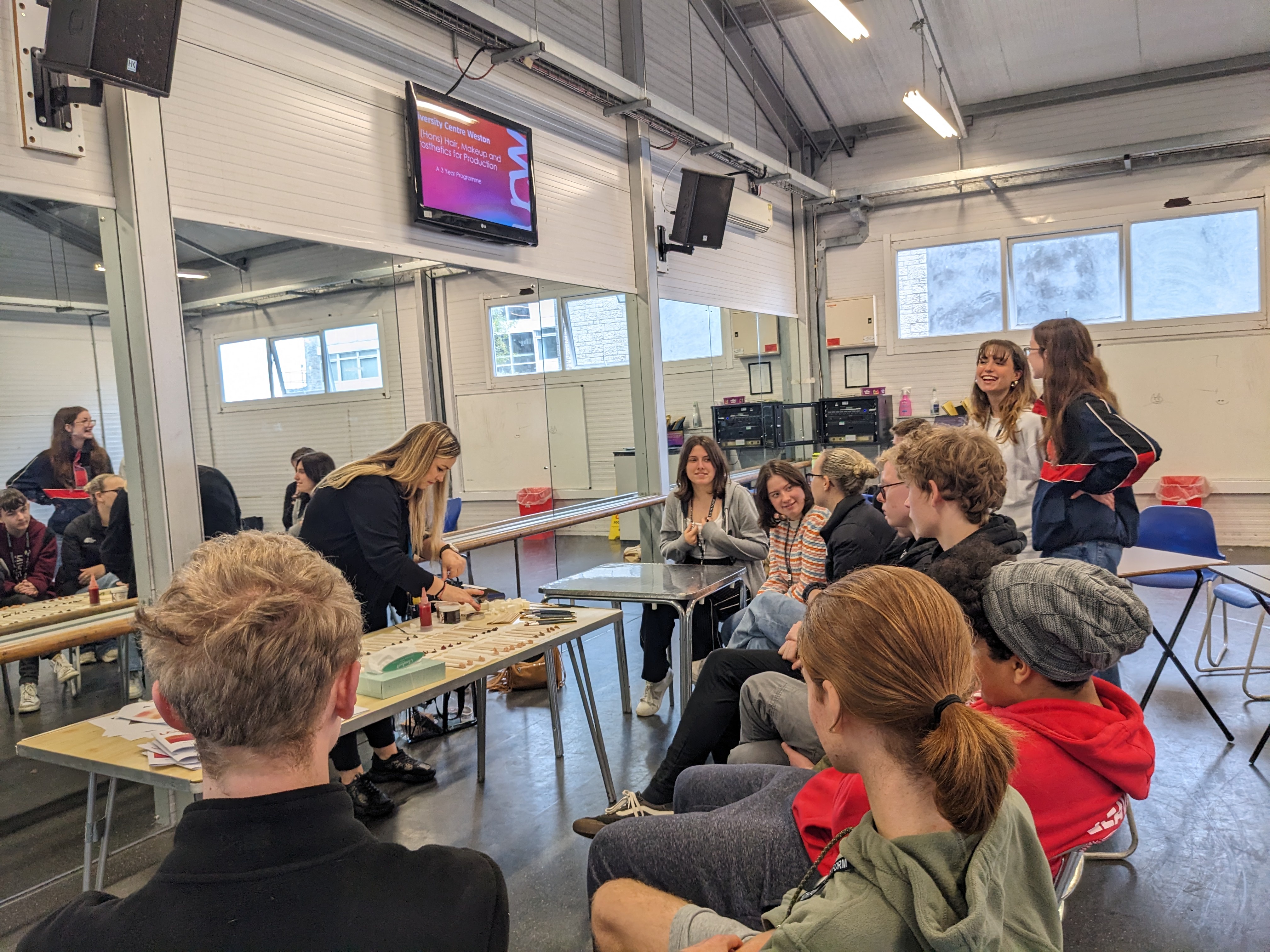
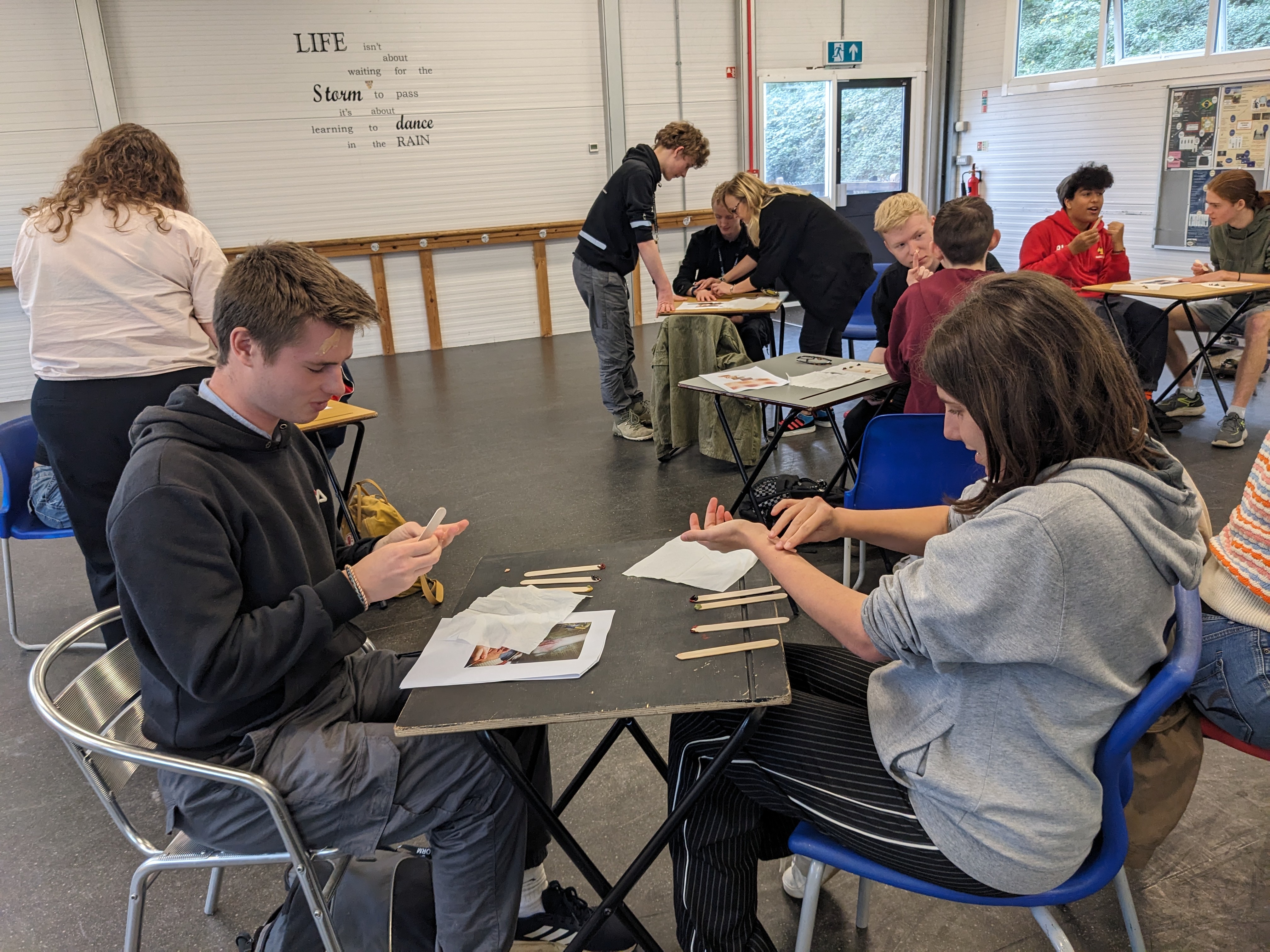
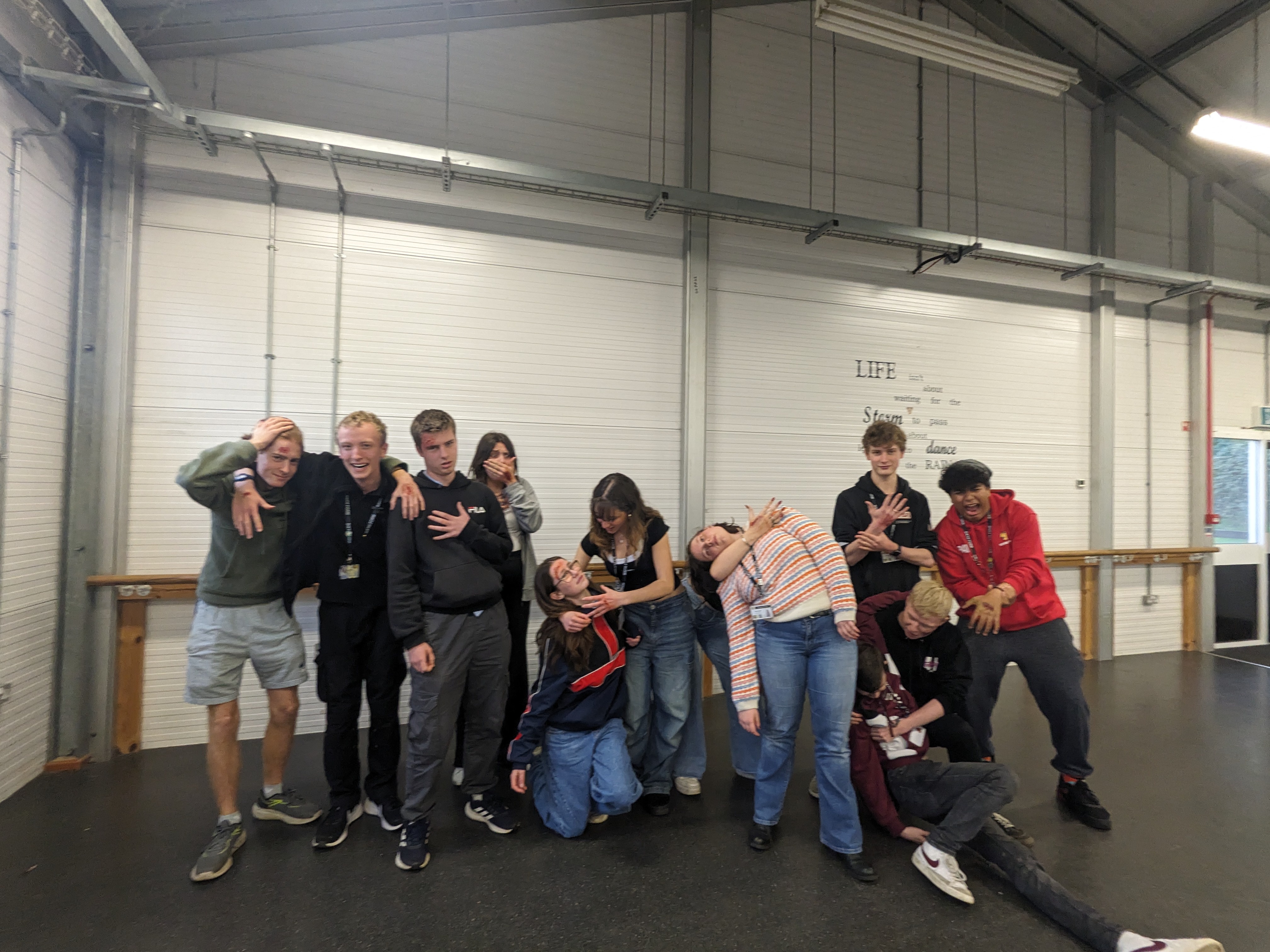
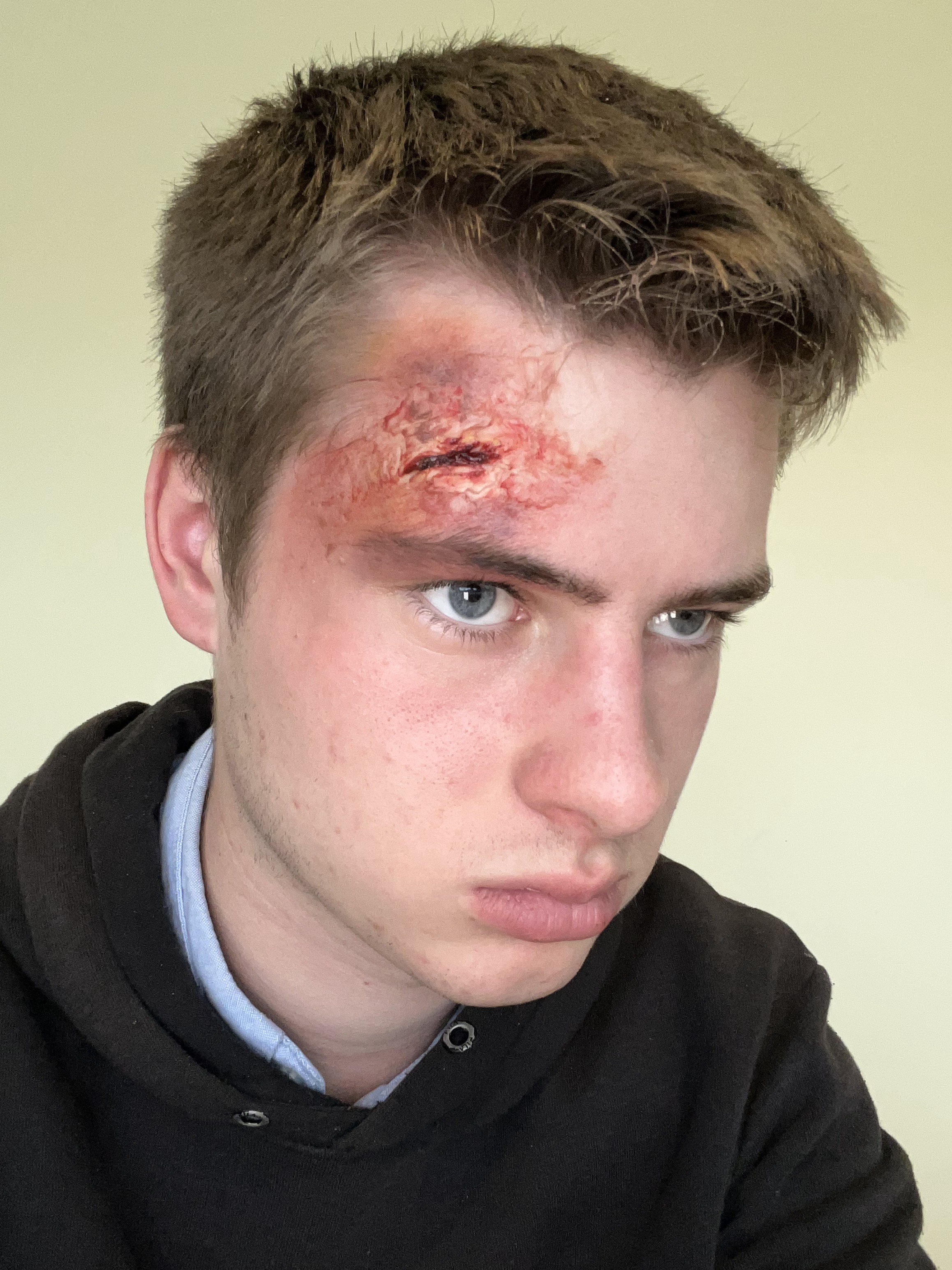
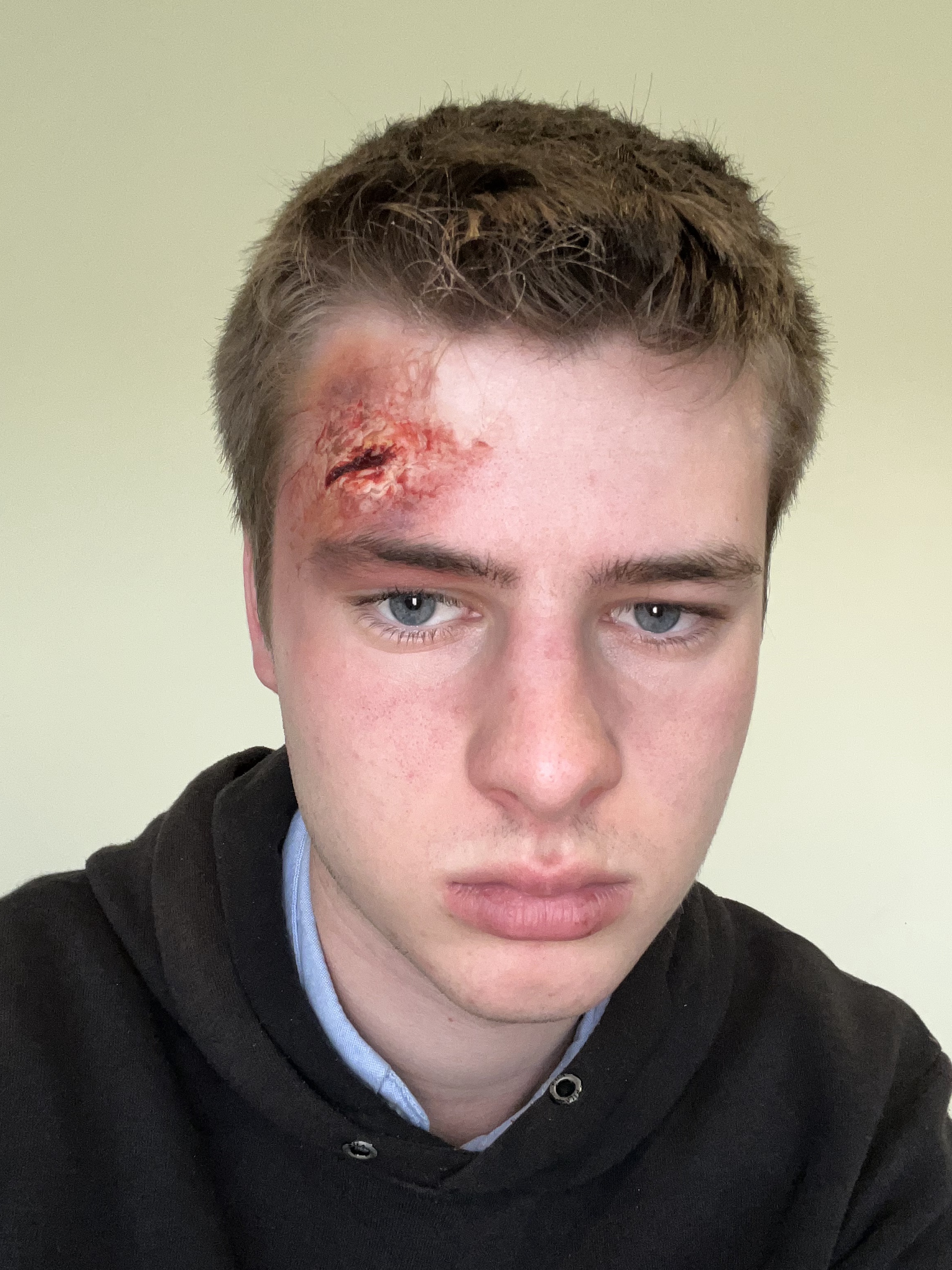
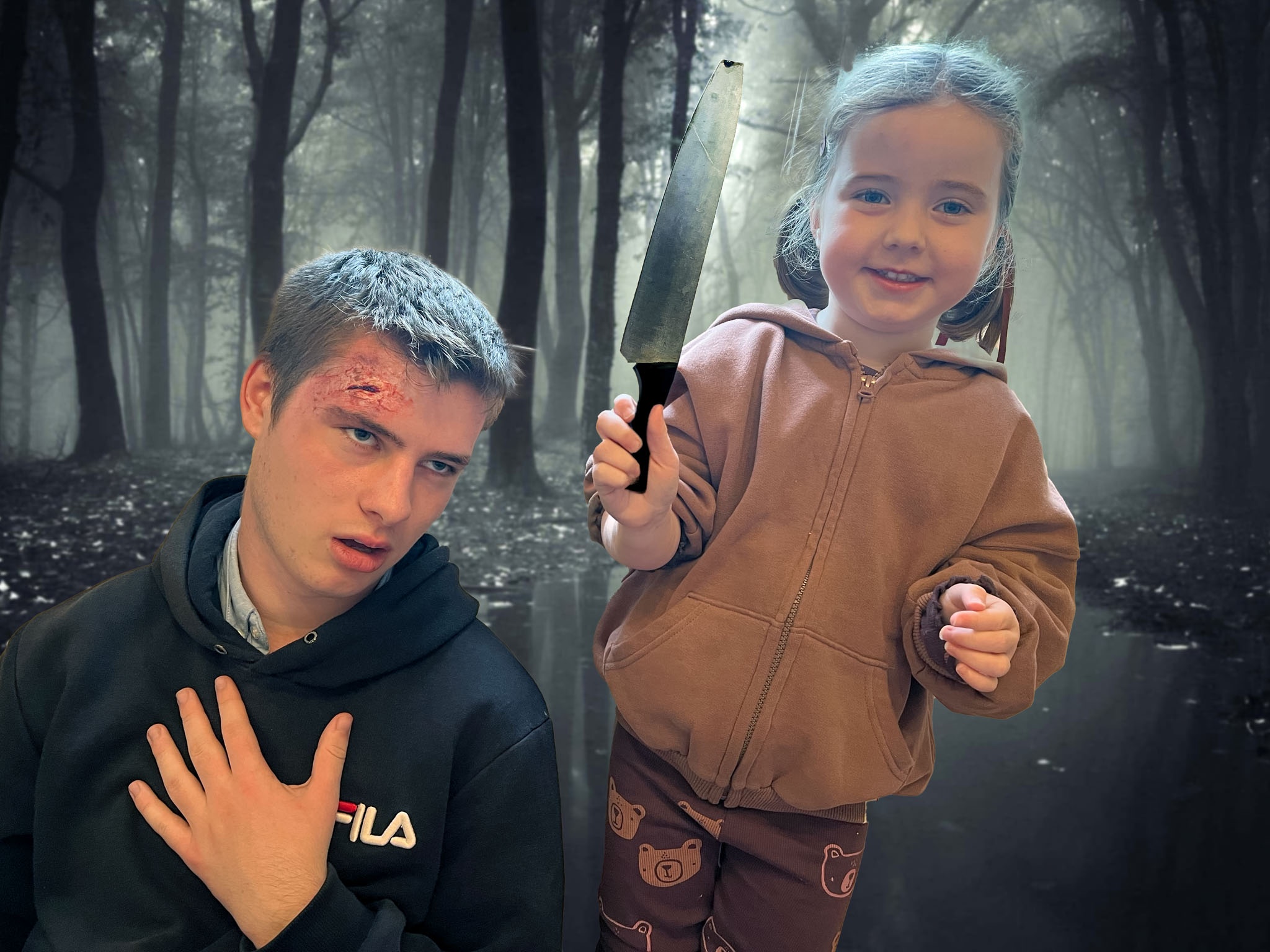
I Tried Irish Dancing... Lesson
23/10/2024
In today's dance lesson, I learnt how to Irish dance...
After my shabolic attempt at dancing in our last lesson, I kept an open mind when told that today I would be learning Irish dancing.
Our dance lesson kicked off with our usual warm-up routine: a lively combination of bouncing, jumping, and mobility exercises designed to get our hearts pumping and our muscles primed for movement.
The HIIT workout this week was 12 minutes. We did two lots of six exercises: Jumping Jacks, Squats, Running on the Spot, Mountain Climbers, and Burpees.
Sticking with my innovative genius of having a massive fan blowing full blast to cool me down during the plank challenge, I managed to hold my plank for 1 minute and 34 seconds this week - a whole entire 4 seconds longer than I managed last week!
Irish Dancing
As we would be learning Irish dance, it made sense that we started by learning the 6 positions of ballet. We had to master the oh-so-thrilling art of standing in six different foot positions, because apparently, Irish dancing demands more foot placement precision than a game of Twister. These positions are actually rather crucial since they pop up constantly in Irish choreography, so getting comfortable with them was a necessary evil. Next came posture, something for which Irish dance is not forgiving. I learned that you must keep your back straight, arms locked in place, and let your legs do all the work. This was a real challenge for me since I’m used to flailing my arms around when I dance, but after some serious discipline (and a few moments of frustration), I definitely saw progress. By the end, I actually managed to pull off a performance I was proud of, which isn’t too shabby considering it was my first attempt at Irish dancing!
play_circle
Watch: The Product of Our Irish Dancing:
I am handsome young man in the back left, wearing a white adidas top and blue tracksuit bottoms
And the results are in... Baseline
Assessment
Assessment
21/10/2024
Today I recieved the results of my baseline assessments in Acting, Singing & Dancing...
Acting Result
Click to view my performance
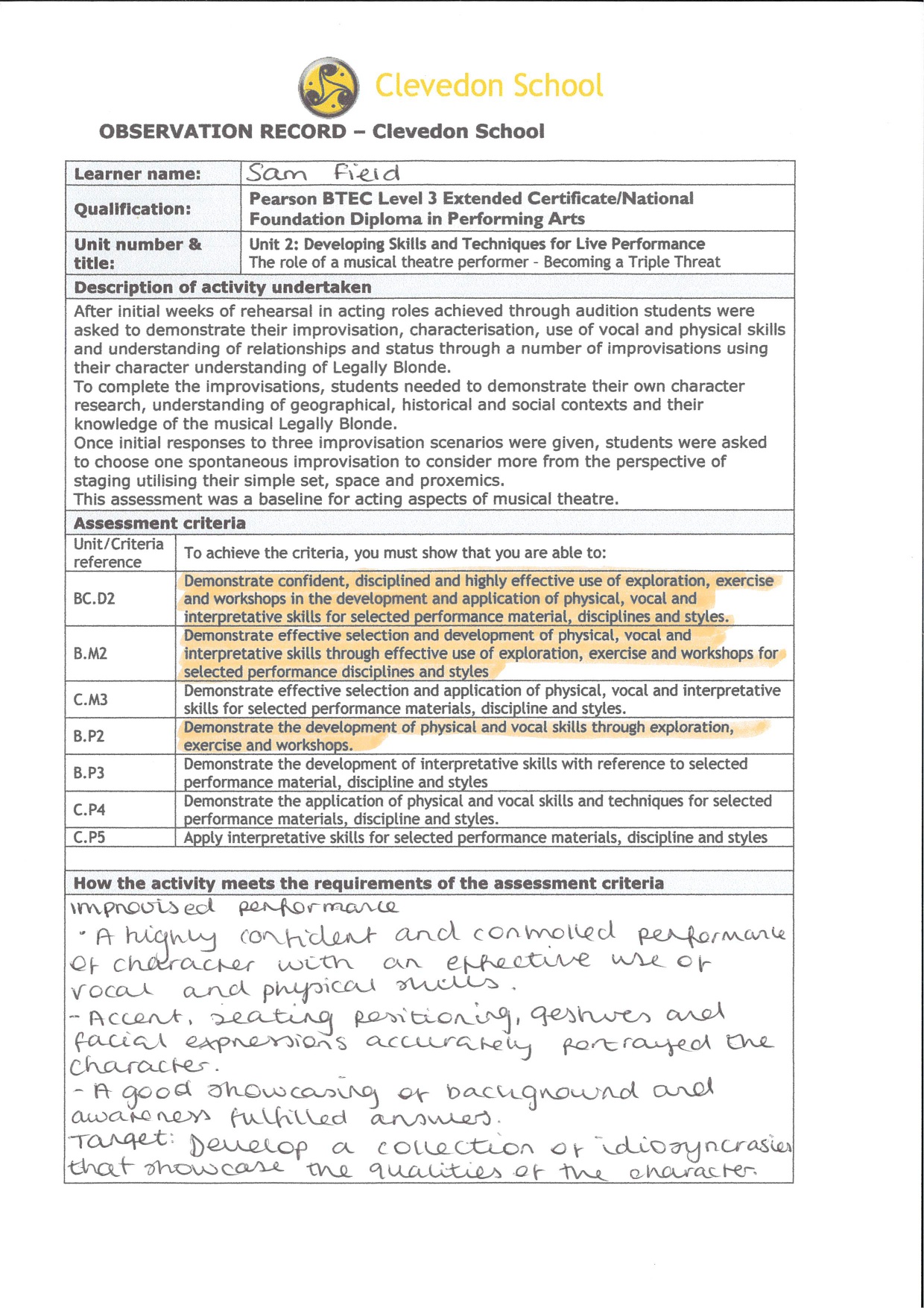
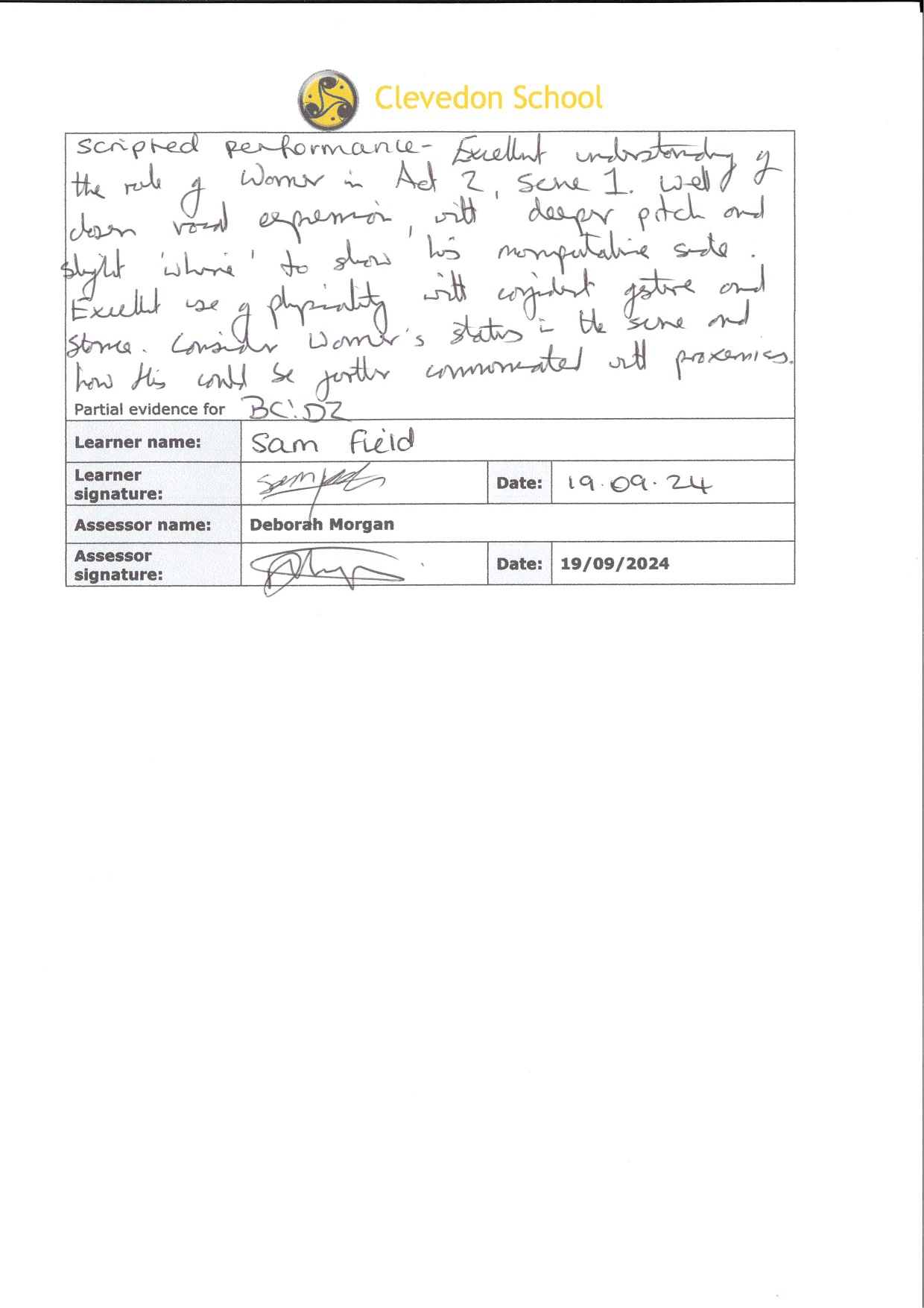
Dancing Result
Click to view my performance
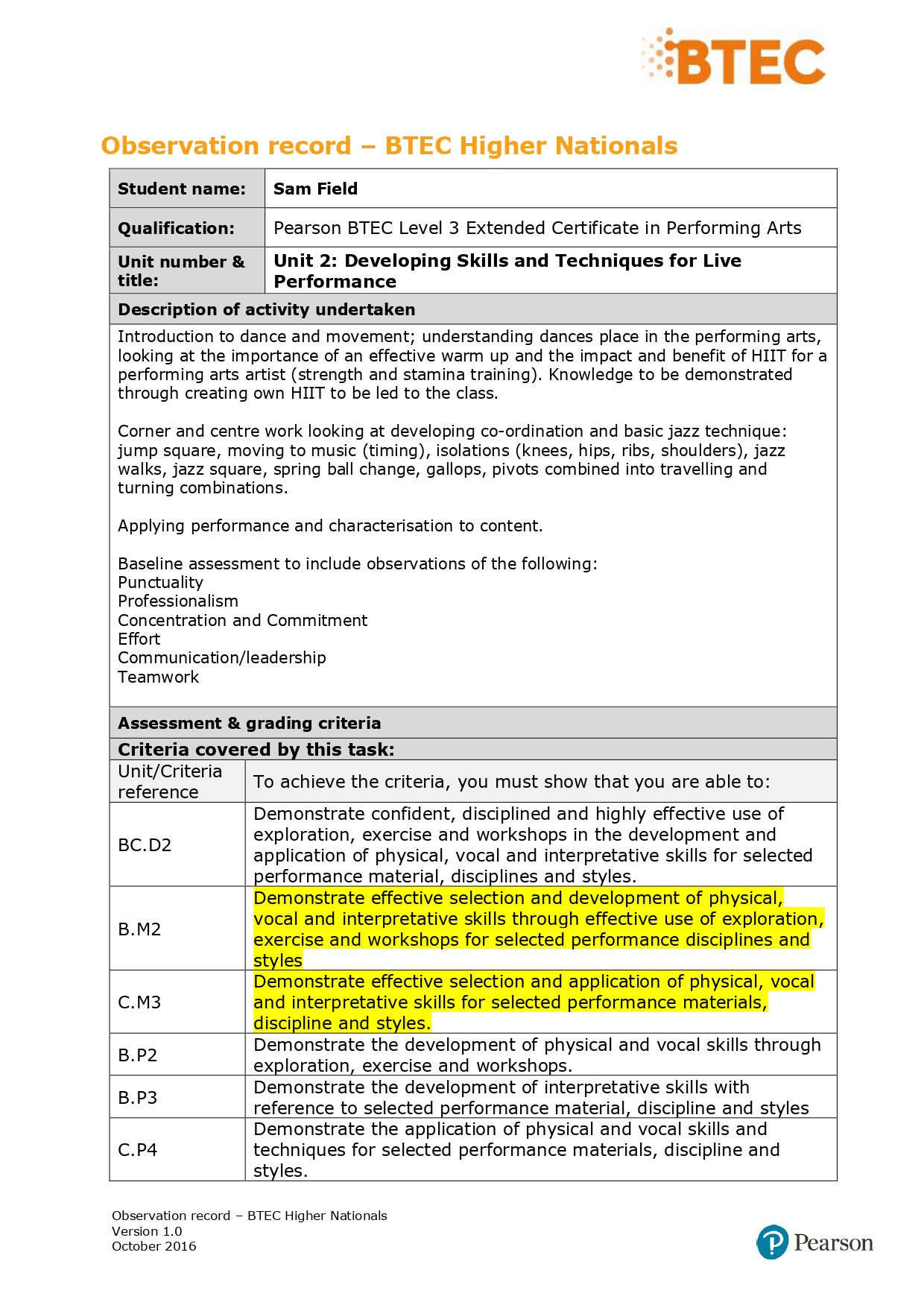
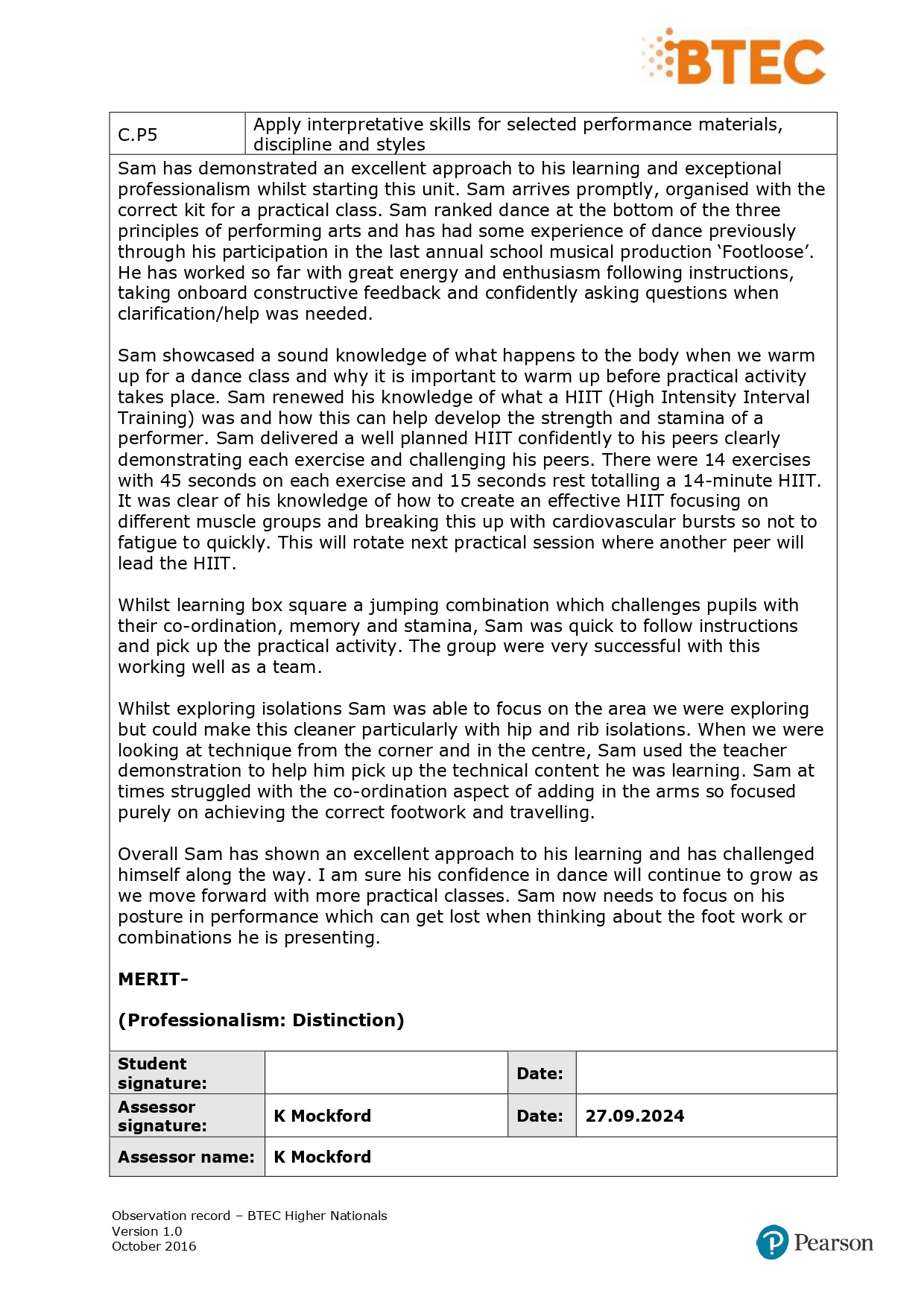
Singing Result
Click to view my performance
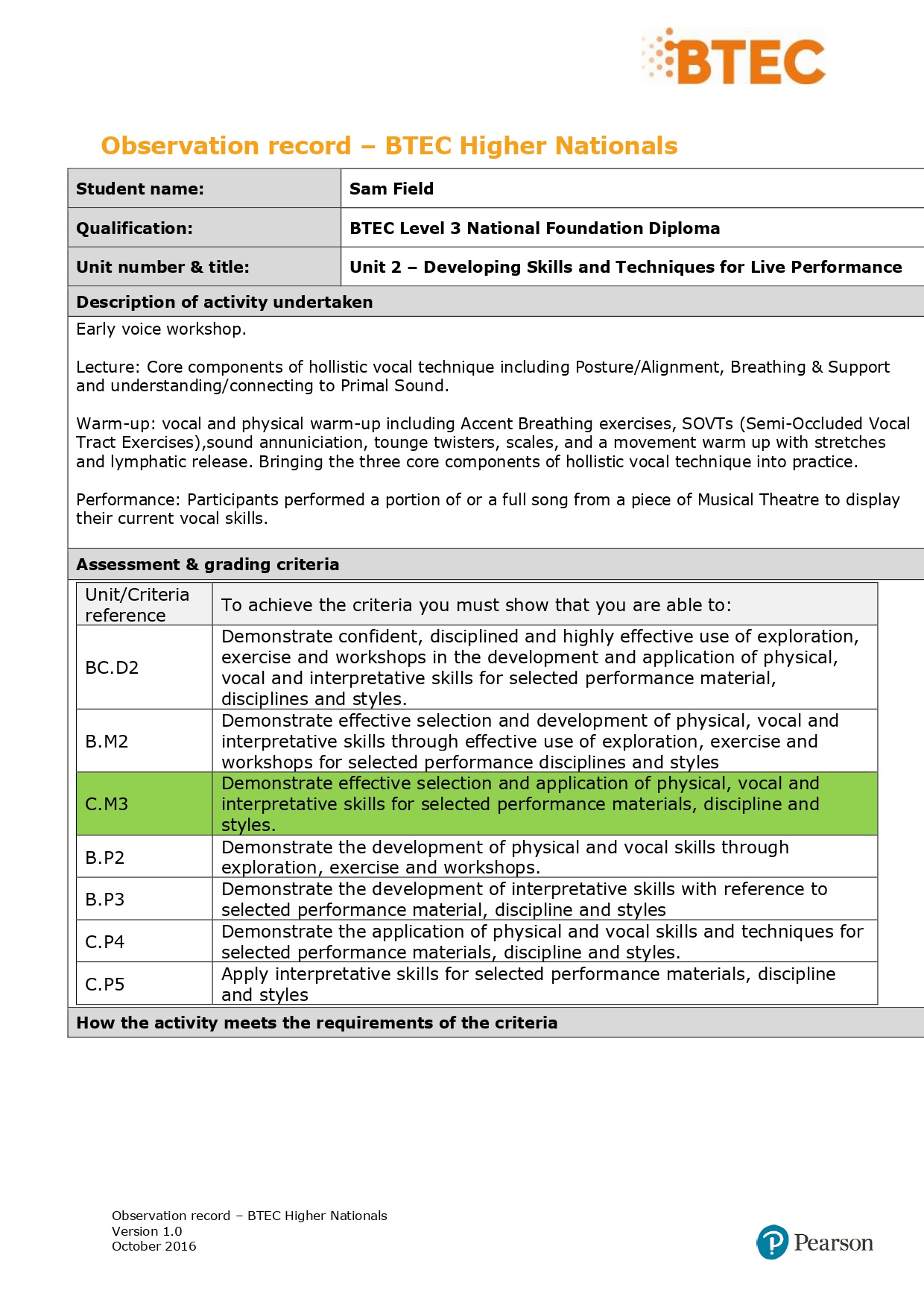
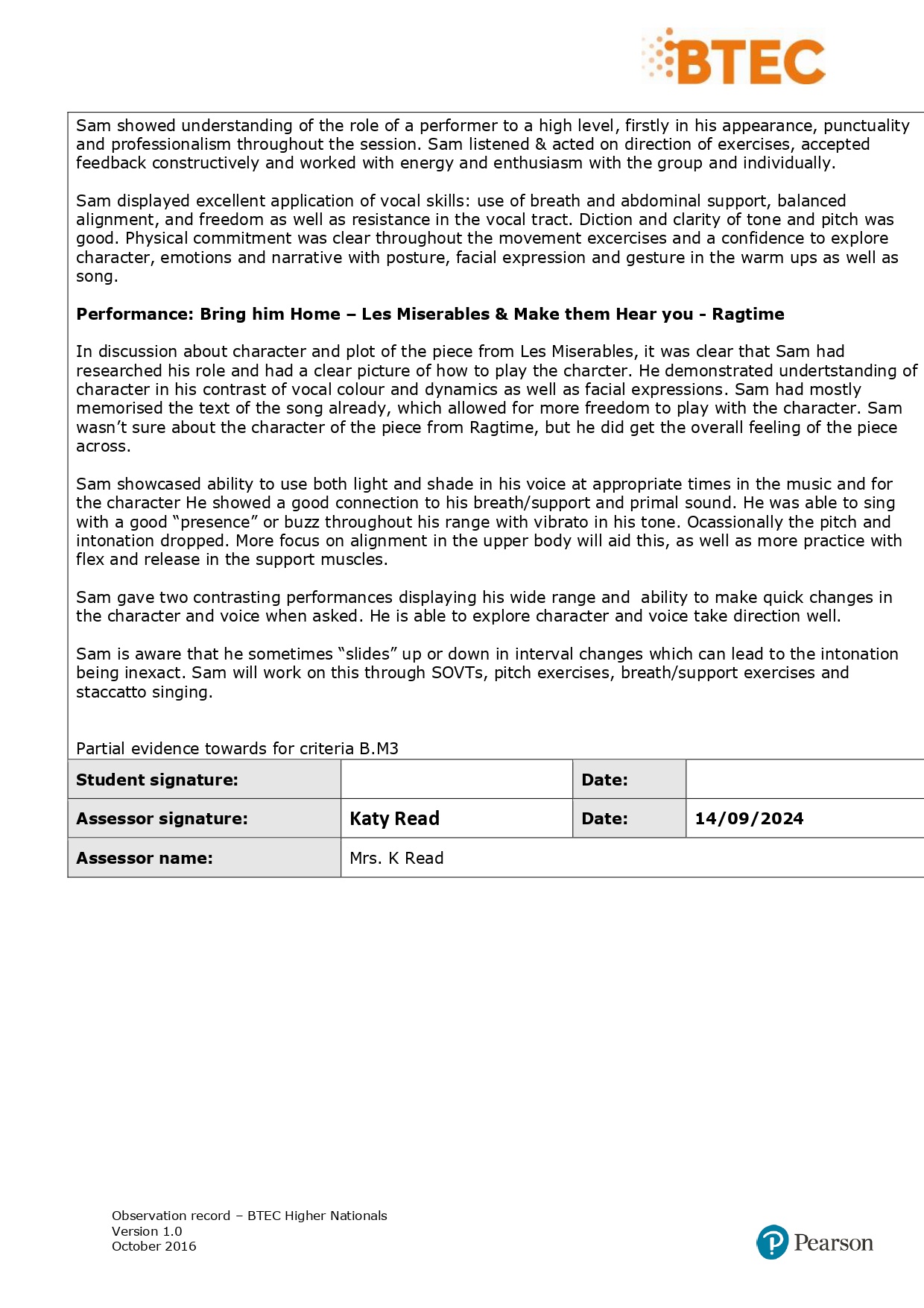
I Learnt How To Be Funny Lesson
17/10/2024
In today's acting lesson, we looked at comedy...
Comedy plays a vital role in theatre, offering more than just entertainment. It serves as a powerful tool to engage audiences, allowing them to reflect on societal issues, human behavior, and relationships in a lighthearted, accessible way. Through humour, playwrights and performers can challenge conventions, provoke thought, and encourage audiences to view life’s complexities with a fresh perspective. Comedy in theatre not only provides laughter but also deepens emotional connections, making serious topics more digestible and creating memorable, impactful experiences for both the performers and the audience.
That's why in today's acting lesson, we looked at comedy within a theatrical context. Our upcoming school musical, "Legally Blonde" leans heavily on humour, using exaggerated characters, witty & awkward interactions, and clever situations not only to entertain the audience but also to challenge and critique conventional stereotypes.
We kicked off the lesson by sharing our favourite comedians and what makes them stand out to us. For me, it's Sacha Baron Cohen. I love his work because his characters are hilariously over-the-top, and he masterfully blends quick wit with sharp satire. His ability to create outrageous personas that cleverly critique society makes his comedy both entertaining and thought-provoking, which is why he's my favourite.
We then discussed what makes something funny. There are two types of funny: expected humour and unexpected humour. Expected humour is something that is predictable, like the punchline to a joke. Unexpected humour often has a greater impact because it catches you off guard. It's the kind of humour that surprises you, like an unexpected twist in a scene or a character reacting in a way that you didn't anticipate. This element of surprise makes it even more hilarious.
Exercise 1 - "Arms"
With the theory of humour in mind, we conducted an exercise. We arranged two chairs facing each other, with someone seated in each chair. Meanwhile, two others knelt behind each chair, extending their arms under the seated person’s shoulders, creating the impression that the arms belonged to those sitting. We would then be given a scenario to play out. The person on the chair would be improvising their speech, and the person controlling their arms would try to conduct movements and gestures that matched the person's speech.
When it was my turn, I sat on the chair with someone else controlling my arms. Our scenario was that I was being interviewed for a position as an acrobat in a circus. We didn’t have much time to plan, so I decided to make my character seem hilariously out of place at the interview, acting arrogantly naive and completely oblivious to the seriousness of the situation.
Unfortunately, we didn't film the exercise, but I have created a transcript:
Interviewer "So, have you ever been in the circus before?"
Me "No"
Interviewer "Ohhhkaayyy, well, do you have any experience in acrobatics at all?"
Me "No"
Interviewer "So what makes you think you can be an acrobat in the circus then?"
Me "Well my wife always tells me I'm a bit of an acrobat in the bedroom."
Interviewer "Interesting. Do you have any other testimonials?"
Me "No. But I've got proof what I can do stuff coz one time I was on holiday at the seaside and I jumped off of this like really high rock lots of times and like I did land on my side and shatter my spine, but at least it shows that I can move sideways and each and every way whilst in the air and that"
Interviewer "Hmmm. I see. Well, the circus is in America. Have you ever been to America before?"
Me "What's America?"
Interviewer "Do you have a passport?"
Me "No"
Interviewer (sarcastically) "Oh well that is a shame. You can't join the circus if you don't have a passport."
In this scene, I utilised the concept of unexpected humour to portray my character as comically clueless and out of touch. The contrast between the interviewer's straightforward, serious questions and my absurdly naive responses created comedic tension. My character's overconfidence, despite having no qualifications for the role, is a classic comedic trope that hightens the absurdity.
Things that I did to make the scene funny:
Recurring "No" Responses: My repeated, abrupt delivery of "No" in response to the interviewer's questions added some deadpan comedy. The naive bluntness of my character’s refusals, without any elaboration or concern for how unqualified they sound, made the scene even funnier.
Out of Place Character: By making my character appear overly confident in a situation where he clearly didn’t belong, I added humour through obliviousness. The arrogant yet naive attitude makes the character more ridiculous, especially when I offered nonsensical "qualifications," like the wife’s acrobat comment or the seaside story.
Absurd Exeggeration: My responses escalated the humour with bizarre and exaggerated claims, like jumping off a rock and shattering my spine, which I delivered as if it’s a legitimate acrobatic achievement. The mismatch between my character’s confidence and his actual skills heightened the comedy.
Inappropriate Comments: My line about being “an acrobat in the bedroom” is an example of inappropriate humour, adding another layer of comedy through its awkwardness, further underlining how out of touch the character is. This is not something one should say in a typical interview!
Unexpected Ignorance: By not knowing what America is highlighted the comedic portrayal of ignorance. It was a clever way to round out the character’s lack of self-awareness and understanding, bringing the scene to a humourous climax.
Exercise 2 - A Scene
For our second exercise, we were put into groups of four, and given a scene to play out. The scene was a Dragon's Den pitch, delivered by a man called John, who is a bit clumsy and has slightly poor vision. John would be pitching his "Tent in a Can" product. We had five minutes to come up with a comical scene based on this.
Dirty Dancing Lesson
09/10/2024
Today, I "learnt" the choreography for the sultry song: "Bend & Snap"...
As a too cool for school kinda guy, I wasn't best please when it was anounced that in today's dance class I would have to learn the choreography for the "Bend & Snap". I knew all too well that this iconic number is often associated with a very feminine and flirtatious vibe, and I wasn’t sure how I would fit into that. But nevertheless, I kept an open mind and got my groove on!
Our dance lesson kicked off with our usual warm-up routine: a lively combination of bouncing, jumping, and mobility exercises designed to get our hearts pumping and our muscles primed for movement.
The HIIT workout this week was only 10 minutes, but an intese 10 minutes none-the-less. We did two lots of five exercises: Sidestep squats, Starjumps, Plank, Burpees, and Bicycle Crunches.
In a moment of pure genius, I came up with the innovative idea for this week's plank challenge, I would do it right next to a massive fan, blowing full blast to cool me down. Unlike last week, where we started the lesson with a plank challenge, this time we did the plank challenge after the HIIT workout. Not only that, but in the HIIT workout, we had already done a plank, twice over! With my ingenius fan setup, I managed to hold my plank for 1 minute and 30 seconds this week - a whole entire 4 seconds longer than I managed last week!
"Learning" Choreography
Slap a song on at a disco, and I can bust my freestyle dad-dance style moves out to my heart's content, but give me some choreographed moves to learn, and I'm all over the place. For last year's musical production of Footloose, executing the moves wasn't really so much of an issue for me, but rather remembering all of the moves and their order was where I really struggled. It took several three-hour rehearsals on three consecutive nights for me to actually nail the choreography for just one song. Today's dance was no different. Most of the moves, I was actually able to execute when we were just blocking them indivually, but when we put them together, I just completely forgot which move goes where. Dancing with the pace of the music was even worse.
Like I said, most of the moves I was able to execute quite well, but there were some where I really struggled. The actual bend and snap move I could do with my left leg behind, but not when my right leg was behind. I could not do a jazz pirouette at all.
So now I need to think: How am I going to get better at remembering dance moves? Of course, I need to do lots of practise, but is there anything else that I could be doing? After a quick brainstorming session, here are some ideas that I have come up with which I think could help me to better remember dance moves:
One thing that studying computer science has taught me is that every problem should be broken down into tiny, more managable pieces. I think that if I were to break down the dance into small chunks and practise those chunks individually until each one was perfect, then I would be better able to execute the dance.
Memory is all mental skills, therefore, it would probably be beneficial to run through the dance in my head whenever I can.
I could also use the music as a tool to help me remember the dance moves if I match certain moves to certain lyrics, beats or rythms.
In addition to breaking the dance down into smaller chunks, I could also practise at a slower speed, and gradually increase the speed at which I execute the dance.
Ultimately, it is going to take alot of practise for me to get better at dancing, but with an open-mind and enough determination, I truly believe that even someone as atrocious at dancing as I am, I can still learn and improve!
I Did Some More Acting Lesson
03/10/2024
Today's acting lesson was all about our reactions...
If there is one single thing that separates crap productions from epic stage spectacles, it’s the actors' reactions. Reactions are the heartbeat of live theatre - they bring scenes to life, drawing audiences into the story and making them feel every moment. No one wants to sit through a lifeless scene full of awkwardness and bland delivery. People come to the theatre to be entertained, moved, and inspired, and it's reactions that make the magic happen.
One thing that we needed to work on as a cast was our reactions - as our recent "Legally Blonde" rehearsals have made apparant. With so many scenes involving large groups of people on stage, it’s essential that everyone stays engaged and reacts to everything happening around them at all times. That was the main focus of this lesson.
To start, we played a game where we all walked around the room in different directions, but we had to maintain an equal distance from each other at all times. This exercise forced us to become hyper-aware of each other's movements and to react instantly to shifts in the space. Next, we were challenged to stop walking and stand still in unison, without any verbal communication. This heightened our awareness of the group and trained us to react quickly and in sync with the energy and actions around us.
Our next activity tested our ability to react to a stimulus on the spot. Mrs. Pope, our drama teacher, would present a scenario, and we had to quickly react to that by creating characters and interacting with each other based on the situation. It was a great way to sharpen our improvisation skills and test our reactions while staying in the moment. Some of Mrs. Pope’s prompts included: "You're at a shopping mall," "You're at the beach," "It’s your first day at school," and "You’re in a courtroom." Throughout the exercise, I found myself taking on a variety of roles — from a nerd to a court officer, and even a cameraman!
For our final "opening activity", we worked in pairs to create a scene based on a prompt we chose from a selection on the board. Once we developed the scene, the challenge was to perform it with varying levels of reactions to the other person. First, we delivered the scene with minimal reactions, offering only the bare minimum in response. Then, we performed the same scene again, but this time with completely over-the-top reactions. After exploring both extremes, our final task was to find the right balance of reactions that suited the scene, striking a realistic and engaging middle ground. My partner and I chose the prompt, "An old lady is lost while walking in the park." My partner took on the role of the old lady, while I decided to play the local park druggie. I lit an imaginary cigarette, noticing the old lady, and called out in a cockney accent, "Y'right, love?" My partner responded, "I'm looking for the ducks!" To which I replied, "Ducks!? Why the bloody fuck d'ya wanna see those boring fuckers!?" My partner, acting thoroughly unimpressed, began to walk away, but I quickly added, "I'll show you where the ducks are... for a fiver," trying to finesse the vulnerable old lady for some quick drug money.
My quick choice to play a druggie contrasts sharply with the role of a lost old lady, creating an immediate sense of tension and humour. The clash of personalities — the innocent, slightly confused old lady and the streetwise, somewhat aggressive park druggie — sets up a dynamic that was both comedic and uncomfortable. This contrast is a strong choice because it heightens the potential for conflict, making the interaction more engaging for the audience. I used a cockney accent, which reinforced the character of a gritty, rough-around-the-edges park druggie. My choice of informal, slightly aggressive language ("Y'right, love?" and "Why the bloody fuck d'ya wanna see those boring fuckers!?") fits the character and sets a sort of casual, yet confrontational tone. I also added an element of manipulation with my audatious twist: "... for a fiver!", showing my druggie’s opportunistic side. This not only pushed the comedic tension further but also gave the scene some more depth, suggesting that the druggie is motivated by money and has no real interest in helping the old lady at all. The scene allowed both my partner and I to react naturally to each other's choices.
For the remainder of the lesson, we looked at blocking a scene from our upcoming musical, "Legally Blonde" - The Courtroom Scene.
My Self-Assessed
Targets:
1. Think how I can utilise reactions for my character Warner in Legally Blonde
How I Will Achieve This:
1. - I will read the Legally Blonde script and finds moments when Warner's reactions to the scene or other actors can be implimented and determine which reactions to execute.
My Final Assessment (For Now!)LessonBaseline
Assessment
Assessment
02/10/2024
One more baseline assessment to go... the singing assessment...
I get incredibly nervous singing in front of people, so you can imagine how I felt when I found out I was going to be assessed on my singing. I was however, quite prepared for this assessment - I had picked my songs and knew them somewhat well. See my post: Exploring Repertoire
Today's singing lesson started as every singing session should - a warmup.
The Larynx & Vocal Registers
After warming up, we sat down and looked at something called the larynx, or in my English: the voice box. The larynx is a small but incredibly important structure located in the throat, just above the windpipe. It houses the vocal cords, which vibrate to produce sound when air passes through them. It's the larynx that allows us to speak, sing, and make all noises. By learning about the larynx, we gained insight into how sound is physically created in the body and how various factors, like tension, can affect our voice's tone, pitch, and quality.
After exploring the larynx, we took a look at vocal registers. Vocal registers refer to the different ranges of the voice. The primary registers we discussed include the vocal fry, chest voice, head voice, and falsetto. Vocal Fry is the lowest vocal register. The chest voice is the deep, rich sound that resonates more in the chest area, often used for speaking or lower singing notes. The head voice is a lighter, more resonant sound that vibrates higher up in the head, typically used for higher pitches. Falsetto, on the other hand, is a breathier, airier sound that’s often associated with a very high range.
Creating Harmonies
Moving on from the science, it was time to put our new-found knowledge into practice and start singing. Our goal was to create harmonies, blending our voices together to produce a rich, layered sound. To achieve this, we divided ourselves into sections based on vocal range. I sang the bass section, thanks to my ultra-deep voice.
The song we worked on was "So Much Better" from the musical Legally Blonde. Each section (bass, alto, and soprano) was responsible for singing a different harmony line, and we rehearsed these parts separately at first. In the bass section, I found that I could quite comfortably sing the correct harmony when it was just us singing on our own.
However, when the alto and soprano sections joined in, things became more challenging. With multiple harmonies happening at the same time, it was harder to stay focused on my bass line. The altos’ and sopranos’ melodies and harmonies were sometimes louder or more prominent, which threw me off, and I found myself drifting away from my part.
With the lesson time halfway through, it was now time for our baseline assessment. I had prepared two songs for this assessment, each chosen to show a different aspect of my vocal range and technique. And the contrast between these two songs was a great way to demonstrate the versatility of my voice.
1st Song - "Make Them Hear You" from "Ragtime"
The first song I performed was "Make Them Hear You" from Ragtime. I sang this in my chest voice, which is the register where my voice feels most powerful and resonant. The deep, commanding quality of the chest voice allowed me to convey the song’s message of determination and justice with strength and conviction. It felt natural to project the emotion of the song, and I could really lean into the rich, lower tones that my voice produces so well.
play_circle
Watch: My Baseline Singing Assessment of "Make Them Hear You":
Piano Accompaniment - https://www.youtube.com/watch?v=2i6Rl61Nh8c
2nd Song - "Bring Him Home" from "Les Miserables"
For my second song, I shifted into a completely different style and register with "Bring Him Home" from Les Miserables. This time, I used my head voice to hit the higher notes that this song demands. Singing in head voice always requires more focus and control, as the sound is lighter and more resonant in the upper part of my vocal range.
play_circle
Watch: My Baseline Singing Assessment of "Bring Him Home":
Piano Accompaniment - https://www.youtube.com/watch?v=S9rupHaTkt4
My Self-Assessed
Targets:
1. Increase my projection when singing low in my range
How I Will Achieve This:
Projection when low - I will work on optimising my posture: Straighten my neck, stand taller, relax my shoulders
Exploring Repertoire
29/09/2024
With a baseline assessment coming up, and yet another rainy weekend to fill, I decided to do some experimentations...
I have my baseline singing assessment coming up in just four days time, and so I need to decide what song I am going to sing for it. The song choice is completely up to me, so long as it is a song from musical theatre, and I have a few ideas of what I might like to sing. Therefore, I have dedicated this rainy weekend to experiment with a few different songs and decide which one sounds best for me. You may notice, I absolutely love the songs from the musical "Les Miserables", and I will not apologise for the fact that 99.9% of my repertoire exploration session will be songs from Les Mis.
For these experiments, I will be recording my singing using the mic on my headphones. Most of these songs I have never sang properly before, and these recordings will be the first time that I sing them properly for their entirety. Based on my initial recordings, I will analyse my own singing and try to find ways to improve it.
Song 1 - Bring Him Home, Les Miserables
Piano Accompaniment - https://www.youtube.com/watch?v=S9rupHaTkt4
I had worked on this song a few months ago with my singing teacher, Mrs Read, at her suggestion. It was this song that inspired me to go and watch, and later fall in love with the musical, Les Miserables. This song is quite a challenge for me to sing, as it is almost entirely sang in my head register, which for someone with an incredibly deep voice is a fair challenge. In this recording, I think that I conveyed good emotional expression as I attempted to establish a noticeable connection with the lyrics to aid in the storytelling aspect of this song. I also think that my softer dynamics were well controlled, with a consistent tone, showing that I had a good level of vocal maturity and sensitivity to match the song's mood. I also felt that my pitch accuracy was, for the most part, stable and controlled, especially in the mid-range. My vibrato was generally smooth and seemed to emerge naturally, it was also fairly even in terms of rate and depth. However, it was not all perfect, in fact it was far from it. Some of the higher notes sound like they could use more power and clarity. My breath control was not very good either, there are moments where my breath runs out before the end of a phrase, especially during more intense or longer sections. This affected both the support and the tone towards the end of those phrases. When moving between registers (chest to head voice), some transitions could be smoother. There’s a slight break at times when I switch between the two. I could also have added a bit more of a dynamic range to add intensity and contrast to my performance. There were moments where my vibrato feels a little uncontrolled or uneven, especially toward the ends of some sustained notes - this again could be linked to my poor breath support.
Song 2 - Suddenly, Les Miserables
Accompaniment - https://www.youtube.com/watch?v=gybt5zZ8Ij4
This is a song that I have never sang properly before, but I was very familiar with the melody as I have listened to this song lots of times before. In this recording, I think that my voice presented a lovely tone which suited the emotional depth of the song. I think that I showed a good sense of musical phrasing, especially in the softer sections where the lyrics are more introspective. And for the most part, my pitch is stable. In order to imporve, again, I think that breath control is definitely something to work on as at times, the ends of phrases can sound a bit strained or breathy. While my tone was consistent, adding more dynamic contrast could elevate the performance. The song has emotional highs and lows, and pushing the crescendos a bit more while softening the tender moments could have made a big difference in storytelling. Occasionally, some of the higher notes feel slightly off-pitch or strained. Probably due to my lack of preparation for the leap into those notes. And finally, my ennunciation was at times, not great - some words could be a little clearer, especially in quicker passages.
Song 7 - Master of The House, Les Miserables
Accompaniment -
Song 8 - The Runaway Cart, Les Miserables
Accompaniment -
This is a song that I have never sang properly before, but I am quite familiar with the melody as I have listened to this song many times before. In this recording, I think that I captured the emotional intensity of the song well, I presented a good sense of phrasing, which helps bring out the meaning of the lyrics and tells the story effectively. My vocal power was also put to good use here with some strong moments in terms of volume and power, which is perfect for a dramatic piece like this one. Now for the critiques: There are a few moments where my pitch wavers, especially during sustained notes. Once again, I really need to work on my breath control - some phrases sound slightly cut short and / or breathy. There is potential for more artisitc variation in volume dynamics to add more contrast and emotion to the song. My tone is solid but could be more resonant in places
Song 9 - All I Ask Of You, The Phantom Of The Opera
Accompaniment -
Song 10 - Make Them Hear You, Ragtime
Accompaniment -
This is a song that I don't know very well at all, but my singing teacher has suggested that I learn it because it suits my voice quite well.
I Studied Music
26/09/2024
In order to better analyse my own singing, I did some research into music...
I have a baseline singing assessment coming up next week, and I still need to decide what song I want to sing. In order to make the choice that will serve in my best interests, I have decided to conduct some super-curricular self study into music so that I can better analyse my own singing. Before the first COVID lockdown of 2020, I had been taking piano lessons for two and a half years, so I have a decent understanding of the basics of music theory. I have also been taking vocal lessons for the past year and a half, so I already have some understanding of Vocal Technique. I am hoping that my study will help me to delve deeper into the music world and enable me to better understand the music that I sing.
Basic Music Theory
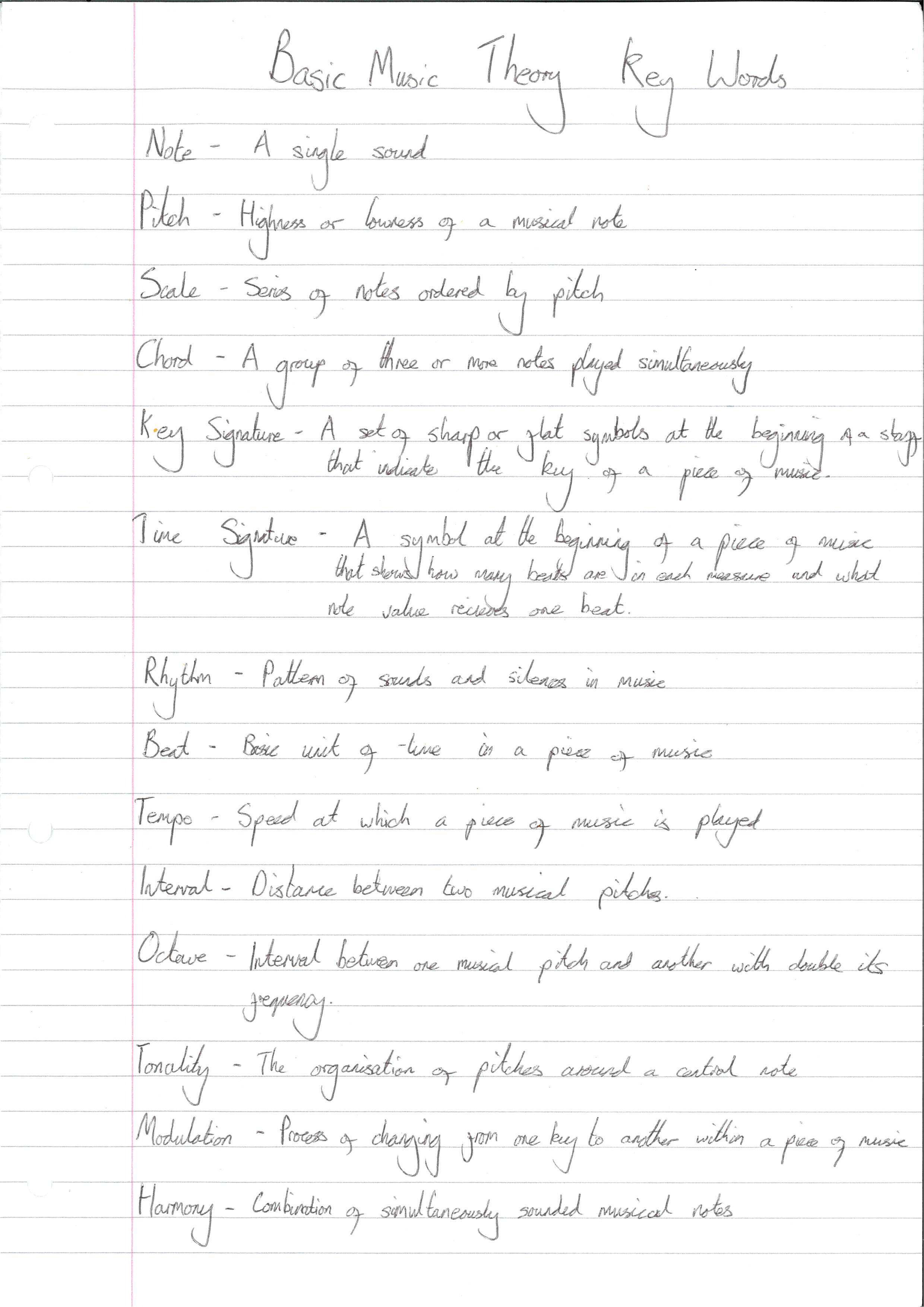
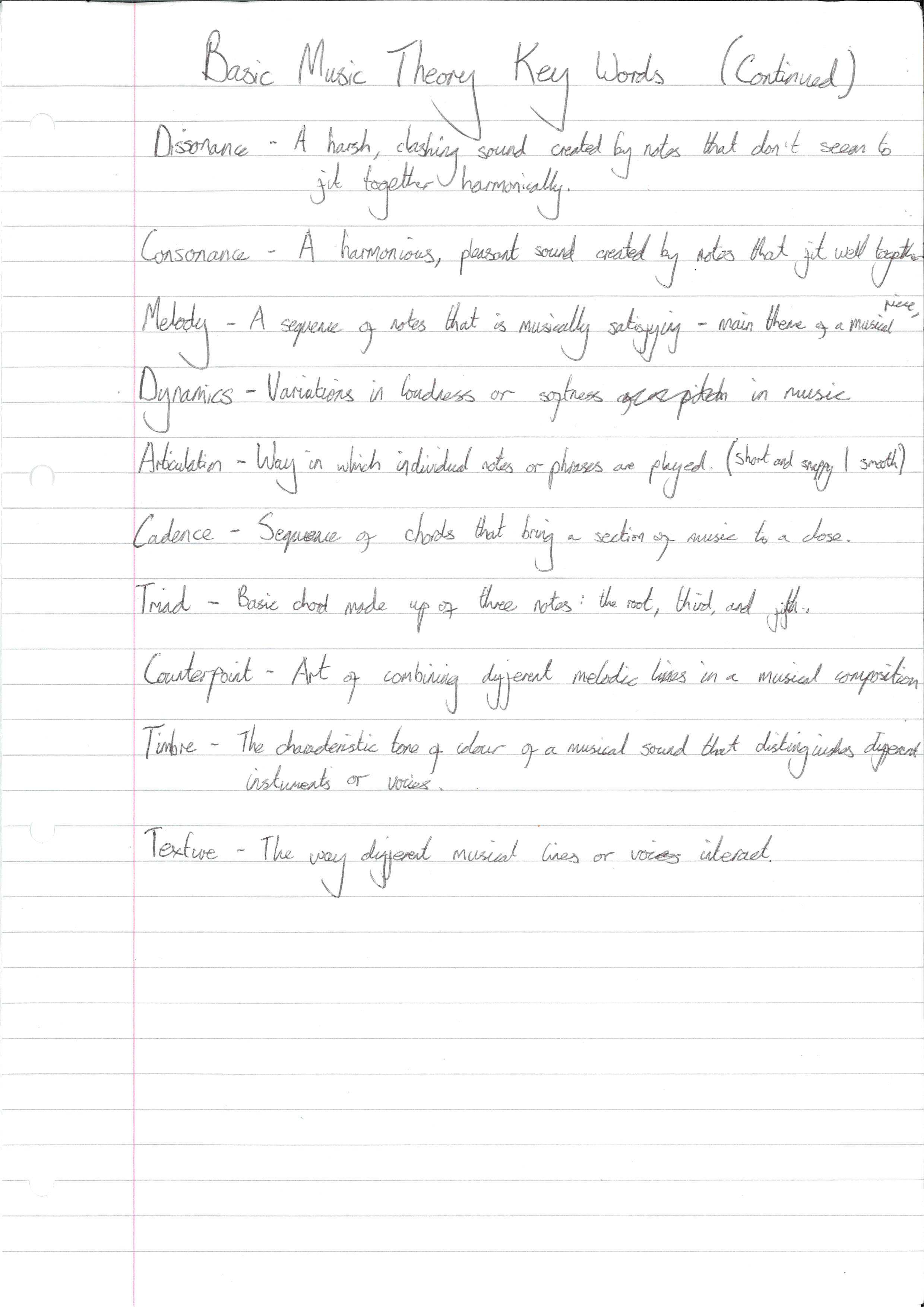
Vocal Techniques
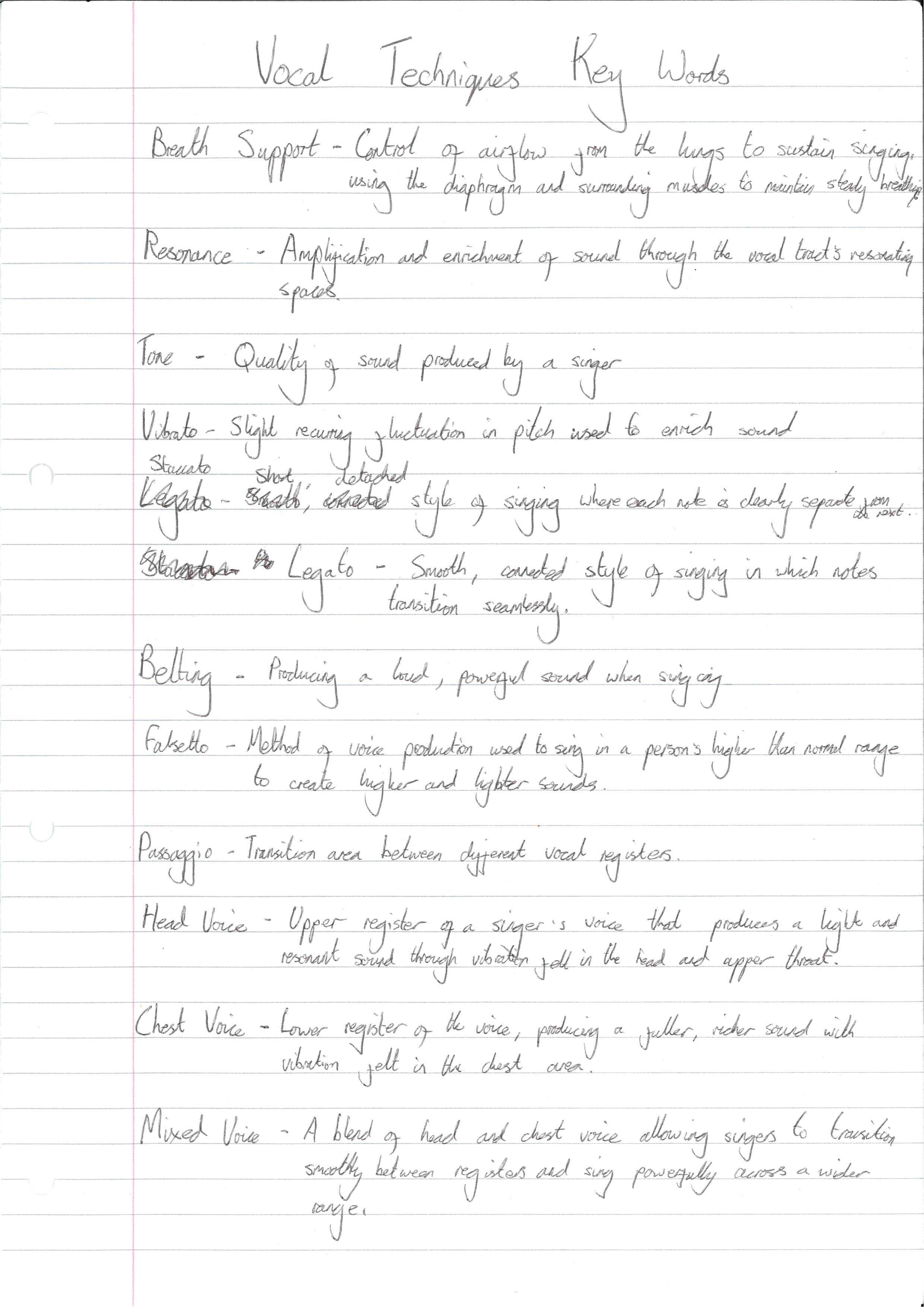
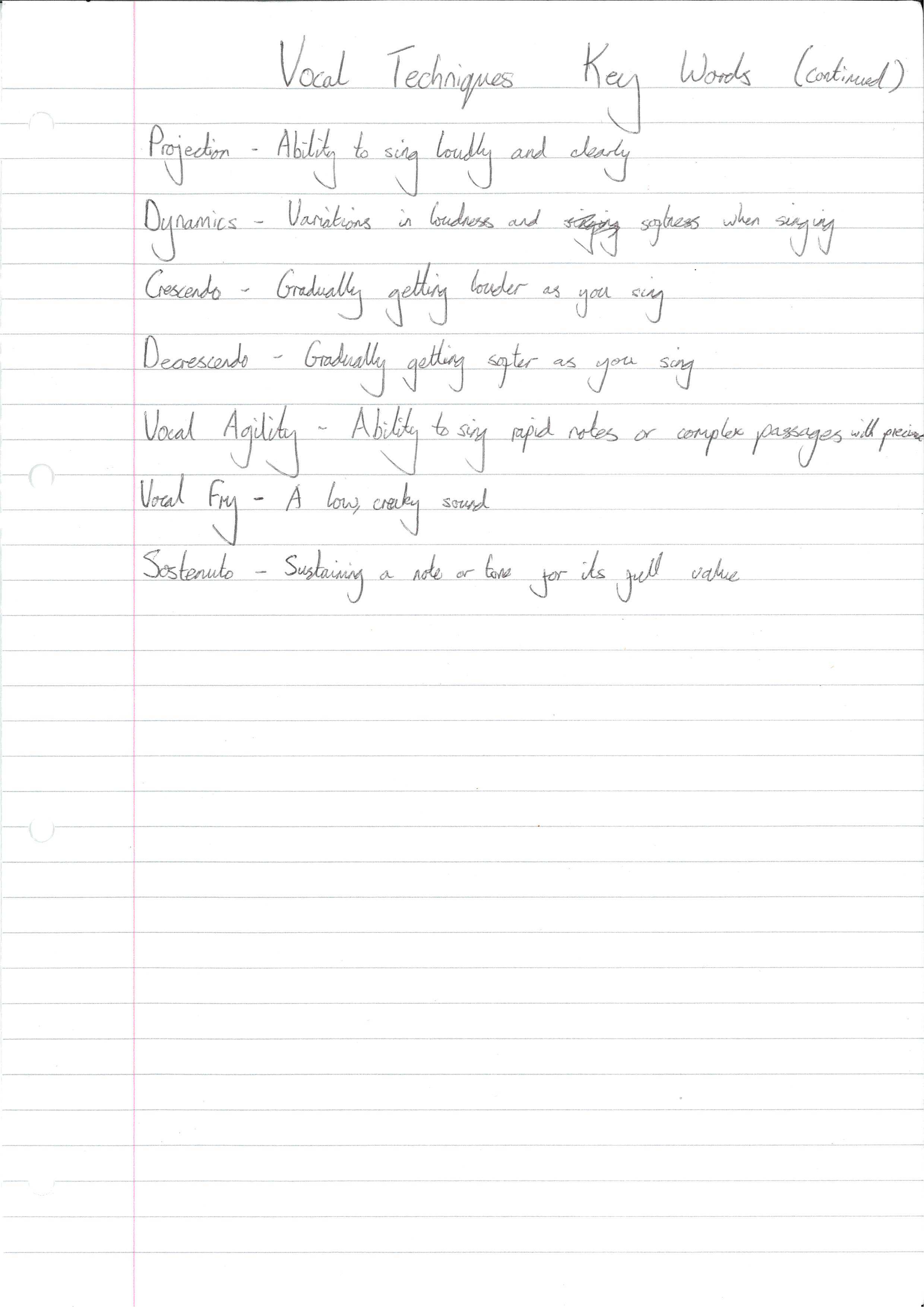
Vocal Expression & Interpretation
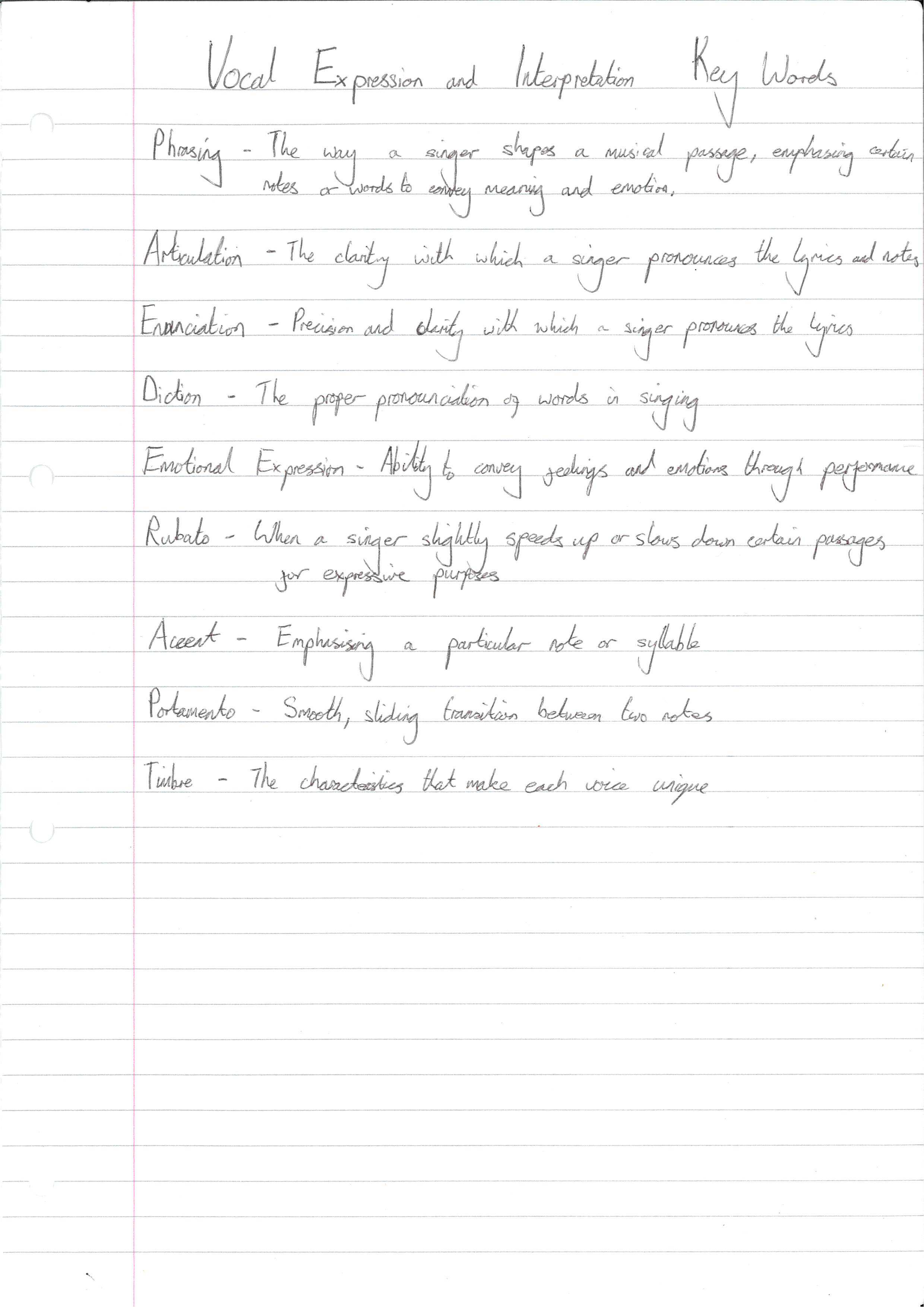
Vocal Effects
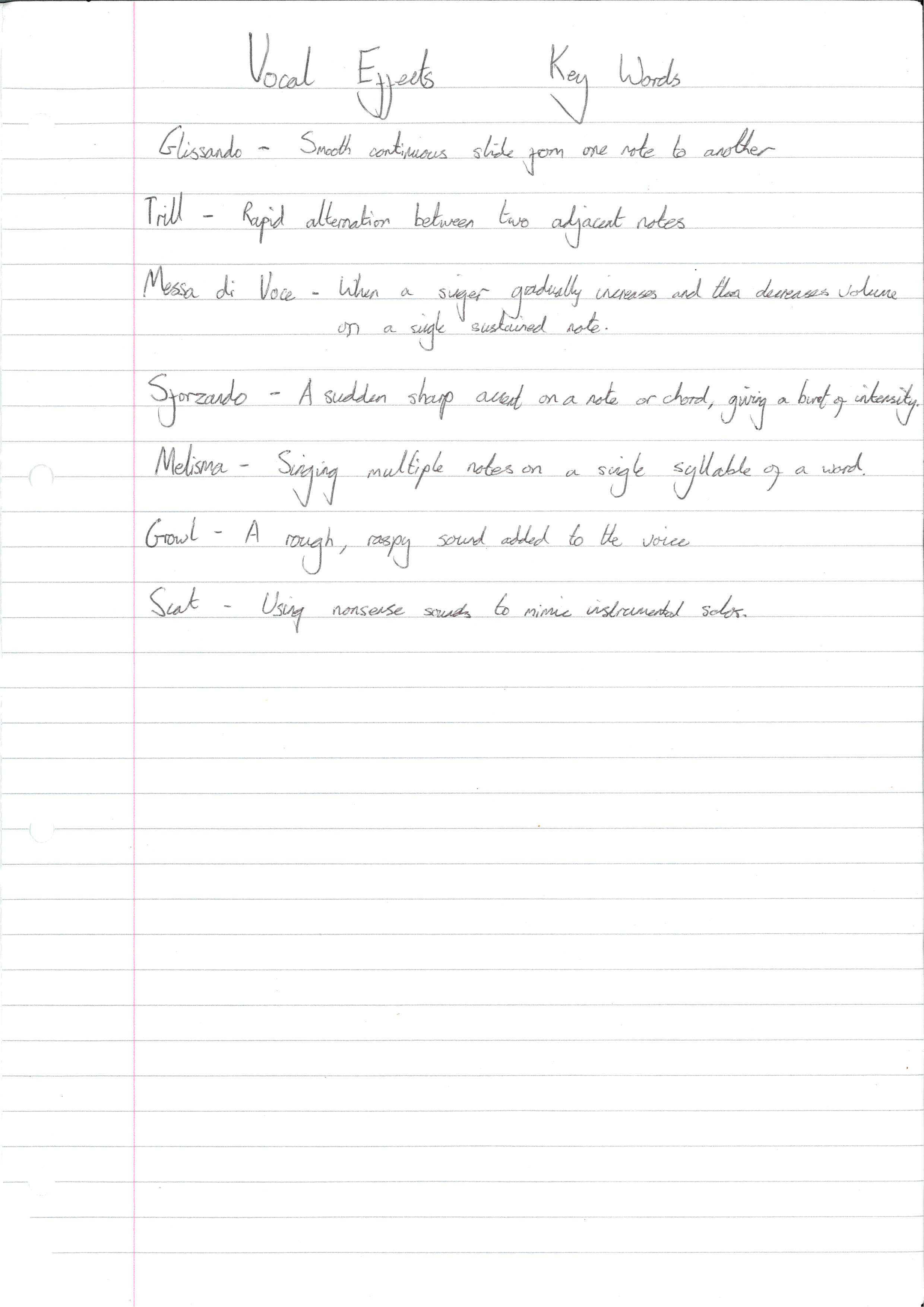
I've Never Danced Before... Today I Was Assessed On It...LessonBaseline
Assessment
Assessment
25/09/2024
Dancing doesn't come naturally to me, and assessments kill me with nerves - not a great mix!...
For my second ever dance lesson, it was announced that it would be our baseline assessment! As someone who couldn't dance to save their life, this assessment was a bit daunting for me. But before all of the assessment shenanigans, it was time to warmup our bodies. We did a very complicated exercise called "Box Jump". Basically, we had to stand in rows and jump to a beat. On the eighth beat, we had to turn around 180 degrees
play_circle
Watch: Our Jump Square Warmup:
I am the boy wearing a blue hoodie and blue tracksuit bottoms
Plank Challenge
Apparently it is tradition to kick off every dance lesson with a plank challenge. The idea is that we all hold a plank position whilst Mrs Mockford, our dance teacher, times us. Over the course of a few lessons, the goal is to gradually increase how long we can hold the plank. This excercise is great for working on improving core strength which is crucial for dancers, as it supports balance, stability, and control — all vital elements in performing complex choreography. In musical theatre, where performers are often required to sing and dance simultaneously, stamina is equally important. Holding a plank improves endurance by training the muscles to engage for longer periods without tiring, which mirrors the physical demands of a live performance. By strengthening our core muscles through this exercise, we will become better equipped to manage the intensity of performing multiple back-to-back scenes or dance routines, often while projecting energy and staying vocally strong. In today's plank challenge, I managed 1 minute and 26 seconds, I could have carried on until my body physically couldn't hold me anymore, but I knew I had a HIIT workout and an assessment coming up, so I decided to gracefully give up rather than destroy myself before the rest of the session.
HIIT Workout
Another dance class tradition is the sessionly HIIT workout — which stands for High Intensity Interval Training. In a HIIT session, you perform exercises vigorously for a set period of time, followed by a short rest. The process repeats and the exercises vary, targeting different muscle groups to ensure a full-body workout. After our last dance lesson, we were assigned a homework task to design our own HIIT workout that could be used in a future class. Today, the HIIT routine I created was selected.
My workout was a total of 14 minutes, with each exercise performed for 45 seconds, followed by a 15-second rest. Click here to view my full HIIT workout plan. Since it was my workout, I had the honor of leading the session. Before we started, I decided to briefly demonstrate each exercise to my classmates to ensure everyone knew what was about to go down.
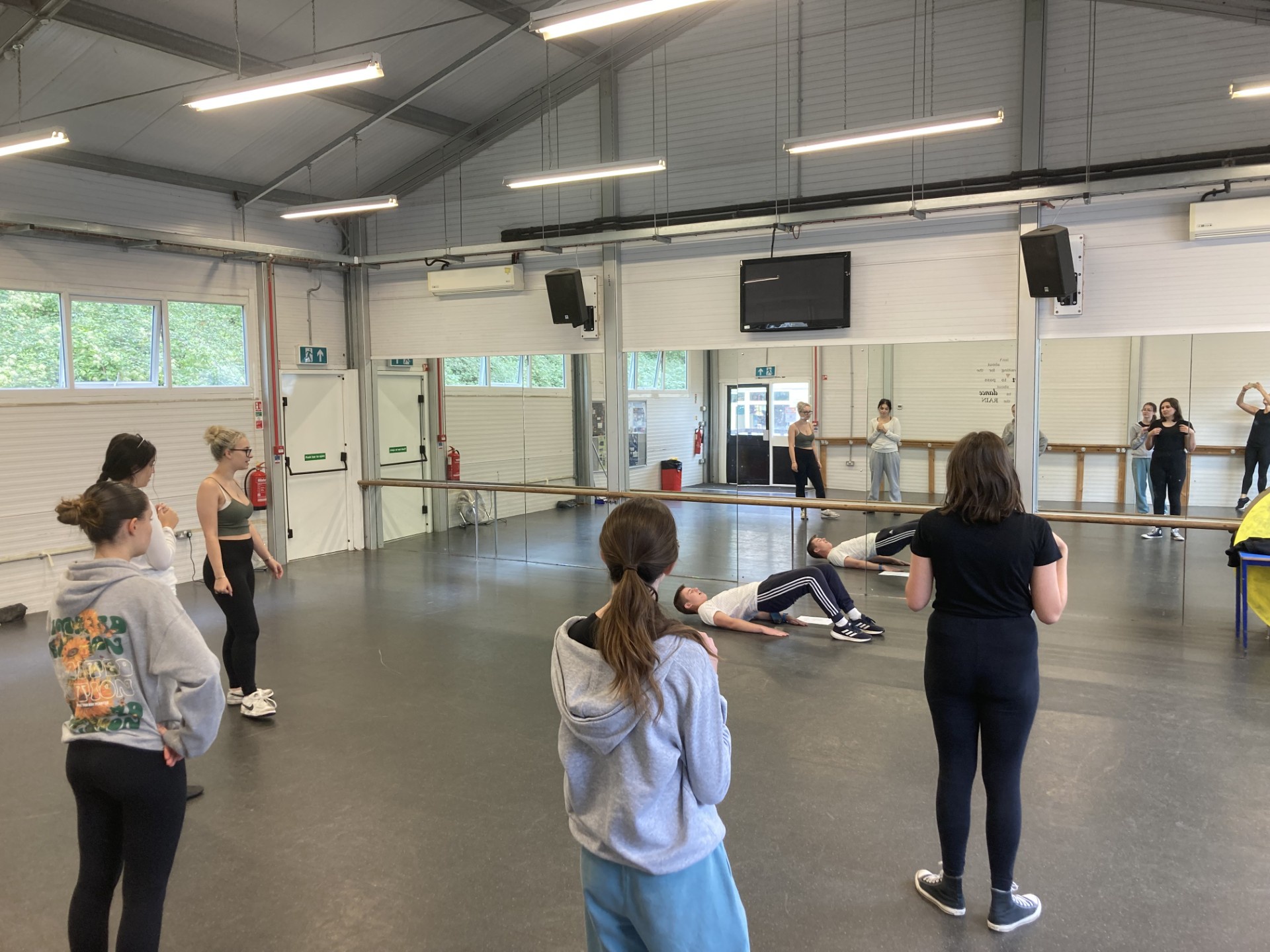
Once that was done, I ordered Mrs Mockford to fire up the music, before I shouted, "First exercise: running on the spot! Let's go... 5... 4... 3... 2... 1... Get those hearts pumping people!" I absolutely loved stepping into the role of fitness instructor.
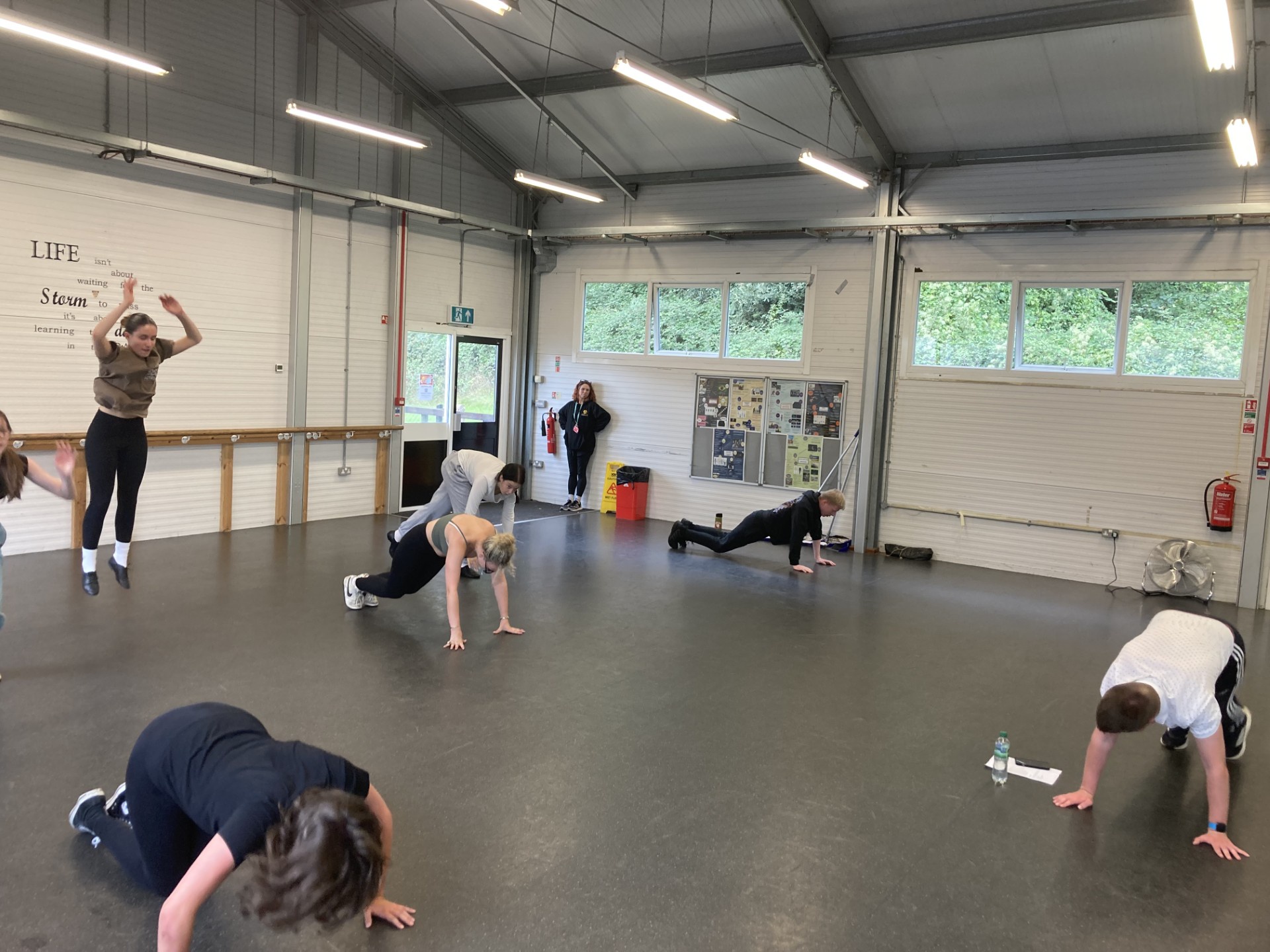
Beyond the thrill of leading the class, HIIT workouts are especially beneficial in a musical theatre context. In performance, the demands on your body are intense — fast-paced, high-energy dance numbers followed by rapid transitions into scenes or songs require exceptional cardiovascular fitness and muscular endurance. HIIT training mirrors this by combining short bursts of intense activity with brief recovery periods, conditioning the body to handle the unpredictable nature of live performances where there's little time to rest.
HIIT also enhances overall body coordination and agility. Each exercise targets different muscle groups, allowing performers to develop strength and flexibility in key areas like the legs, core, and arms, which are critical for executing demanding choreography. It also sharpens your ability to control breath and movement, a necessity for performing complex routines while singing.
Leading the HIIT session also gave me insight into the importance of leadership and communication, both of which are crucial in theatre. As a performer, there are moments when you need to take charge — whether in ensemble work, blocking a scene or improvisation on stage. Learning to motivate and guide a group, just as I did in the workout, perfeclty fits with the collaborative nature of musical theatre.
Learning to Dance
For our assessment, we had to learn a series of highly technical moves. We started by doing something called a plié, which is a fancy word for a move that involves bending and straightening the knees in succession. This version of a plié was actually quite easy - even for me! So Mrs Mockford decided to spice things up a bit by adding some sidesteps into our plié. Now, we would do a regular plié on the spot for four counts, then we would step out to the side and do a plié there for 4 counts, before stepping back together and doing a plié on the spot for four counts, and then stepping out to the other side to do a plié there for four counts. With pliés nailed, it was time to move on to something more advanced - isolations. In isolations, dancers move one part of their body, and keep the rest of the body completely still. We did some different variations in our isolations - we did some hip movements, chest movements, and shoulder movements. Whilst I'd say I managed to do the hip and shoulder movements fairly well, I was not able to do the chest movements at all. Taking what we had just learned, we then had to put the pliés and isolations into a little routine which we would be assessed on.
play_circle
Watch: My Plié & Isolations Assessment:
Reflections
It went okay.
It felt good to get one part of the assessment done and out of the way. For the next part of our assessment, we began by learning a jazz square - a dance move with four steps that form a square pattern: 1st) step the right foot forward (2nd) crossover in front of the right foot with the left foot; (3rd) step to the back with the right; (4th) step to the back with the left. After a bit of practise on this, I was able to this. Our next challenge was to do a jazz square starting on the opposite foot - this was quite challenging at first, but after a while, I was able to do it. After learning how to do a jazz square on the spot, we were taught how to do a jazz walk.
For the next stage, we began by learning a jazz square, a dance move used frequently in musical theatre. It consists of four steps that form a square pattern: (1) step forward with the right foot, (2) cross the left foot over the right, (3) step back with the right foot, and (4) step back with the left foot. After practicing for a bit, I felt confident in executing a jazz square.
The real challenge came when we had to reverse the move and start the jazz square on the opposite foot. It was tricky at first to reprogram the sequence in my mind and body, but after some focused practice, I managed to get the hang of it.
Once we had mastered the jazz square in both directions, we moved on to learning the jazz walk. Unlike the jazz square, which is stationary, the jazz walk is dynamic and fluid. The walk involves stepping sideways with slightly bent knees and a slightly lifted torso. We also crossed legs every other step.
Now that we had learned both the jazz walk and the jazz square, it was time to combine the two into a sequence called the corner walk — a term I had become familiar with after discovering it in our previous lesson. The combination involved jazz walking for four steps, then seamlessly transitioning into a double jazz square.
play_circle
Watch: My Jazz Walk & Square Assessment:
I am the boy wearing a white top and blue tracksuit bottoms
Reflections
It went okay.
Moving on now to the third and final part of my assessment, I learnt how to do a side gallop and a pivot.
play_circle
Watch: My Galloping and Pivot Assessment:
I am the boy wearing a white top and blue tracksuit bottoms
Reflections
My Self-Assessed
Targets:
1. Improve my posture when dancing
2. Improve my coordination when dancing
How I Will Achieve This:
Posture - I will focus on the position of my shoulders and chest when I dance
Coordination - I am going to start doing skipping sessions, for 10 minutes every day.
Setting My SMART Targets
23/09/2024
I set myself some SMART targets to help me improve myself as a performer...



I Fiddled With Musical Keys
22/09/2024
I am really not a fan of the current key that my "Legally Blonde" song is currently in, so I've set out to find a better one...
*There are seven key changes in this song, I am noting down the starting key
The Original Key - G Major*
The Original Key - G Major* but an octave lower
The Original Key - G Major* with octave jumps
(suggestion of my singing teacher)
C Major* (+5 Semitones)
A# Major* (+3 Semitones)
C# Major* (-6 Semitones)
Conclusion
Singing in the original key strains my voice excessively due to its high pitch, which not only causes discomfort but also leads to noticeable pitch inconsistencies. It just sounds rather stupid. Dropping an octave offers some relief, but it sacrifices clarity, as certain parts become inaudible and it fails to capture the intended tone and energy of the song. It too sounds rather stupid. Singing in the original key with octave jumps sounds so unnatural for a character and just sounds again rather stupid. It's not feasible for me to practise in this key when every time I sing it, it hurts my voice for hours afterwards.
Therefore, I think that the best idea is to meet in the middle of these two extremes, by singing in C major. This key perfectly aligns with my natural range, allowing me to sing with ease, precision, and fullness. In C major, my voice can deliver every note with clear diction, rich tone, and a confident pitch, enhancing the song's impact and connecting with the audience on a deeper level.
Initial Audit of My Skills
21/09/2024
From acting to singing and to dancing, I put my skills to the test with a highly sophisticated tick sheet...
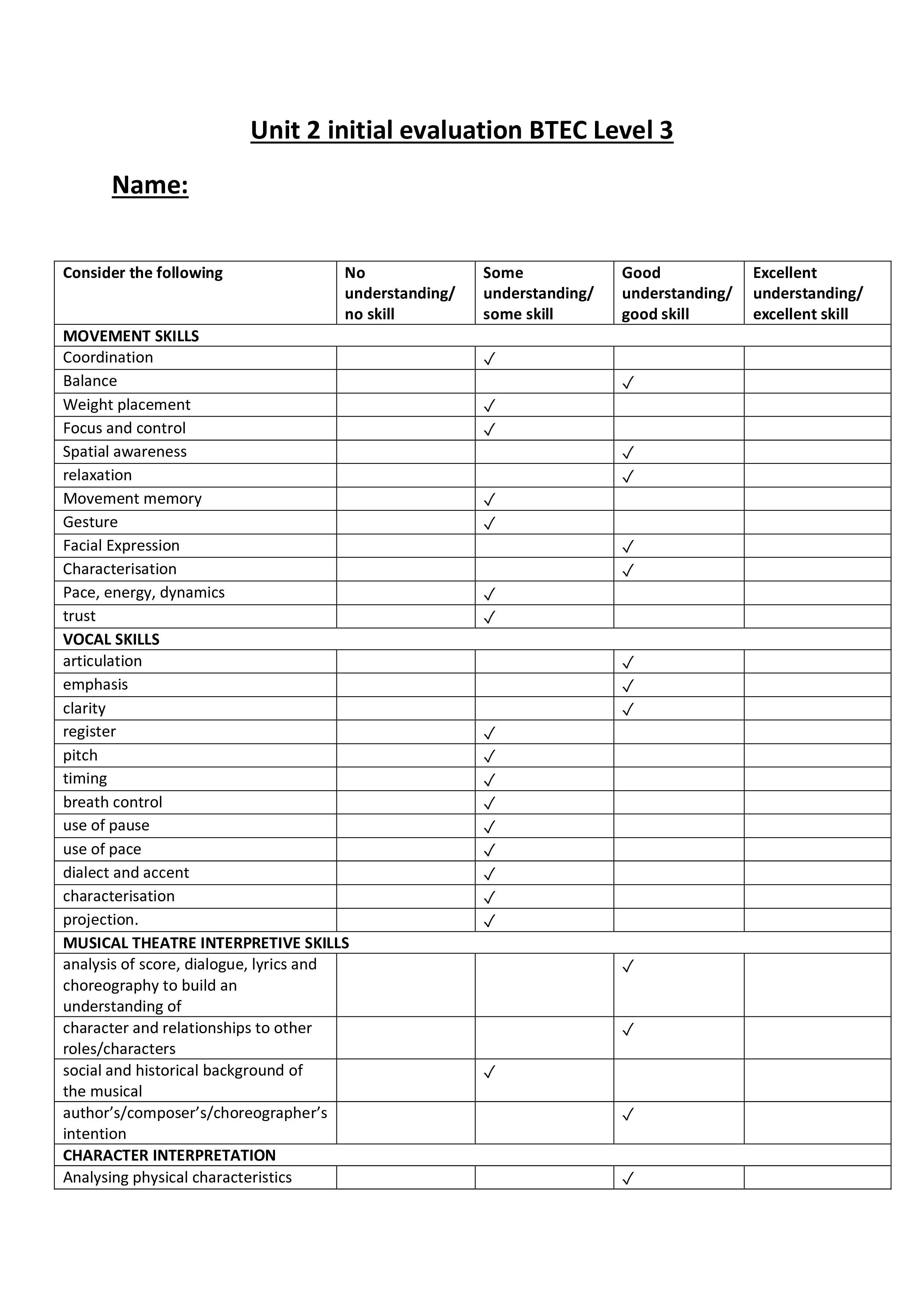
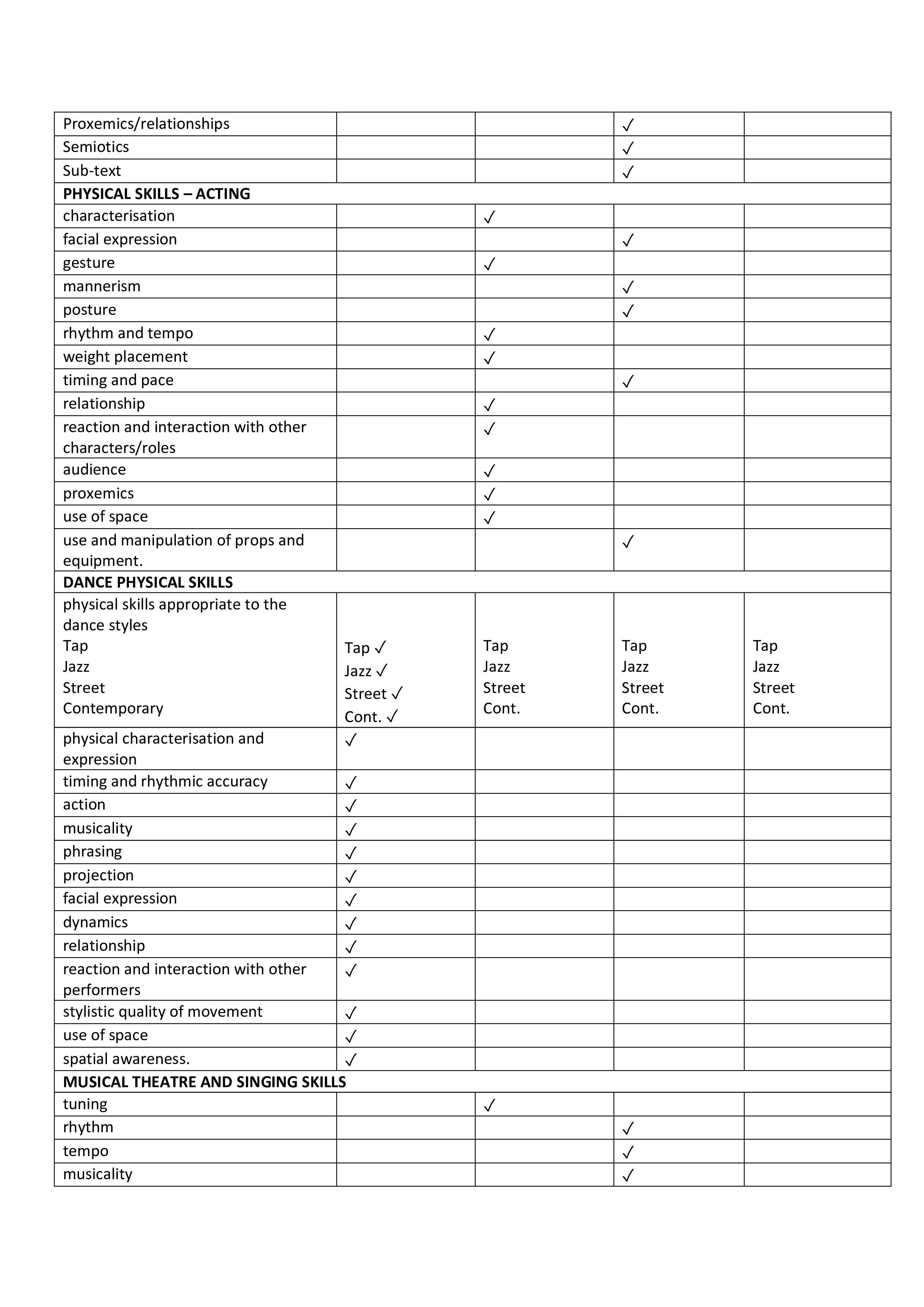
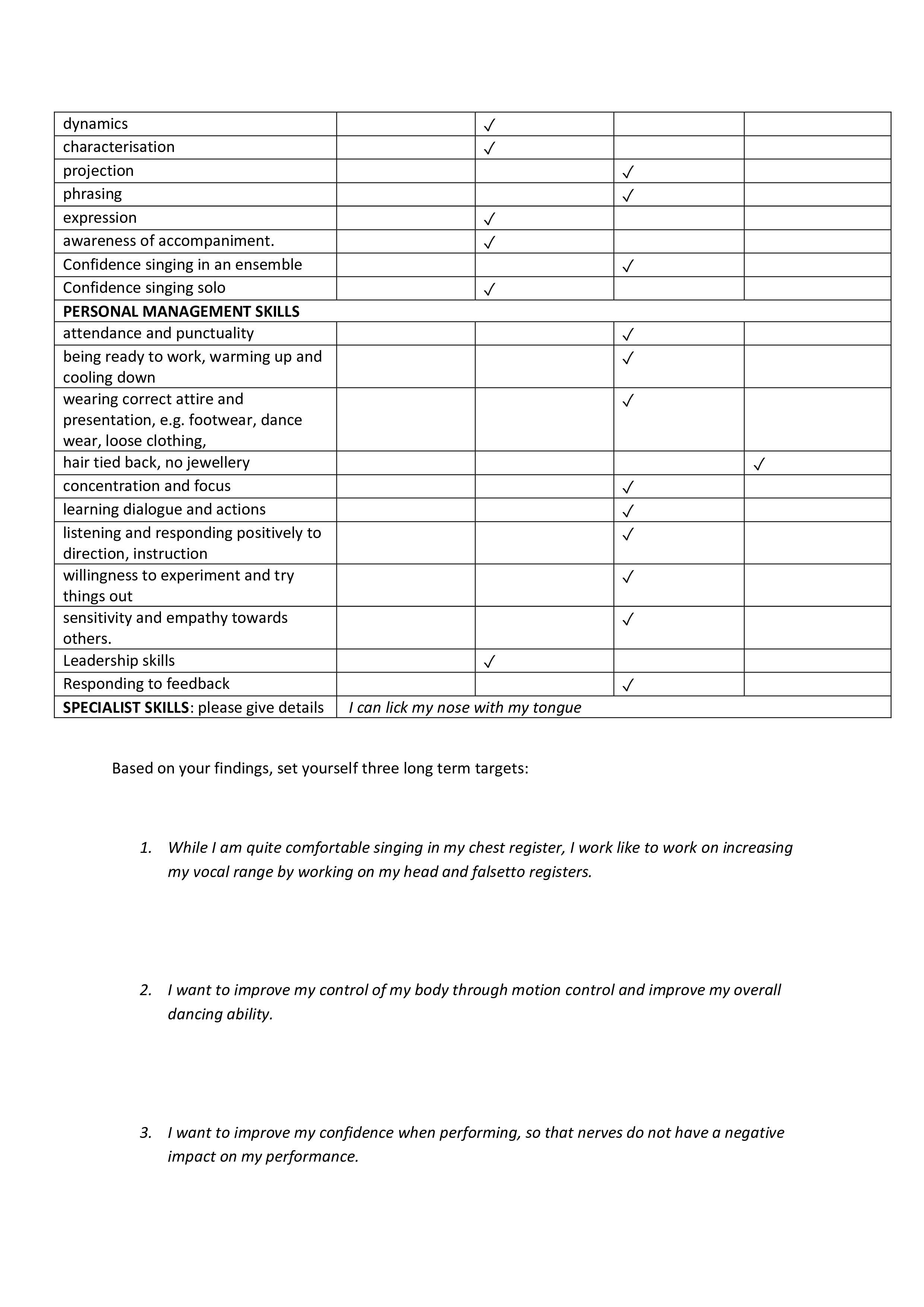
The Biggest Test of My Entire LifeLessonBaseline
Assessment
Assessment
19/09/2024
It was terrifying... today we did a baseline assessment in acting...
I remember it vividly, walking through those doors after lunch, feeling perfectly content, then sitting down before we took the register. Everything seemed normal. Except not for long - not until I heard those dreaded words leave my teacher's lips: "Baseline Assessment"! Dn dn dn!!!!!
It did come as quite a surprise to me that today was our baseline assessment, and instantly the nerves kicked in. Before our actual assessment though, we discussed character motivation. I was introduced to the accronym DAB (Desire, Action, Barrier). Desire refers to what the character wants or is striving for. It is the character's objective or goal. Action is what the character does to achieve their desire. It refers to the tactics or steps the character takes in pursuit of their goal. And barriers are obstacles or challenges that prevent the character from easily achieving their desire. These can be external (other characters, situations) or internal (self-doubt, conflicting emotions). If I am able to understand these three factors about my "Legally Blonde" character, Warner Huntington III, I will be able to connect more with my character, helping to deliver more authentic an delivering performances. For Warner, I think that his desire isn't so much to become a top lawyer and then a senator (after all he ends up quitting his studies to become a model), but to achieve success predominantly in order to please his family. The action that Warner takes to please his family by becoming a successul lawyer starts by dumping Elle and entering a relationship with Vivienne Kensington, a move influenced heavily by his family as he and his family didn't belive that Elle was "serious" enough for Warner. Warner also gets into Harvard Law School, an obvious major step for anyone wanting to become a lawyer. His barrier comes from his own narrow, superficial view of success and relationships, as well as his underestimation of others, particularly Elle. Warner's belief that image and status matter more than substance blinds him to Elle's intelligence and capability. And in the end, it's his focus on external success and societal approval causes him to lose both his ambitions and Elle.
Now that we had realised our character's motivations, we did a hotseat exercise in pairs. In our pairs, one person acted as an interviewer, and the other was answering the questions as if they were their own character. The person being interviewed has to completely improvise their answers. It's designed to help actors become more familiar with their role. We were told to asked quite complex and open questions that encourage the actor to explore their character’s life in depth, extending beyond the scope of the play. Such as questions that cause them to reflect on their character’s home life, childhood, family dynamics, dreams, fears, hobbies, and their feelings toward other characters. When I was interviewed as Warner, I was asked a series of personal questions which I tried to answer in as much depth as I could, but I am absolutely terrible at thinking under pressure. I work much better when I'm relaxed and on my own, than when I am put on the spot - this is something that i'd like to work on improving throughout the course of the BTEC.
After we had interviewed our partener, and been interviewd ourselves, it was time for the first baseline assessment. At this point, I was very nervous. I know it's just a miniscule baseline assessment, but still, I was very nervous. For the actual assessment, we sat on a chair in the spotlight at the back of the classroom whilst everyone else watching hurled questions at us. The interview would last about two minutes. I, being the nervous wreck that I am, decided to delay the assessment for as long as possible by going last. But as they say, "Nice guys finish last", right? When it was my turn, I took my seat, and sat stretched out, with my right foot resting up on my left knee-cap. Then the questions came shooting at me fast.
play_circle
Watch: My Hotseat Assessment:
Reflections
It went okay.
For the final part of our baseline assessment, we were put in groups and had 15 minutes to prepare a scene from "Legally Blonde". The scene that we were given was the one where the law students on proffeser Callahan's internship (Warner, Vivienne, Emmette, and Elle) are meeting with their client Brooke Whyndham. 15 minutes may seem like a decent chunk of time, but the scene we were doing is fairly lengthy, so it went by in a flash, and before we knew it, we were being assessed once more.
play_circle
Watch: Our Group Assessment:
Reflections
My Self-Assessed
Targets:
1. Work on my "General American" accent
2. Become better at improvising
How I Will Achieve This:
Accent - I will speak to myself and family in a "General American" accent for 1 hour a day
Improvisation - I will do a Random Word Monologue often
What is a random word monologue?
I will write down a list of completely random words, select one at random, and begin a monologue based around that word. Every 30-60 seconds, I'll pull another word from my list and incorporate it seamlessly into the monologue. The key will be to integrate it naturally into the flow of my story. In order to get the most out of the exercise, I must stay committed to the character that I’ve created or the situation that I am describing, no matter how unusual or unrelated the words may seem. Also, I should keep the energy up and react to the twists each new word introduces.
Example of how it works:
Word 1: "Pizza" – I'm talking about making pizza at home.
Word 2: "Detective" – I pivot to a story where you solve the mystery of a missing pizza slice as an amateur detective.
Word 3: "Lamp" – The lamp in my detective office starts flickering, adding a spooky element.
So, does it work?
In theory, yes. I believe that it could help to develop skills such as: Creativity under pressure, character development, storytelling, and solo practise.
Creativity under pressure: It forces you to adapt to new information and connect ideas that might initially seem unrelated.
Character development: It helps you quickly develop characters and scenarios from scratch.
Storytelling: It forces you to make up an engaging story on the spot.
Solo practice: It’s an exercise that you can do alone anytime, without needing a scene partner.
I Learnt About SingingLesson
18/09/2024
For my first singing lesson of the Performing Arts BTEC, we looked at the fundamentals of vocal technique...
Technique is important in many different things, especially in singing. A good
technique can enhance one’s voice immensely. Don’t believe me? Take a listen to
the difference between Ramin Karimloo (using great technique) and Nick Jonas (who
is by no means a bad singer, just using poor technique) in the Les Misérables 25th
Anniversary concert:
https://www.tiktok.com/@mcvocalstudio/video/7277270233646140705 Where
Ramin’s technique of supporting his voice with his diaphragmatic support, larynx
positioning, sound placement, resonance, vowel modifications to name a few, he
overshadows Jonas extortionately. In musical theatre a good singing technique is of
paramount importance. Posture is an important technique in singing. Correct singing
posture starts by keeping your head level, your chest high and shoulders back, and
ensuring that your abdomen is flat. From there, relax your hands and keep them on
your side. Be sure not to lock your knees, and keep your feet shoulder width apart.
The posture described allows for easier expanding and contracting of the lungs,
diaphragm, and throat and will help to maximise one’s airflow and pressure which is
key while singing. Good posture can also relieve tension. While this posture is great
in an ideal world, Musical Theatre isn’t always an ideal world. There are times when performers are required to sing in situations where this posture is not possible, like in
the song “Serious” in Legally Blonde which requires performers to sing sat down,
leaning over a table or in Valjean’s Soliloquy of Les Misérables where Valjean is on
his knees, often in a position of prayer, and of course, there’s all of the times that
performers are required to sing whilst dancing! Diaphragmatic Support is another
important factor of singing technique. As a biology student, we look at the respiratory
system in great depth, which has given me a great appreciation and understanding
of the role of the Diaphragm. The Diaphragm is a major muscle, located just beneath
the lungs. When it contracts, it increases the volume in the lungs, therefore
decreasing the pressure in them, creating a vacuum (as air pressure in the lungs is
less than that outside of them) which is what causes air to move into the lungs.
When the diaphragm relaxes, the opposite occurs: the volume of the lungs
decreases, increasing the pressure in lungs, causing air to leave the lungs. A great
representation of how the diaphragm causes the lungs to inhale and exhale air is the
Bell Jar model, which (I’m not trying to brag) I have actually used in real life!!! If
you’re intrigued by this cosmopolitan piece of technology:
https://www.youtube.com/watch?v=NYT0qlKwHuI. Engaging the diaphragm when
singing as opposed to singing solely from the shallow breaths of the throat can
create a louder, richer, more-weighted and resonant sound. It also allows singers to
hold sustained notes for much longer and much easier. In order to actually engage
the diaphragm when singing, one should use correct posture, exhale fully and inhale
deeply. The Positioning of The Larynx is crucial when singing. The Larynx (or
in my English: The Voice Box) is the area of the throat containing the vocal folds.
Muscles in the larynx bring the vocal folds together which interrupts air escaping
the lungs. The number of times they interrupt the airflow per second creates the
pitch. The Larynx is able to move freely up and down the neck. The
position of the Larynx affects the shape of the vocal tract changes voice quality and
affects the efficiency of the vocal folds. The cleaner and more efficiently the folds
vibrate, the clearer and healthier the sound. The specific position of the Larynx
leads to a different type of sound produced. A low larynx produces a deeper, more
hollow sounding sound along with a rounder tone with a more emotive, atmospheric
touch. A neutral Larynx position is the natural position that the larynx adopts
when completely relaxed. Singing with a neutral Larynx creates a free and easy
way of singing. A high larynx can create a lighter, higher, airier sound but singing
with a high larynx is generally discouraged as the larynx will often raise when
attempting to reach higher and higher notes which become more and more fretful so
the larynx will raise to “reach” the note, and usually as a singer you’ll feel the
muscles around the larynx squeeze to try and help. This can result in a squeezed,
strained and shouty sound that can often take a singer off-pitch and be extremely
uncomfortable to sing with. It can result in vocal fatigue and in more severe cases
vocal injury. So, how does one actually control the position of their Larynx? The
larynx will more often than not position itself appropriately, and will naturally lower
when a singer breathes in. In order to actually control the movement of the Larynx to
optimise one’s vocal technique, one should engage in exercises that naturally move
the Larynx, such as pitch gliding, whilst being hyper-aware of the positioning of the
Larynx. Belting is a technique used by singers to produce powerful, forceful, loud,
and resonant sounds in the chest register. Belting is very common in Musical
Theatre, especially in epic and emotionally intense songs. In order to belt, one
should ensure good posture, use diaphragmatic beathing, relax, open the mouth
wide and sing as loudly as possible. Consistent practice will help to develop a
strong belting technique. Consider recording yourself and listening back to identify
areas for improvement going forward. Always remember that belting should feel easy
and effortless – it shouldn’t strain your voice or feel painful. Resonance uses the
vocal tract’s resonating spaces to amplify and enrich a sound. There are four
different types of resonance, each of which produced in a different part of the body
and each of which producing a unique sound appropriate for different repertoire in
Musical Theatre. Nasal Resonance is created by the nasal cavity and sinuses, it
creates bright, ringy and twangy sounds.
Vocal technique is an essential foundation for successful singing,
especially in the demanding world of musical theatre. Proper technique not only
enhances the quality and richness of one’s voice but also ensures vocal health and
longevity. A strong vocal technique is the cornerstone of a singer's ability to perform
with power, precision, and endurance, ultimately elevating their artistry and
performance.
I Created A HIIT Workout
14/09/2024
For my dance homework, I was tasked to design my own HIIT workout...
A HIIT workout stands for High Intensity Interval Training. It is a type of workout where
you do an exercise vigourously for a set amount of time, before having a short rest. The
process then repeats, but with different exercises to work out different parts of the
body.
Things to take into consideration when designing my HIIT:
- Length of each exercise
- Length of rest
- Variety of exercises
- Muscles being worked
- Progression of exercise difficulty/ intensity
- Background music
My workout plan
Key Info:
Total Time: 14 Minutes
Workout Time: 45 seconds
Rest Time: 15 seconds
Work:Rest ratio: 3:1
Exercises:
1. Running on the spot (Legs, Heart)
2. Glute bridges (Glutes, Hamstrings, Lower back)
3. Static plank (Core, Shoulders, Lower Back)
4. Mountain Climbers (Core, Shoulders, Legs)
5. Jumping Jacks (Legs, Shoulders)
6. Crab Walk (Shoulders, Triceps, Core)
7. Squats (Quads, Glutes, Inner Thighs)
8. Skater Hops (Glutes, Hamstrings, Calves)
9. Push-up Walks (Shoulders, Chest, Shoulders, Triceps)
10. Butt Kicks (Hamstrings, Glutes, Calves)
11. Single leg raises (Legs, Core)
12. Side plank (Shoulders, Back, Core)
13. Dead Bug (Whole Body)
14. Burpees (Whole Body)
Workout Music
Nothing in life would ever be complete without a bit of Taylor Swift. I needed to select some of Swift's songs that are upbeat and motivational, so here's what I came up with:
"Out of The Woods" (4:17)
"The Man" (3:12)
"All You Had To Do Was Stay" (3:18)
"I Wish You Would" (3:27)
Access the playlist here ↗
Blocking My Solo Song
Rehearsal
13/09/2024
At today's rehearsal we blocked my solo song, "Serious"...
Warmup
At today's rehearsal, we started with a quick vocal and physical warmup. For our vocal
warmup, we did some call and response, sirens, and a few other things. We also did some
squats and shoulder rolls as a sort of physical warmup, before breaking up into our seperate
rehearsals. I went to learn the blocking for my solo song, "Serious".
About Serious
"Serious" is a comdedic song which starts off with Elle and Warner on a date at a
restaurant. The scene begins light-heartedly, with playful flirting between the two, as Elle
believes Warner is about to propose. However, when Warner starts singing about his future
ambitions, it is made clear that he is focused on becoming a successful lawyer and then
politician, the lovey-dovey tone switches somewhat. In his self-centred song, Warner
emphasises how serious his life is becoming and that he needs to focus on his career,
ultimately leading to him telling Elle that they need to break up. He claims he needs
"someone serious" by his side, implying Elle, with her bubbly, overly-energetic personality,
isn't the right match for him. The song mixes humour with heartbreak, as Elle's hopes of a
romantic future with Warner are shattered, setting the stage for her later transformation
throughout the musical. The upbeat tempo and playful melody add irony to the painful moment,
making the song both funny and bittersweet.
Our Blocking of Serious
Warner enters the scene from upstage, walking in cooly before stopping and striking a powerful pose, immediately signalling his self-assurance and sense of superiority. Warner is always conscious of how he presents himself, using his body language to project control and dominance.
He then makes his way to the resturant table, and pulls the chair out for Elle before tucking her back in again, showing his gentlemanly charm. He then sits himself down opposite Elle.
The lines then start with each other telling one-another that they are "perfect" repeatedly and playfully. As they are saying this, they lean in toward each other and gaze lovingly into each others eyes. Warner tells Elle that she has made him really happy and that "Every guy dreams of finding a girl who looks like [her]", a line which reduces Elle to her appearance, revealing that Warner’s idea of happiness is skin-deep showing how he values Elle more as an asset than as a partner, a reflection of his shallow view of the world.
Warner then breaks out into song. During the first verse, they both remain sat at the table, staring deep into each others eyes, as Warner expresses his appreciation for Elle.
Toward the end of the first verse, when Warner sings the line, "but now we're wide awake" he accidently knocks a napkin on the floor - Elle doesn't see this as she is looking the other way at this point. Whilst Elle is still looking away, Warner gets down on one knee to pick up the napkin, at which point Elle turns back around and notices Warner down on one knee. Warner then proceeds to sing "So baby give me your hand", to which Elle thinks he is about to propose, but instead Warner uses her hand to pull himself back up to the table! This moment of misunderstanding is crucial as it hints at Warner’s inability to see beyond the surface of their relationship - he has no intention of committing to Elle in the way she desires. His literal use of Elle to regain his place mirrors how he emotionally uses her - she’s there to support and elevate him, but never as an equal partner.
Elle then starts to sing, only to be interupted by Warner who cuts her off with the line, "Ugh honey, I'm not finished" to which Elle immediatly appologises to him. This reveals a deeper dynamic of control and dominance within their relationship. Warner’s casual dismissal of Elle’s attempt to express herself showcases his lack of respect for her voice, both literally and figuratively. He asserts his authority in a way that feels almost routine for him, and Elle’s immediate apology in response highlights her own internalised submission to Warner’s control.
After this, Warner gets up and leaves Elle at the table - a move that symbolises the emotional distance between them. Once up, he starts singing about his very specific plans for the future, delivered in a way that makes him seem sure that all of his plans are destined to be fulfilled. Warner's self-assurance in this further reveals his belief that success, power, and status are not just goals but inevitable outcomes for someone like him. Elle then joins in, singing along with the line, "Three kids at least just like the Kennedys", suggesting that she is all too familiar with Warner's serious plans. She has probably heard his plans countless times before and has accepted them as part of her own future, which speaks to her initial willingness to conform to Warner's expectations. It's also worth noting that all of these plans seem to be tailored to Warner, Elle doesn't seem to have provided any of her own input into these plans, further showing Warner's self-centredness.
Later, Warner sings the line, "But just where do you fit in?" which is delivered in a way that implies that Elle is not the perfect match for him. The delivery is critical in revealing his true feelings toward Elle and how he views her role in his life. The way I chose to sing this line was with a tone of uncertainty or even mild condescension, to suggest that despite their relationship, Warner ultimately sees Elle as someone who doesn't quite align with his future plans. This moment is a turning point, as Warner, who has thus far seemed assured of his path, now openly questions whether Elle fits into the idealised life he envisions for himself.
Warner then meets Elle at the downstage centre, when he sings the line, "So baby give me your hand". He and Elle hold hands in an intimate, quite tender moment. The physical act of holding hands, coupled with Warner’s seemingly affectionate tone, gives Elle the impression of a meaningful romantic connection, shown in her response where she closes her eyes and leans in for a kiss only for Warner to once again pull away and slide out of the intimate moment and start singing about his seriousness again. By literally sliding away from Elle at the moment she is most vulnerable, Warner once again prioritises his own ambitions and rigid plans over their relationship.
Now with physical distancing between the two of them, showing again the emotional separation that has been gradually building throughout the scene, Warner once again sings about his seriousness. The pivotal line, "Baby, that's why you and I... should break up!" I delivered with a sense of finality that makes clear Warner’s perspective. I added hesitation before the words "should break up" to heighten the tension, as Warner frames the breakup as a rational, almost inevitable decision. His tone likely suggests that this conclusion is simply a logical extension of his ambitions and seriousness. To Warner, their relationship is an obstacle, something that doesn’t align with his future goals. His use of the word "baby" softens the blow slightly, as if he's trying to make his decision sound reasonable and considerate.
When Elle reveals that she thought that Warner was going to propose, I decided to act surprised to show Warners niavety and arrogance. His surprise is not just about the misunderstanding but speaks to his complete disregard for Elle’s expectations and emotions. This reaction shows how little Warner has truly considered Elle’s feelings, making his surprise feel almost condescending, as if he couldn’t fathom that she might expect something more meaningful from their relationship. This reveals Warner’s arrogance - he is so absorbed in his own world of ambitions and plans that he fails to realise the impact of his actions on Elle.
Warner’s half-hearted attempt to comfort Elle by meeting her at downstage center and placing his arm over her emphasises his performative nature. The gesture feels obligatory rather than sincere, as though Warner is more concerned with maintaining appearances than offering real emotional support. His arm over her, while a physical act of comfort, is shallow as there is no genuine emotional investment in it. Warner's physical positioning suggests a power imbalance, where he takes a paternalistic role, trying to pacify Elle without truly addressing her distress.
Warner shifts the conversation to his parents’ disapproval of their relationship, along with the mention of his brother and sister-in-law both studying at a prestigious university, it adds another layer to his self-centered worldview. By bringing up his family’s influence, Warner shifts the blame for the breakup away from himself, making it seem as though he’s simply following his family’s expectations. This highlights his focus on status and elitism. The reference to his brother and sister-in-law studying at a top-tier university reinforces the idea that Warner is driven by external markers of success.
Elle gets defensive as Warner has effectivley just told her that she is not good enough for him. Elle then plonks herself back down at the table expressesing her frustration and hurt, marking a shift in her demeanor. Warner then follows sitting himself down opposite her. He briefly holds her hands, before once again sliding away from her, jumping out of his seat and singing about his seriousness again.
He sings that he need someone who is "Less of a Marylin" and "Somebody classy and not too tacky", for which I decided to gesture directly at Elle, to show Warner's lack of care for how his words impact Elle.
My Self-Assessed
Targets:
1. Consolidate my lines and lyrics for this scene
2. Memorise the blocking
How I Will Achieve This:
Lines & Lyrics - I will test myself on my lines and lyrics
Memorising Blocking - I will watch the video many times, and note down the blocking
in my script. I will then run it out in my head and act it out in my lounge.
Who Is Warner Huntington III?
12/09/2024
I will be playing Warner Huntington III in my school's musical production of Legally Blonde, so as I like to do with all of my characters, here is my character analysis of Warner...
Warner's Relationships
At the very beginning of the musical, Warner is dating Elle Woods, a sorority girl from
Malibu, California. His decision to break up with her early on demonstrates his
superficiality and ambition, as he does so under the pretext that Elle is not "serious"
enough for his future plans. Warner’s break-up is not because he doesn't care about Elle,
but because he feels that being with her does not align with his aspirations of becoming a
successful lawyer. He is more focused on impressing others - particularly his family - than on
fostering a meaningful connection with Elle. This sets the stage for much of his character's
arc, which is driven by his desire to fit into the mould of a high-achieving, successful
individual.
Warner references his brother, who is studying at Yale Law - a top-tier academic institution, and his sister-in-law, who is also studying at Yale Law and is a member of the very successful Vanderbilt family. This gives insight into the high standards his family holds him to and the intense pressure he feels to live up to these expectations. Warner is likely driven more by external validation than internal motivation, shaping his behaviour and decisions. His parents expect him to be successful, and Warner seems desperate to prove himself worthy of their praise, suggesting a need for approval that he chases through status and outward achievements, rather than personal growth or happiness.
As the musical progresses, Warner becomes engaged to Vivienne Kensington, a stern and
serious law student who seems to better fit his image of a "serious" partner, especially in
the context of his career-driven life. Vivienne, with her cold demeanor and sharp focus,
represents the type of person Warner believes he should be with to succeed in the
competitive world of law. Their engagement, however, lacks passion, showing how Warner’s
relationships are shaped more by practicality and ambition than by genuine connection. This
reflects his tendency to prioritise status and external approval over personal fulfillment.
Warner’s Behaviour
Warner is, at his core, self-obsessed and unaware of the harm he causes others. He sees
people, including Elle, primarily as stepping stones toward his own goals. His break-up with
Elle illustrates his shallowness - he views her as unworthy because he thinks she lacks the
seriousness required for his future successes. Warner’s perspective is limited by his narrow
definition of success — good looks, a prestigious education, and an impressive career. His
inability to see Elle’s potential beyond her appearance and lifestyle is one of his greatest
flaws.
Despite getting into Harvard Law, Warner shows little drive or passion for his studies. His
acceptance into Harvard seems to be more a result of his privileged background and ability
to "play the part" of a successful future lawyer, rather than any real skill or dedication.
When working on the Brooke Windham court case, Warner doesn't contribute anything meaningful
and lets others—like Vivienne and Elle—take the lead. This passivity speaks to his
overconfidence and reliance on his charm and connections to get by, rather than on hard work
or intellect. He believes that simply being Warner Huntington III will carry him through
life.
Warner's naivety is shown in some of his interactions with Professor Callahan. Rather than recognising Callahan’s manipulative behaviour, Warner is easily swayed by flattery and the prospect of success. He lets Callahan exploit his ambition during the celebratory scene and is too arrogant to see that he is being used.
Warner’s arrogance is shown once again through his disbelief when Elle is accepted into Harvard, when he exclaims: "You got into Harvard Law?!" His incredulity reflects his narrow, elitist mindset — he cannot fathom that someone like Elle, who doesn’t fit his conventional idea of "serious" or "successful," could achieve something he views as being reserved only for people like him.
Though arrogant, Warner is undeniably charismatic. His cocky attitude and confidence in his own abilities make him appealing on the surface. This charm, however, masks his deeper insecurities and need for validation. He uses his good looks and social skills to navigate through life, but his lack of substance eventually becomes clear, especially as characters like Elle and Vivienne outgrow him
How I Want to Play Warner
I want to emphasise Warner’s self-obsession and arrogance by showing how he constantly
centres himself in every situation, regardless of how his actions affect others. In scenes
with Elle, I plan to portray Warner as condescending but not outright cruel. His break-up
with Elle should feel more like a transaction than a heartfelt moment — he’s breaking up
with her not because he hates her, but because he sees her as an obstacle to his success.
There’s a sense of detachment, as though Elle is just another item on his list of things to
discard in pursuit of his ambitions.
When interacting with Vivienne, I want to show Warner as performative, trying too hard to
fit into the mould of the perfect "serious" law student. His engagement to her feels more
like a strategic move than a romantic decision, which I’ll convey through slightly stiff and
formal body language, contrasting with his more relaxed demeanor around Elle.
Warner's arrogance should be evident in his physicality — his posture will be tall and
confident, and his movements will be sharp and deliberate. In moments like his line, "You
got into Harvard Law?!", I’ll make sure to emphasise his incredulity and disbelief,
portraying him as someone who can’t conceive of anyone else being on his level.
At the same time, I want to subtly hint at Warner’s insecurities. Underneath his bravado is
a character who is deeply insecure about meeting the expectations of his family and society.
I’ll show this vulnerability in quieter moments, such as when he references his parents or
his brther. In these scenes, Warner’s bravado will slightly waver, revealing his internal
conflict between who he is and who he thinks he needs to be.
Ultimately, my portrayal of Warner will attempt to balance his cocky, charismatic exterior
with the underlying truth that he is lost, directionless, and reliant on the validation of
others in order to feel successful.
By adding depth to Warner’s motivations, relationships, and insecurities, my analysis can
help shape a more nuanced portrayal of the character. Warner may seem like a stereotypical
antagonist, but he is more complex, driven by his flawed understanding of success and fear
of failure, which ultimately leads to his downfall.
My First Ever Dance Lesson!
Lesson
11/09/2024
I've never danced before in my life... this is going to be interesting!...
Dance class started with us gathering around our dance teacher in a semicircle. We discussed
the role of the use of dance within musical theatre. We concluded that dance is important to
express a character's emotions and feelings. A dance between two characters can show
intemacy.
We were then asked to rank each of the performing arts "parts"
(Acting, Singing, Dance) into a personal order of ability / confidence. I had dance as the
solid last of my three. I've never really danced before apart from in last years school
musical for which I really struggled to learn and execute. Whilst other people were able to
be taught the dance once and then have it instantly nailed, I had to break it down into more
managable sections and go over each bit several times.
It was now time to let the music take control of our body and get moving. We began with a
warmup, before which we established the importance of warming up thoroughly - to get blood
flowing and providing oxygen to our muscles. We also touched on how you are more likely to
become injured if you do not warm up or if your warm up is inadiquette. Another point of
warming up is to get into the right, focused mindset which is required for dance. Our dance
teacher, Mrs Mockford, then introduced us to the three parts that make up a good warm-up:
cardio, rotations, and stretching. Cardio exercises are those that get the heart pumping.
These are important so that the heart rate can increase, therefore increasing the bloodflow
to our muscles to provide them with more oxygen needed for energy release. Rotations are the
twisting of certain joints helping to loosen them, and engage them for the exercises
involving them to come. Stretching is the deliberate expanding and flexing of a muscle to
improve the muscle's felt elasticity. Stretching can help with increased muscle control,
flexibility, and range of motion. There are two types of stretching: static and dynamic.
Static stretches do not involve repeated movement, whereas dynamic ones do.
With
the discussion out of the way, Mrs Mockford hit the music, and lead our warmup. For the
first part of our warmup, the cardio section, we did various exercises including: running on
the spot, jumping in the air, and sidesteps. After this, I could definately feel that my
heartrate had increased. We then took a very brief break before jumping into our rotations.
This consisted of rotating our ankles, shoulders, neck, and wrists. We even tried to rotate
our arms in opposite directions (which I certainly could not do)! Last but not least, it was
stretching time. We streched several muscles before putting our warm-up into good use - a
HIIT workout. HIIT stands for High Intensity Interval Training. A HIIT workout is one where
an exercise is performed vigorously before a short break and then another vigorous exercise.
Our workout was a made up of 2x 5 exercises. We would perform exercises for 40 seconds, and
then have a 20 second break. So in total, our workout would be 10 minutes. We picked our
exercises as a group, making sure that we included ones which cover different parts of the
body. To exercise our heart, we did some running on the spot; to exercise our legs, we did
some squats, to exercsie our core, we held the plank position and did some crunches; and as
an all-rounder we did some burpees. The workout was tough but highly invigorating.
It was now time to do some "Corner work". As a total dancing noob, I was not familiar with
"Corner Work" so Mrs Mockford walked me through the structure of it all. Although the term
"Corner Work" sounds very complex and sophisticated, its actually quite simple - all you
have to do is travel from one corner of the room to the opposite corner! We did this
exercise in pairs. In our pairs, we eased into the exercise by first just walking from
corner to corner in time with the beat of the music. I think I can safely say that I nailed
that, but the next exercise was a bit more challenging - we had to walk for four counts,
then jump for four, walk for four and jump for four. I managed the walking fine, but
panicked on the jumps, causing me to end up out of time.
play_circle
Watch: My (embarrasing) attempt at "Corner Work":
The next, and final piece of "Corner Work" we did required us to walk for four beats, jump
for four, walk for four, then do a three step spin, finishing with a gesture. We did this a
couple of times, and by the end, I had somewhat gotten the hang of it. Moving on from the
"Corner Work", we split into two groups of four and were tasked to create piece of
choreography that incorporated a travel, jump, balance, spin, and gesture. Our group came up
with the routine: A four step turn into an arabesque, then a two step walk into a jump,
followed by a walk with a gesture.
play_circle
Watch: Our self-choreograohed routine:
My Self-Assessed
Targets:
1. Improve my Stamina
2. Increase my Strength
3. Keep calm so that I don't panic and mess up again
4. Become more flexible
5. Work on my timing
How I Will Achieve This:
Strength & Stamina - I will do a HIIT workout every evening
Flexibility - I will stretch before bed every day
Musical Timing - I will practise bopping to a beat
Calmness - I will try not to overthink what I am doing and just let the music guide
my movement
Rehearsal Number 2! Rehearsal
10/09/2024
The second rehearsal of many for our school musical "Legally Blonde"...
Our second reheasal got off to a similar start to the first one: A register, briefing, and
vocal warmup. We then split up into four breakout groups again to work on different parts of
the musical. The dancers went to the dance studio to learn the dance for the number "Whipped
into shape". The Paulette's went to the Drama block to learn their scene. Everyone in the
opening number "Omigod U Guys" went to the music block to learn the singing. This left the
rest of us to block "The Harvard Variations" which we sang through at our last
rehearsal.
My character, Warner, doesn't come into this song until nearer the end, so I wasn't needed
for quite a while. During the time of my not-neededness I went into a "practise room" in the
music block where I sang through my main solo song, "Serious". This song is quite high in my
range (I literally have one of the deepest voices known to man!) so it has been a bit of a
struggle to sing. I am having to sing it right at the top of my head register. I have
definately noticed an improvement in my singing of this song since I first learned it and am
feeling more comfortable than I was initially, however I still have a lot of work to do on
this song and my voice to make it as good as possible.
After a while of singing alone, I was collected by a fellow cast member who informed me that
I was now needed in the school hall to block "The Harvard Variations". I was guided through
the blocking by one of our assistant directors. My blocking was quite straight forward, I
just had to wait for Elle to exit the stage, then I enter from upper stage left, and remain
near the back of the stage until the very end of the song where all of the harvard students
line up as if to hand in their assignments before I get tapped on the shoulder and get the
surprise of my life as my ex-girlfriend, Elle, appears to have made it into the same school
as me.
Once we all had the blocking nailed, we went over it acapella, then with the backing music a
few times.
play_circle
Watch: The end-product of our blocking:
My Self-Assessed
Targets:
1. Memorise the blocking
2. Improve my characterisation
How I Will Achieve This:
Blocking - I will rewatch the video to learn my timings and positioning
Characterisation - I will create a character analysis of Warner and then figure out
how his character would present himself in this scene
Meeting An Expert Lesson
09/09/2024
Past student Des, stepped back in time, revisiting his old school to enlighten us with his experiences in the world of work...
Des, a former student at my school, who had just played the main role in the National
Youth Music Theatre production of "Our House" came to talk to us about his experiences with
the musical theatre industry.
He began by sharing with us how the rehearsal process for the show, "Our House" was incredibly intense, spanning two straight weeks with very few breaks - rehearsing from about 9 o'clock in the morning to 8 o'clock at night each day! This rigorous schedule was due to the complexity of the production, which involved numerous costume changes, set transitions, and advanced lighting designs. Each element had to be executed with precision to ensure the show ran smoothly. In musical theatre, this kind of discipline is crucial, as the technical aspects of a performance can significantly impact the flow and pacing of the show. Des reinforced the idea that the success of a production relies not only on the actors' performances but also on the seamless integration of these technical elements.
Des' experience of working on the show was invaluable not only for the skills he developed but also for the professional contacts he was able to make. In musical theatre, networking plays a crucial role in career development, as building relationships with directors, choreographers, fellow actors, and other industry professionals can open doors to future opportunities. He hopes that the connections he formed during the production will lead to further collaborations and audition invitations, highlighting the importance of creating a positive reputation and maintaining professional relationships within the theatre community. These contacts, he noted, often prove just as essential, if not more, as talent and training when it comes to advancing in the industry.
He then went on to provided valuable advice on how to maintain physical and mental well-being during the run of a show. He emphasised the importance of maintaining a balanced diet and ensuring that your body gets the necessary nutrients to prevent illness or fatigue. This is especially relevant in musical theatre, where performers are required to exert a great deal of energy, often during physically demanding scenes, songs, and choreography. Additionally, he spoke about the importance of a positive mindset, reminding us to focus on the fact that performing is something we love to do. Keeping a positive attitude is not only beneficial for personal well-being but also for the entire cast's morale. He stressed the importance of kindness and camaraderie among cast members, as negativity can affect both individual performances and the overall quality of the show.
Following his talk, we were given a few minutes to discuss potential questions to ask him as a group. One question we came up with was, "What was the audition process like for the show, and how did you initially hear about it?" He explained that he discovered the National Youth Music Theatre years ago through Facebook and subsequently attended an open workshop for "Our House", following his initial workshop he was invited to audition for the lead role in "Our House"
When discussing auditions, he advised that it's essential to approach them with enjoyment and to focus on being yourself. He suggested that it’s unproductive to compare yourself to others in the room, as everyone brings their unique strengths. This approach is particularly important in musical theatre auditions, where confidence, individuality, and positive energy can make a lasting impression.
Thanks to his role in "Our House", Des is now a World Record holder for the most costume changes of a lead actor in one show - at a grand total of 37!
Click to Read on BBC News
Quick changes are a critical skill in musical theatre, especially in fast-paced shows like "Our House" where characters frequently switch between different looks.
Des’ experiences and advice offered invaluable lessons, highlighting the dedication, resilience, and adaptability required in the musical theatre industry. One key takeaway is the importance of discipline and stamina, his intense rehearsal schedule demonstrates the level of commitment needed to succeed in a professional production. This serves as a reminder that behind every polished performance is extensive preparation, teamwork, and technical precision. Additionally, his emphasis on networking reinforces how essential it is to cultivate relationships within the industry, as opportunities often arise from connections as much as from raw talent. His insights into physical and mental well-being also underscore the need for performers to take care of themselves both physically and emotionally, ensuring they can sustain their energy and passion throughout demanding productions. His approach to auditions, focusing on individuality and self-confidence rather than comparison, provides a valuable mindset shift, reminding us that casting decisions are often about suitability rather than competition. Finally, his record-breaking achievement with costume changes highlights the unpredictable and often demanding nature of theatre, proving that versatility and quick thinking are just as important as singing or acting skills. Overall, Des’ journey exemplifies the realities of the industry, showing that while talent is crucial, persistence, professionalism, and a positive attitude are just as vital in building a successful career.
Rehearsals Begin!!! Rehearsal
06/09/2024
It's that time of year again! Going back to school can only mean one thing - the start of the school musical!!!
Our first rehearsal was exclusivley for those of us in principle roles and the dancers.
Before we split up into our own breakout sessions, we grouped together in the school hall.
Over 70 of us were present, so we created a giant circle for us to all sit in. Our director,
Mrs. Morgan gave us an introduction to the musical and how everything would work, including
timings, rules, and other adminy things. We then opened with a "name game" where we went
round the circle and one-by-one, we would state our name, year group and character as a sort
of get-to-know everybody.
It was then time for a vocal warmup. Our vocal director, Mrs Read had us making all sorts of
funky noises in the name of warming up! We did some humming,
Main Rehearsal
After everyone was warmed up, it was time to split up into three separate groups depending
on our role in the show. The dancers went to the dance studio to work on their dance moves,
everybody involved in the opening number "Omigod U Guys" stayed in the hall to block that
song, and the rest of us went to the music department to learn the song "Harvard
Variations". As we were already warmed up, we dived straight into the singing.
Interestingly, we started learning the song backwards - starting at the end and learning
line by line until we ended up back at the beginning. We did this because the end of the
song is more complex than the rest and involves everyone whereas the beginning is sang as
solos. Mrs. Read divided us into parts based on our vocal range capabilities. I was in the
bass section. Mrs Read sang us our parts and then we sang them back. We did this for each
line of the song. Once we knew each section, we mashed them all together and sang the whole
song.
What Went Well Today
The warm-up session beforehand ensured that everyone was vocally prepared, allowing us to dive straight into singing without strain. The backwards learning method was an effective approach, as it helped us tackle the most challenging section first, making the rest of the song feel more manageable. Sectioning singers by vocal range allowed everyone to sing in a comfortable range, making the harmonies sound more balanced and cohesive. The call-and-response method of learning the parts (Mrs Read singing first, then us repeating) made it easier to absorb and retain the melody and harmonies. By the end of the session, we successfully managed to sing through the entire song as a group, showing good progress in a short period.
What Could Be Improved From Today
It took some time to get used to the backward learning approach, and a few people struggled to connect the sections together at first. Perhaps a quick full run-through before breaking it down could have helped. Some singers had difficulty projecting their voices, especially us in the bass section battling with the higher frequencies around us, so working on vocal projection and breath support would be beneficial. The blending of harmonies could be improved - at times, certain voice parts overpowered others, so more focus on balance and dynamics would be helpful. Some people found it difficult to stay on pitch, particularly in the more complex sections. More sectional rehearsals with additional guidance on tricky harmonies could strengthen overall accuracy. Since the beginning of the song contains solos, it might have been useful for those involved to have a bit of time to work on their solo parts separately before integrating them into the full ensemble to maximise their confidence, and overall efficiency.
play_circle
Watch: Singing "The Harvard Variations":
My Self-Assessed
Targets:
1. Learn the lyrics to the song
2. Improve my timing when coming in on the interupt line at the end of the song
How I Will Achieve This:
- I will practice singing this song repeatedly
- I will practise this interrupt many times
A Lesson On Acting
Lesson
05/09/2024
For my first lesson in Performance Studies, we looked at acting...
After 6 weeks of summer, my acting was a bit rusty, so to ease us back into the swing of
things, our first ever acting lesson began with some games. The first game we played was
called "Look Up, Look Down".
How "Look Up, Look Down" Works:
• Students stand in a circle and begin by
looking down. When the teacher says ‘Look up!' all students need to look up and look
straight at another student (they might look straight ahead or sideways or at the person
next to them).
• There must be no looking at the ground, above
heads etc. They have to look straight at another student.
• If two students make eye contact, both
students then move to the side and are 'out' of the game until the game finishes.
• When the teacher says, 'Look down!' all
students must look down again until they are told to 'Look up!' at which point they have to
look at another student.
• The teacher can make the circle tighter as
more students go ‘out’.
• The winner is the last person left standing.
Unfortunately, I was out by the third round. Clearly I need to work on my skill of
luck!
So, what is the actual point of this game and how does it fit into acting? Believe it or
not, this game has many useful benefits when it comes to acting. This game is focused on eye
contant. Eye contact is a very powerful tool in acting in terms of storytrelling and
character development, as it can be used to reveal the relationships between characters. For
example, when two characters are in love, they might gaze adoringly into each other's eyes.
In contrast, if a character is pulling away or avoiding eye contact, it could suggest that
their relationship is strained. The way characters use eye contact can also illustrate power
dynamics and social hierarchies. For example, a character who avoids eye contact might be
perceived as submissive, while one who maintains steady eye contact might come across as
dominant or confident.
This game also builds up other skills that are useful for actors such as quick thinking, and
team building.
The next, and final game that we played was called "On The Bus".
How "On The Bus" Works:
• Set up chairs to resemble a bus, allowing a
seat for each student in the group.
• One student is chosen to be the bus driver.
Other students think of a character with a clearly defined attitude, emotion or character
trait e.g., angry the bus is late; just been dumped by their girlfriend; finds everything
hilarious etc. They must make it clear through actions and dialogue what their character
trait is.
• The bus drives though the town and stops to
pick up passengers. At each stop a student, in role as their chosen character, gets on the
bus.
• The driver and the other passengers all adopt
this character’s attitude, emotion or trait, and their dialogue and physicality should
reflect this.
• The game ends when all the students/passengers
are on the bus and the bus driver shouts, 'End of the line; all change here!'
We played this game twice, the first time we went with any trait we wanted, and then on the
second time we went with the trait of our characters that we would be playing in the
upcoming school musical: Legally Blonde.
For the first round, I chose to get on the bus as someone who is very tired. I hung my head
as I walked, moving slowly as I did. I took yawns and slurred my speech.
For the second round, where we had to enter as our Legally Blonde character, I got on the
bus as Warner Huntington III. Warner is a charming, confident, full-of-himself law student.
To reflect this, I walked confidently onto the bus with my head held high and shoulders
back, as I moved, I ran my hands through my hair and along my jawline. I then stopped at the
front of the aisle, turned my head to look at the other passengers and said smoothly, "Hey"
before winking and making my way over to the bus driver. To the driver I said, "Put it on my
card", and turned my back before strutting confidently down the aisle and taking my seat. In
my seat, I sat layed back and stretched out, with my right foot resting up on my left
knee-cap.
Character Building
In order to successfully embody a character, you must first understand this character. To
aid in this, we did a character building exercise. The class split into two groups of 4. In
our groups we had to pick 1 character from the musical "Legally Blonde" and then we had to
determine the five key events of our chosen character's life. We then had to order these
five events in chronological order. With our events in mind, we were tasked to create a
tableau of each event, then our tableaux would be performed to the other group who would
have to guess which character we were portraying. Our group chose to portray the life of
Warner. We decided that our events would be: Warner's birth; Warner's first birthday;
Warner's first day at school; Warner's first suit, and Warner's Graduation.
Accents
The use of accents can help to provide context and setting to a show. In our production of
Legally Blonde, most of the characters have what we're dubbing the 'Generic American'
accent. I pride myself on being an accent enthusiast - so much so that I actually got kicked
out of Chinese class for speaking with a Chinese accent!
I am going to have to learn a Californian Accent for my character of Warner, which is
incredibly similar to the 'General American' accent which we looked at in class. We looked
at how certain fundamental sounds such as 'Ah', 'Oh', 'Or', 'R', 'L', 'T' are pronounced in
the 'General American' accent.
Character Physicality
Characters can express themselves physically through various mediums such as: Body Language,
Facial Expressions, Posture, and Movement. To start with, our exercise was to consider and
then demonstrate how our characters would stand. Again, we used our Legally Blonde
characters for this. We first thought about our character's stance. As Warner, I chose a
fairly wide stance to show how he is comfortable, relaxed and confident. We then thought
about how our character would position their feet. I had my left foot facing forward, and my
right foot angled slightly outward on a bearing of about 45°. We then focused on the knees.
I had my left leg fully extened, but my right leg slightly bent and leaning slightly out to
the right. We then looked at hands - I put my thumbs in my pockets but left the rest of my
hands free outside of my pockets. We then moved onto our chest. I had my chest raised
slightly, but not stupidly high to show Warner's confidence and arrogance. We then focused
on our characters shoulders and head position. I put my shoulders back and held my head
high, looking off into the distance slightly.
Me in my character pose:
With our character's stance perfected, we then thought about how our characters would move.
I decided to have Warner take larger-than-average strides and almost walk shoulders first.
We then walked around the room, switching directions constantly while remaining in our
characters. This exercise was very useful to help us to understand how our characters can
use a combination of body language, facial expressions, posture, and movement to match their
personalities.
With our character's physicality perfected, we needed a way to show off our newly created
characterisation, so to end our lesson, we did character walk-outs. Each of us took it in
turns to walk from the upper-left corner of the room to centre stage and pose. After each
walkout, we would discuss as a group our perceptions of these characters based on their body
language, facial expressions, posture, and movement displayed in the walk-out. For my
walk-out as Warner, I walked straight forward to the top-center of the stage, paused, turned
my head to the left, facing down the center, looked through my eyebrws, nodded, and then
turned and stided down to centre stage. At centre stage, I stood tall with the stance I
created in the previous exercise, looking up and off into the distance. I was told that I
exuded an overly confident and arrogant look, someone who is self-obsessed and also niave. I
was very pleased at this feedback, as this was the intention of my portrayal.
A crucial element of an actor's performance is their entrance onto the stage, especially the
initial one. Often, as you enter a scene, especially if alone, the audience's focus will be
on you, and they'll quickly begin to form impressions based solely on your silent
introduction. How you present yourself in those first moments sets the tone for their entire
perception, therefore making this an ever-so relevant character exercise.
My Self-Assessed
Targets:
1. Understand how my character behaves
2. Learn a Californian accent
How I Will Achieve This:
Character behaviour - I will write a character analysis after analysing my
script
Californian Accent - I will research an actor who has a Californian accent, then
watch and listen to them in interviews and try to replicate the way they sound
I Went to the Circus
07/07/2024
Circus Funtasia came to town, so of course I had to go and see them!...
What a show! The circus never fails to dissapoint! The vibrant colours, daring feats, and a
sense of wonder that feels almost magical. Today I revisited my favourite circus: Circus
Funtasia. Before today, I had only ever been to the circus three times: Cirque Berserk in
Birmingham; Circus Montini in Bristol; and Circus Funstasia in Clevedon. Today, I had the
chance to relive the thrill of Circus Funtasia once more as the big-top showstopper found
itself back in Clevedon.

The towering striped tent stood proud, inviting us inside to the sounds of cheerful chatter,
the sweet scent of popcorn, and the distant call of a ringmaster amplified my anticipation.
It was like stepping into another world. I was also pleased to see just how popular the
circus was. Every seat pretty much gone, and the crowd was so loud and enthusiastic - a
direct constrast to just one year ago where the circus was pretty much empty, which was very
unfortunate considering the sheer talent and thrill of the show.
As the lights dimmed and the crowd settled, every performer entered the ring to welcome us
to the show with a grand opening number. The spotlight swung across the tent, illuminating
the first act: the acrobats. These performers defied gravity with their intricate flips and
twists, drawing gasps and applause from the audience. Their skill and athleticism was
breathtaking, each movement a blend of grace and power. The transitions between acts were
slick, which was very impressive considering some of the clunky equipment needed to set up
for the stunts. No circus experience would be complete without a clown. His antics had the
audience roaring with laughter, from the classic slapstick humour to clever, interactive
skits that engaged both the children and adults too. His playful chaos was a delightful
contrast to the precision of the other acts, reminding the audience that sometimes, the best
entertainment is simply pure, unadulterated fun. Some highlights of the show for me
included: the "Globe of Death" which invloved 5 motorcycles enclosed in a fairly small ball
all racing around each other while hurling upside down and round and round as they narrowly
escaped death; a very clever and very cool light show involving high tech lazers that make
you feel as if you are no longer on Earth, but in some futuristic sci-fi world; the aerial
silks showcased incredible feats of strength, flexibility, and artistry. Performers climbed
and twisted around long, flowing fabrics suspended from the ceiling, executing breathtaking
drops, spins, and poses high above the ground, their movements both graceful and powerful;
the juggler was a masterclass in precision and dexterity, with a variety of props—such as
balls, clubs, and rings—demonstrating her impressive abilities; the acro duo demonstarting
their lifts, flips, spins and balance moves, requiring impeccable trust and coordination
between the partners; and the wheel of death which was an exhilarating performance involving
a large, rotating wheel apparatus suspended in mid-air - performers ran, leaped, and spun
within the rotating wheels as the wheels themselves rotated over and over, creating a
dizzying display of speed and agility, throughout his performance, a heightened sense of
danger and excitement ran rife.
The performers began to pile up on stage, signifying the coming to the end of the show, but
not without going out with a bang - the finale. A grand splendor of talent as the acts
grouped to one great culmination. It was a magnificent showcase of the circus's most
extraordinary talents, all converging in a final, unforgettable performance. Acrobats
twirled gracefully through the air, the juggler kept multiple flaming torches aloft with
seemingly effortless precision, the clown, with his infectious energy, added a touch of
humour and whimsy, ensuring that laughter and joy filled the space. Eventually, every
performer enterred the ring each bringing their unique flair to the stage, creating a
vibrant mosaic of human skill and creativity.
At the end, a roar of applause
erupted as a testament to the thrill that the circus had provided. Circus Funtasia once
again proved why it holds a special place in my heart. Its blend of thrilling acts, vibrant
performances, and infectious enthusiasm makes it an experience like no other. Until next
time, I’ll be dreaming of the magic under the big top, eagerly waiting for my next chance to
be dazzled by the circus.

Reflections on Footloose
06/07/2024
In December 2023 I had the privilege of playing Chuck Cranston in my school's production of Footloose the musical...
Each year, my school puts on the most amazing musical performances. In 2023 I
decided that I wanted to be a part of these stage spectacles. And so, I did an audition
and got the part of Chuck Cranston. I was over the moon with this part. I knew that
Chuck Cranston was going to be such a fun part to play. Chuck is Arial's (the main
character's) boyfriend. Chuck is very controlling of her and treats her as a sex object
which is made clear in his song "The Girl Gets Around". Chuck is an all round bad-boy,
he disobeys the rules, gets into fights, and he is very disrespectful. Chuck has his
brain-dead disciples also who view him as some sort of rightious leader. So, how could
such a rough character be so fun to play? Well, becuase that's what acting is all about:
embracing a character who you can't actually be in real life.
Upon recieving my script, I immediately set to work reading the entire script. As I
read, my mind flooded with ideas of how to play this character. I whipped out my trusty
old pencil and marked my ideas down. Once I had read the script a good three times, I
wrote a "character report" for Chuck Cranston, analysing him as a character and setting
out how I wanted to play him. I wanted him to appear mean and tough but also a bit
stupid to show the foolishness that people like him posses. I wanted him to come across
as sort of cool, calm and collected and have him be in charge of the scene in a kind of
arrogant way but also as a hot-headed delinquant when he doesn't get his way, like a
baby, again showing his foolishness. The director also wanted Chuck to have a Southern
American accent. I knew that this would be a challenge, but after all, nothing is
impossible. To get the accent down, I began by listening to songs that are sang in
Southern American accents, such as "Our Song" by Taylor Swift; "The Git Up" by Blanco
Brown; and "Honey I'm Good" by Andy Grammer; and a heck of a lot of Elvis! I would first
listen to them, and then sing the songs while attempting to replicate their accents. I
noticed that in the Southern accent, vowels are often elongated and slid. The "i"s are
more like "ah"s. Once I had the basics down, I watched some videos on YouTube on how to
do a Southern Accent. I watched the videos after learning the basics myself because I
believe that self-exploration and discovery are ultimately going to be more memorable
and beneficial for learning the accent as opposed to just being told how to do the
accent by a YouTuber.
Rehearsals
We rehearsed frequently - every Tuesday and Friday after school from 3:10 to 5:30. We would also rehearse some lunchtimes and weekends. I was in the unique position of being apart of both casts. For our production of Footloose, there were two casts. That means each character had two people playing it. One cast would perform twice on the first day, and the other cast would perform twice on the second day, and then the first cast would perform again twice on the third day, and finally the second cast would perform again twice on the fourth day. Luckily for me, I was asked to perform in every show with both casts.Singing
Before footloose, I had never sang a solo infront of anybody before, let alone an entire audience. Chuck had three songs in total. Two of which were fairly small. The first song was "The Girl Gets Around" which also happened to be the first solo song in the entire show, so the pressure was definately on as the perception of my performance would set the standard for the show. The song lyrics describe a woman who outwardly presents herself as innocent and naïve, but in reality, she is experienced and knows what she wants. Despite her appearance of innocence, she's skilled and confident in her actions and interactions, especially romantically. Chuck admires her boldness and is captivated by her, acknowledging that she has a powerful and irresistible allure. The repeated phrase "The Girl Gets Around" emphasises her active and adventurous nature. The song is sang quite high, which is not great for me as I have one of the world's deepest voices, so we transposed it down by a fifth. I practised this song with my singing teacher at least once a week for twenty minutes. Chuck's other two songs, "After Girl" & "Somebodies Eyes Reprise" were fairly small and simple, so we left learning these until the week before the show.Dancing Luckily for me, Chuck isn't really the dancing type, however he did have to dance in his solo songs: "The Girl Gets Around" and "After Girl". We covered the choreography for "The Girl Gets Around" in one rehearsal session after school. I have never danced before, so this was a completely foreign skill to me. I was really struggling to both execute and remember the moves. During that initial session, I messed up about a million times! I kept practising on my own after the first session, and I was able to get better at it, but now arose a new challenge - singing and dancing at the same time. Now, this really was a challenge, so much so that both I and my backup dancers completely messed up during our first full run through of the show. While the mess-up was catastrophic at the time, with the whole cast and directors looking thoroughly unimpressed, it acted as a volta for me and the other dancers to work 10 times harder on the dance. So, that is what we did. My sister was actually the dance captain, who had choreographed the dance for "The Girl Gets Around" so she and I got to work, for several hours on multiple evenings to help me nail the moves. Once I had all the moves down, I arranged group reheasals, first with just myself and the guys playing Chuck's mates. We bashed out the moves together after school for three hours straight on three consecutive evenings.
Watch our runthrough of the dance from one of our rehearsal evenings:
We sent this video to the cast and director who were thoroughly pleased with our progress, so as the final piece of the pie, I called a dance rehearsal for all of the dancers featured in "The Girl Gets Around". The lead director was so pleased with our progress, that she let us come up with our own choreography to the song: "After Girl". The next day, we had a reheasal of the "Girl Gets Around" with all twenty dancers involved and it went wonderfully. The hard work really did pay off and morale was high.
The Show
Show week had come. The week where all of our hard work gets displayed. I was quite nervous, but this was drowned out by my sheer excitement. I got into school early for my hair and makeup. Makeup is not my forte nor is hair, so my sister did my hair and one of the dancers did my makeup. I looked fabulous (if I may say so myself!). With my hair and makeup done, I took to the stage to do some last minute rehearsing with my fellow cast members but before we knew it, it was showtime. I put on my costume and admired myself in the mirror before we were called for a sound check.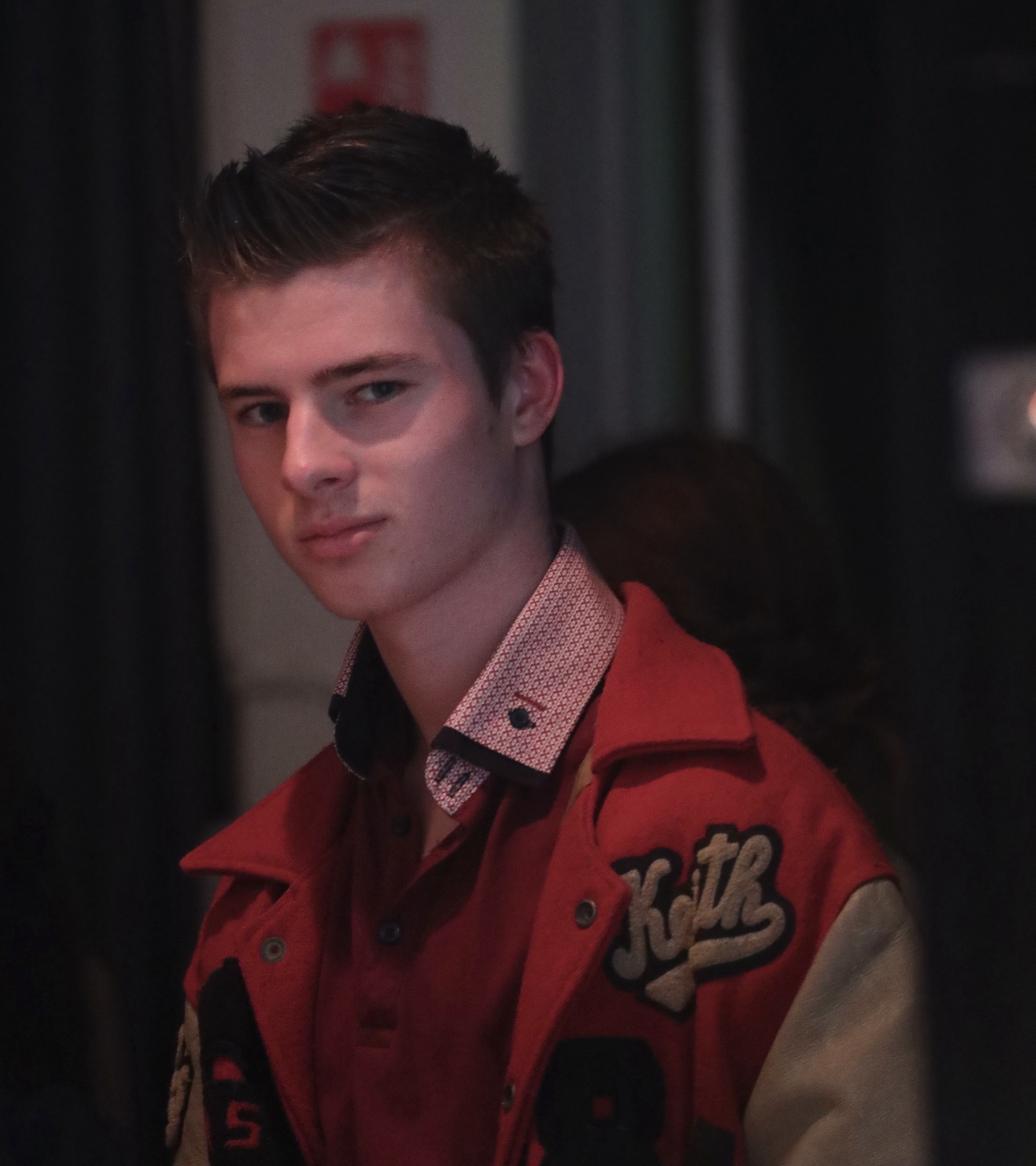 📷
Me with my hair and makeup done and in my Footloose costume
📷
Me with my hair and makeup done and in my Footloose costumeAs we lined up on stage undergoing our sound check, I began to get quite nervous. I wasn't nervous about the acting or the dancing, but the singing. I had never sang infront of an audience before on my own, and I was singing extremely high in my range. My song was also the first solo of the show, which is good because it meant that I would get it out of the way and put an end to my nervousness quite quickly, but also gave me the pressure of being the person to set the standard for the show. But time doesn't wait for anyone. We all gathered backstage, some people shaking with excitement, others shaking with fear. Behind the thin stage walls, an echo chamber of audience members' chatter could be heard. It certainly sounded like there were a lot of people in the auditorium. Then the chatter stops and all falls silent. The silence only broken by the welcoming of the headteacher. This was it. The show was about to begin. I was so nervous yet so excited. As the headteacher wraps up and the audience put their hands together, we all huddled in the wings waiting for the music to start. And there it was, the conductor had waved her wand and the musicians began to play. There was no going back now. People slowly trickled out onto the stage in the opening number, "On Any Sunday". Every member of the show, including myself was present in this number. I was one of the last to go on, and when I did go on, my nerves were not calmed. The audience was large but lively. Before I knew it, the opening was done, and it was my time to shine. I paced around in the wings trying to calm myself, taking deep breaths as I did, until the stage lights flickered on and I had to perform. I walked out like a semi-drunken stud with my cigarette in hand and the audience couldn't stop laughing at me. Their laughter actually helped to calm my nerves somewhat as I had wanted to play Chuck as a fool. I did my acting scene, and then it was straight into my song. Once I got going, my nerves dissapeared, and I sang and danced my heart out. It all went brilliantly and the audience absolutely loved it, laughing at my character profusely. We really did set the standard for the whole show, as once we had finished and gone backstage to reunite with the rest of the cast, we were bombareded with congratulations from our overjoyed cast members. Our performance had induced high morale amongst the whole cast and we were all so proud of ourselves. As the show continued, nothing really could have gone better, I acted, sang and danced my heart out. The audience hosently just could not stop laughing at this character I had developed. The show was a complete success and feedback was overwhelmingly positive. However, that was just one show out of my eight. My family would be at my next show - inflicting another factor of nervousness in me. I am pleased to say that all of the shows went really well. I did however lose my voice on the weekend and week after, but it was totally worth it!
Aftermath
One of my other interests is photography. My photography was used in the newspaper reports and in the Footloose programmes. I also made a cute little memory video with my photos:
We also had reviews from top critics at the Somerset Fellowship of Drama who said about me:
"At this performance you demonstrated just the right amount of swagger in the role of gang leader. Your distain for the young upstart Ren, who almost inadvertently steals your girlfriend was well expressed both in body language and facial expression. Chuck is a character who treats women without respect and expects them to love him for it..... not an acceptable attitude in the current era, but not unusual 40 years ago. Great bass singing too" - Jadi Carlyon SFD Adjudicator
"What a unique character Chuck is within the show. Probably the only character who does not endear himself to the audience. Sam had the swagger, appropriate level of aggression and the rich vocal tones to make Chuck rather sinister and threatening without having to exert physical aggression to any large degree. A bit of a James Dean lookalike that was perfect. I hope Sam isn't like this in real life!" - Andy Marchant SFD Adjudicator
Watch the full show:
Act 1
Reflections
My time in the musical was not only extremely fun, but also a chance to develop a wide variety of skills:
Character Analysis and Creativity:
I developed a deep understanding of my character, Chuck Cranston, through thorough script analysis and creating a "character report." This helped me to improve my analytical and creative thinking, which are essential qualities for storytelling and problem-solving in various contexts.
Time Management and Commitment:
I committed to regular rehearsals and managed multiple responsibilities, including singing, dancing, and acting in all performances across both casts. This made me more effective at time management and dedication to achieving long-term goals.
Collaboration and Leadership:
By organising additional rehearsals and working with others, I displayed teamwork and leadership.
Adaptability and Resilience:
I adapted to new challenges, like learning a Southern accent and dancing for the first time, demonstrating flexibility. Even after setbacks during rehearsals, I persisted and improved through hard work and practice.
Vocal and Physical Performance Skills:
I expanded myv vocal range and tackled singing solo for the first time, along with learning to dance. These physical and vocal skills not only improved my stage presence but also built confidence in public speaking and body coordination.
Confidence and Overcoming Fear:
I overcame my stage fright, especially when singing in front of an audience for the first time, aiding in my personal growth, courage, and the ability to face challenging situations head-on.
Things I could improve for my next production of "Legally Blonde":
Handling Unexpected Situations:
There were a few moments when I anticipated lines from my castmates that were either delayed or missed entirely. In those instances, I froze up, awkwardly making it obvious that I was waiting for something to happen, which meant that my performance was not natural in these moments. To improve, I need to stay in character during these moments, reacting naturally to maintain the flow of the scene, even if things don't go as planned. Learning to improvise and keep the momentum going will help make the performance feel seamless and authentic.
Maintaining the Accent While Singing:
While I had worked hard on perfecting my accent for the dialogue, I noticed that it tended to slip when I started singing. For future productions, I’ll focus on maintaining consistency in the accent, both in speech and song. This could be achieved through more vocal exercises that integrate both singing and speaking in the accent, so it becomes second nature.
I Won a Competition
23/05/2024
Sports day is designed to celebrate the most sporty of students. But what is there to celebrate us creatives?
The solution to this problem was put forth by a former art teacher at my
school. His solution: a "Creative Showdown" competition. A competition that challenges
students to show off their creativity through a series of sub-competitions for each
subject on offer at the school. For example, for English there was a poetry competition,
for maths there was a rangoli pattern competition, for drama there was a performance of
a monologue competition, and for music there was a recorded composition competition.
Students have several months to work on their entries, before they are submitted, judged
by subject staff, and then displayed in a grand exhibition at the school. There is also
an awards ceremony to celebrate the winners and runners up of each year group.
This year, I enterred into many of the categories, one being the music category. I
enterred a recording of myself signing Harry Styles' "Falling". To my surprise, I was
announced as the winner of the competition for year 11!
Listen to my entry:

